user manual
Bluebird
Model name:PB10
Copyright Information
Microsoft, ActiveSync, Outlook, Pocket Outlook, Windows, Windows NT, and the Windows logo are
either registered trademarks or trademarks of Microsoft Corporation in the United States and/or other
countries. Microsoft products are licensed to OEMs by Microsoft Licensing, Inc., a wholly owned
subsidiary of Microsoft Corporation.
Table of Contents
COPYRIGHT INFORMATION....................................................................................... II
TABLE OF CONTENTS.................................................................................................. I
CHAPTER 1: GETTING STARTED..............................................................................1
CHAPTER 2: BASIC SKILLS........................................................................................4
CHAPTER 3: MICROSOFT ACTIVESYNC...............................................................37
CHAPTER 4: MICROSOFT POCKET OUTLOOK...................................................38
CHAPTER 5: COMPANION PROGRAMS ................................................................52
CHAPTER 6: POCKET INTERNET EXPLORER.....................................................70
CHAPTER 7: GETTING CONNECTED .....................................................................75
APPENDIX A: CHARACTER RECOGNIZER...........................................................81
APPENDIX B: TROUBLESHOOTING.......................................................................83
APPENDIX C: REGULATORY NOTICES.................................................................90
APPENDIX D: HARDWARE SPECIFICATIONS.....................................................93
APPENDIX E: CF CARDS ...........................................................................................94
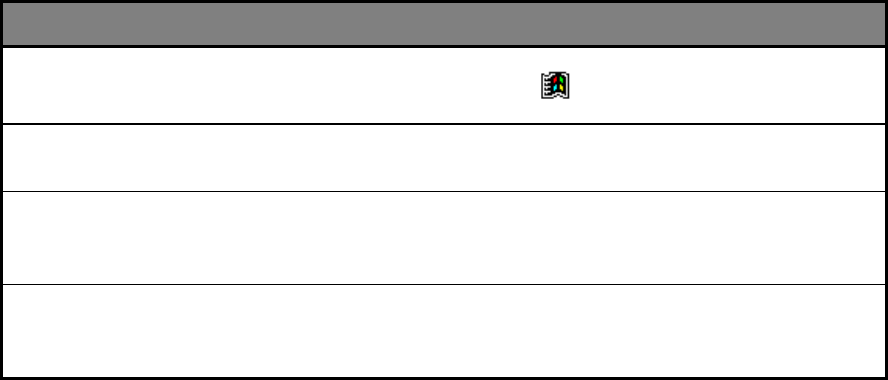
Bluebird User’s Guide 1
Chapter 1: Getting Started
Welcome
Congratulations on purchasing a Bluebird. Due to the size and capabilities of the Bluebird, you
can keep your most important business and personal information up-to-date and close at hand.
Microsoft ActiveSync increases the power of your Bluebird by allowing you to synchronize the
information on your desktop or laptop computer with your Bluebird. Picture yourself in the
following situations:
• While walking with a colleague, your cell phone rings and the boss asks if you two are free
this afternoon for an emergency meeting. While your colleague fumbles through his paper
organizer, you press a button on your Bluebird and instantly see a list of today’s
appointments and meetings. You are quickly able to tell the boss your available times. For
more information on scheduling appointments and meetings, see Chapter 4.
• You’re meeting your friends tonight for dinner and a movie. You download the latest movie
information from the Internet to your desktop computer and then synchronize it with your
Bluebird. At dinner, you pull out your Bluebird and review your movie options with your
friends. For more information on downloading Web pages to your Bluebird, see Chapter 6.
• A Calendar reminder alerts you that it is time to catch the bus. You grab your Bluebird and
catch the bus just in time. Because ActiveSync keeps the information on your Bluebird up-to-
date, you leisurely review your task list, make notes about the new books and CDs you want
to buy, and read and respond to e-mail messages. When you get back to the office,
ActiveSync transfers any task changes you made, your notes, and your e-mail message
responses to your desktop computer. For more information on ActiveSync, see Chapter 3.
Where to Find Information
This book describes your Bluebird hardware, provides an overview of the programs on your
Bluebird, and explains how to connect your Bluebird to a desktop computer, a network, or the
Internet. For instructions on setting up your Bluebird, see the Quick Start Card. For instructions
on installing ActiveSync, see the booklet accompanying the ActiveSync CD. The following table
is a guide to additional information to help you use your Bluebird.
For information on: See this source:
Programs on your Bluebird This User’s Guide and device Help. To view
Help, tap and then Help.
Additional programs that can be installed on
Bluebird The Extras folder, located on the ActiveSync
CD.
Connecting to and synchronizing with a
desktop computer The ActiveSync booklet or ActiveSync Help
on your desktop computer. To view Help, click
Help and then Microsoft ActiveSync Help.
Last-minute updates and detailed technical
information The Read Me files, located in the Microsoft
ActiveSync folder on the desktop computer and
on the ActiveSync CD.

Bluebird User’s Guide 2
Up-to-date information on Windows-
powered devices http://www.microsoft.com/windowsce/
How to Transfer Pocket PC Data
If you are currently using a Palm-size PC and want to transfer your data to your Bluebird, follow
this upgrade procedure:
1. Install Microsoft ActiveSync 3.1 on your desktop computer. For information on installing
ActiveSync, see the booklet accompanying the ActiveSync CD.
2. Synchronize your Bluebird with your desktop computer so that the information on your
desktop computer is current.
3. If you have files on your Palm-size PC that you want to transfer, such as Note Taker notes
and recordings, turn file conversion off in ActiveSync options so that the files stay in device
format, and use the ActiveSync Explorer to copy the files to your desktop computer. For
specific instructions, see ActiveSync Help on the desktop computer.
4. Synchronize your Bluebird with your desktop computer. This will update your Bluebird using
the current data on your desktop computer (step 2).
5. Reinstall programs. Check whether new versions that have been optimized for the Pocket PC
are available.
6. Using the ActiveSync Explorer, copy the files you transferred to your desktop computer in
step 3 to your Bluebird.
7. In ActiveSync, turn file conversion on again.
8. Enter your settings and connection information on the Bluebird.
If you have offline folders in Inbox on your Palm-size PC that contain e-mail messages you want
to transfer to your Bluebird, follow this procedure:
1. Connect your Bluebird to your desktop computer and then click Windows CE Inbox
Transfer on the Microsoft Outlook Tools menu.
2. Select Copy or move selected messages to your desktop computer and then click the
Browse button.
3. Select the offline folder that contains the messages you want to transfer to your desktop
computer and then click OK.
4. Click the Transfer button and select the folder you want to transfer the messages to or click
New Folder to create a new folder. Click OK to transfer the messages. Now you must
transfer the messages from your desktop computer to your Bluebird.
5. In Inbox on your Bluebird, tap Tools and then New Folder and create a folder for the
messages you are going to transfer.
6. In Outlook on your desktop computer, select the messages you want to transfer.
Bluebird User’s Guide 3
7. Connect your Bluebird to your desktop computer and then click Windows CE Inbox
Transfer on the Outlook Tools menu.
8. Select Copy selected messages to your Bluebird and then click the Browse button.
9. Select the offline folder on your Bluebird you want to transfer the messages to and then click
OK.
10. Click the Transfer button. The selected messages are moved to your Bluebird.
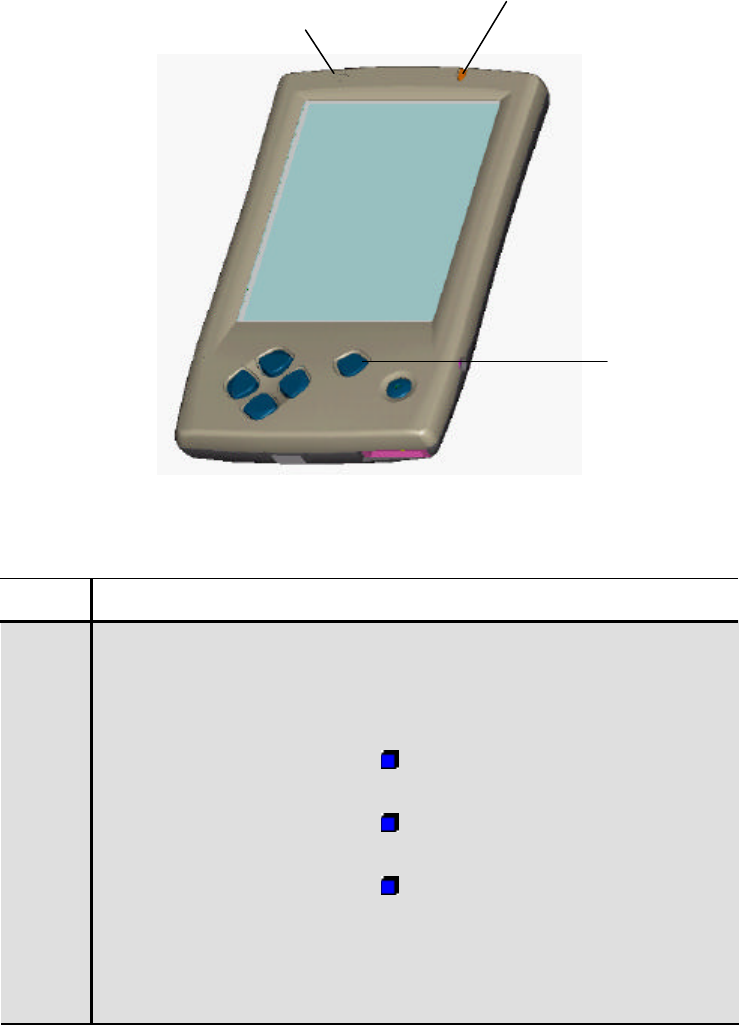
Bluebird User’s Guide 4
Chapter 2: Basic Skills
Learning to use your Bluebird is easy. This chapter describes the basic concepts of using
and customizing your Bluebird.
Front Panel Components
Front Side
Item Component Function
Ê Battery Charge and
Alarm Light The indicator light on the top
of the device serves as both a
battery charge indicator and a
visual alarm indicator.
Flashing green: Notification
alarm signal.
Flashing amber: Battery is
charging.
Solid amber: Battery is fully
charged.
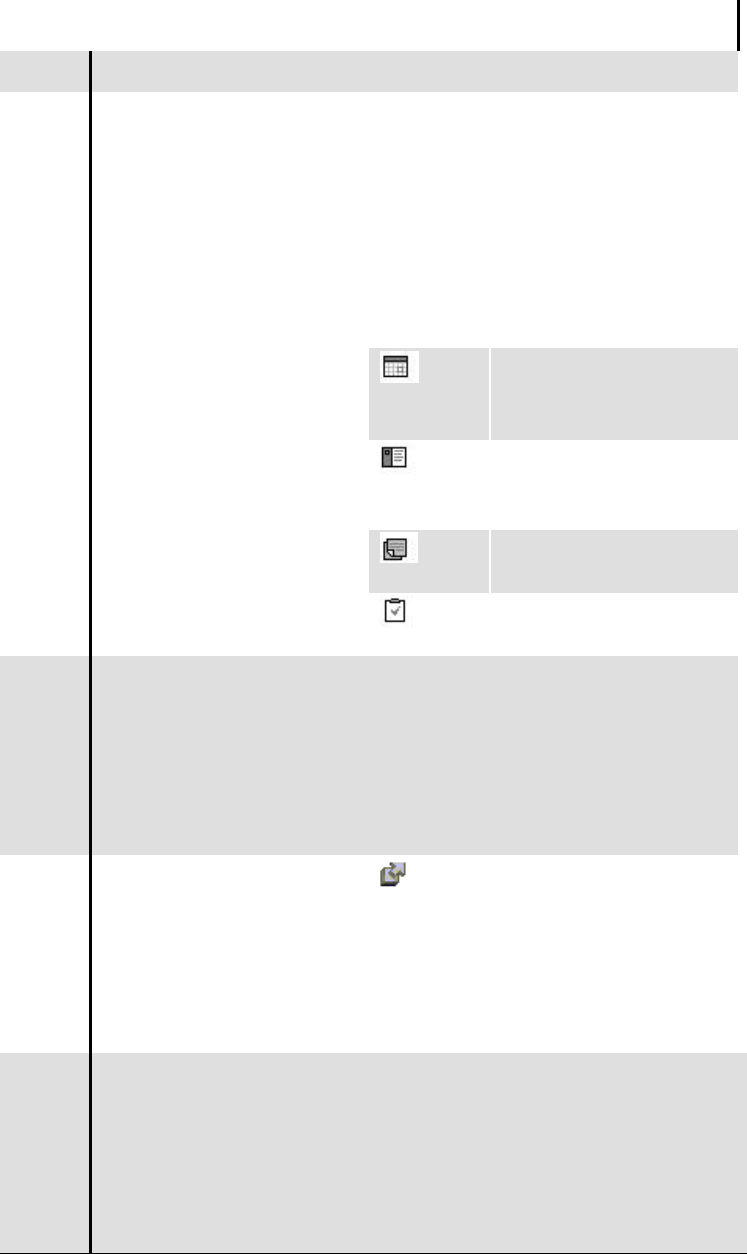
Bluebird User’s Guide 5
Front Side Components Continued
Item Component Function
The program buttons on the
front panel of the device are
used to open some of the
most frequently used
applications. You can change
the shortcuts of the program
buttons so that they open
different applications. For
more information, see .
Opens the
Calendar
application.
Opens the
Contacts
application.
Opens the Notes
application.
Ë
Program Buttons
Opens the Tasks
application.
Ì
Power Button
The Power button is used to
turn on and off your device.
Press and release the button
to turn on or off the device.
Í
Easy Online Go straight to the Easy
Online application; connect to
the Internet immediately.
Î
Microphone The small hole at the top of the
device is the microphone for
the built-in Voice Recorder.
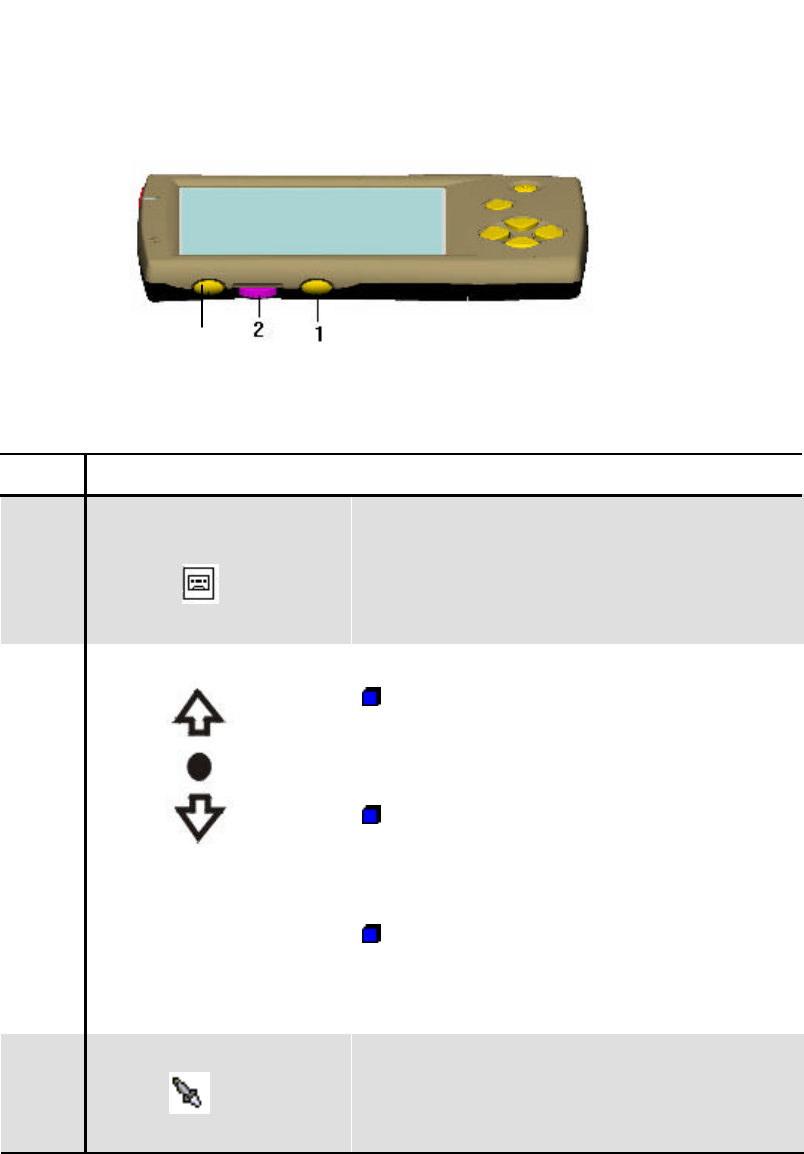
Bluebird User’s Guide 6
Left side Components
Left Side
Item Component Function
Ê Voice Recorder
Button
You can record brief notes and
messages by speaking into the built-in
microphone while holding down the
voice recorder button. For more
information, see Chapter 7
Ë Scroll/Action Button
This is a wheel with three functions.
Rotate the dial up to scroll upwards
from right to left through DeskTop,
or to scroll up while you are using an
application.
Rotate the dial down to scroll
downwards from left to right through
DeskTop, or to scroll down while you
are using an application.
Press the center of the dial to use it
as an action button, much like the
Enter key on a full-sized PC
keyboard.
3 DeskTop Button
Press to go quickly to a screen of your
most essential programs, and to access
the System Manager and Screen
Rotation applications.
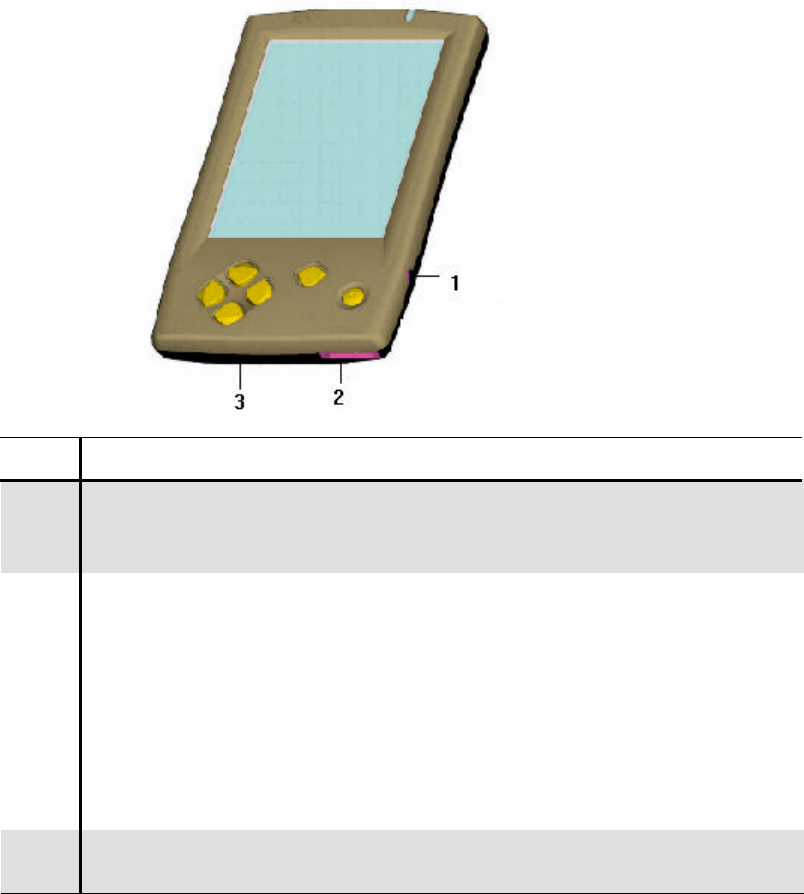
Bluebird User’s Guide 7
Bottom and Right Edge Components
Item Component Function
Ê DC Jack The DC jack allows you to connect to
external power with the supplied AC
adapter.
Ë Communications
Port The communications port establishes a
connection with the serial port of your
desktop PC. You can connect the
Bluebird to a PC by using a USB or
RS232 cradle, or an auto-sync cable.
For information on using the
communications port to establish a
connection to a PC, see ActiveSync
Help on your desktop computer.
Ì Battery Cover
Release Press and push up to access the main
battery.
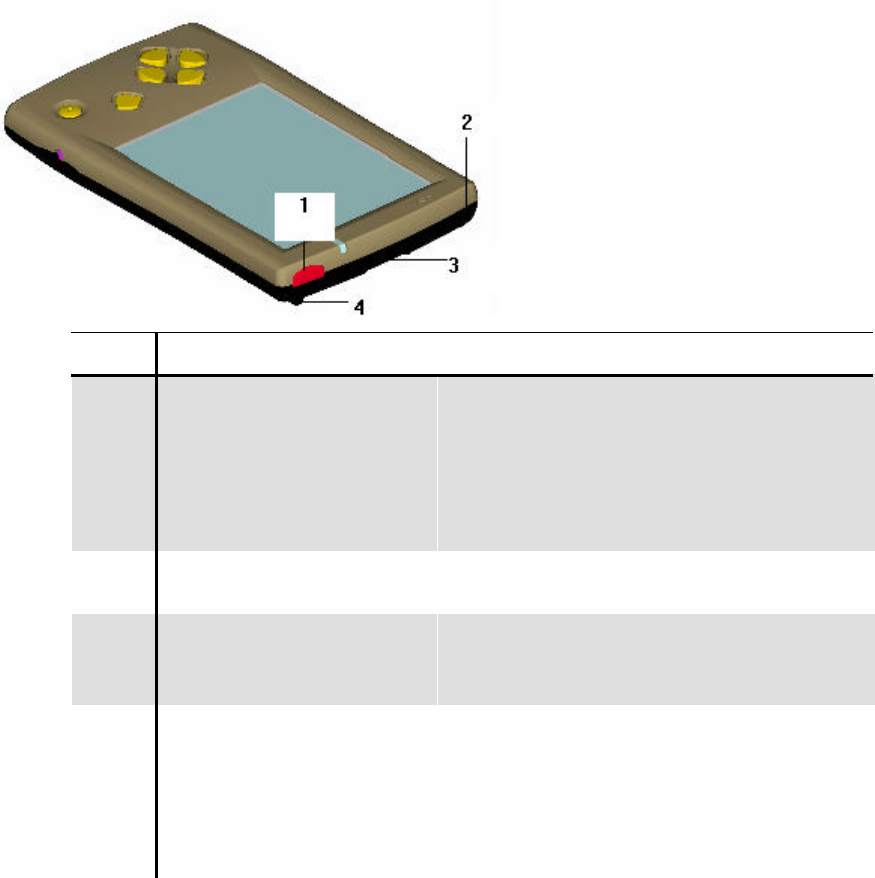
Bluebird User’s Guide 8
Top Edge Components
Item Component Function
Ê Infrared Port You can use the infrared port to
exchange data with other infrared-
equipped devices. The infrared port
can transmit at speeds up to 115 Kb
per second. For more information, see
chapter 7.
Ë Audio Jack The audio jack lets you connect an
earplug to your Bandicoot.
Ì CompactFlash Card
Slot The CompactFlash slot is protected by
a removable cover. The slot supports
Type I CompactFlash cards.
Í Stylus and Stylus
Compartment The stylus compartment stores the
stylus when it’s not in use. Pull the
stylus up to release it from the
compartment. When you are finished
using the stylus, insert it back into the
compartment and gently press it down.
Back Components
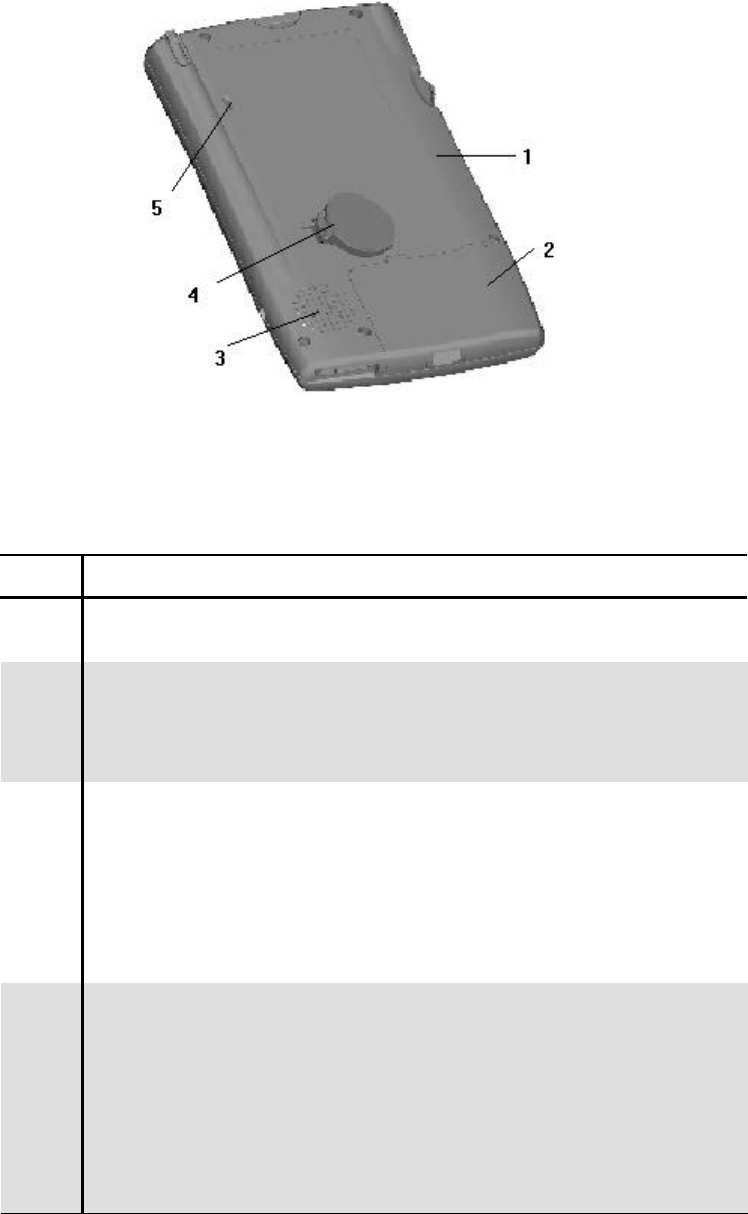
Bluebird User’s Guide 9
Item Component Function
Ê Battery
Compartment The battery compartment holds
the rechargeable battery pack.
Ë Speaker The system sounds alarms and
plays back sound recordings
through this speaker.
Ì Backup Battery
Cover Release
Button
The Backup Battery Cover
Release button is recessed inside
the case of the device. This button
allows you to access the backup
battery. To pop open the backup
battery compartment, use the tip
of the stylus
Í Reset Button The Reset button is recessed
inside the case of the device.
Occasionally, some hardware or
software malfunctions can prevent
the device from responding. To
get the device working again, use
the tip of the stylus to press the
Reset button.
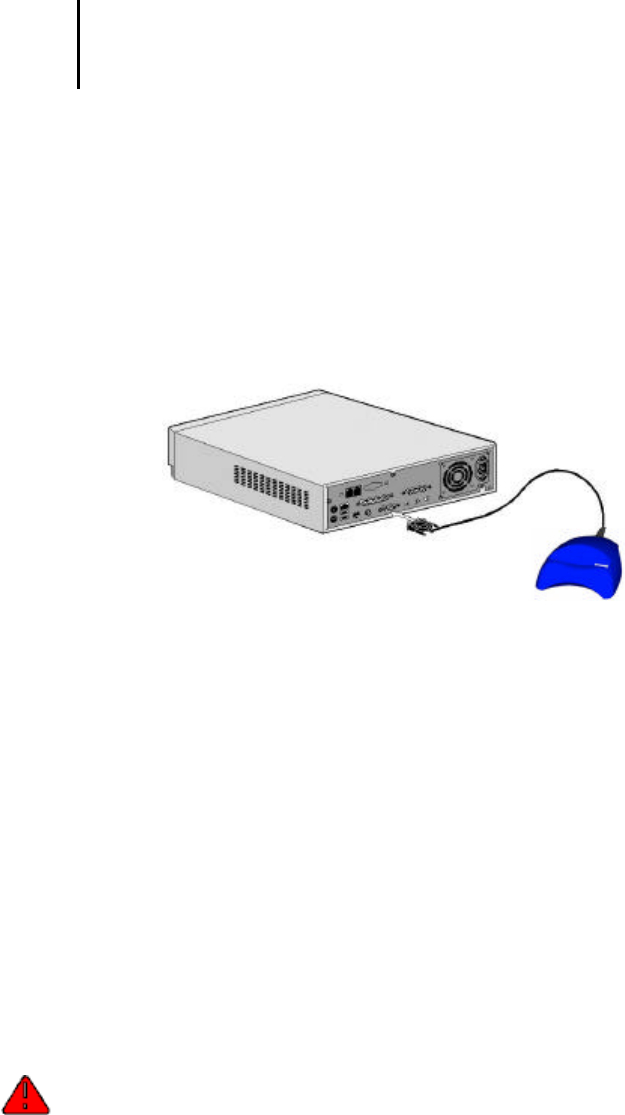
Bluebird User’s Guide 10
USB Cradle and AC Adapter
Your Bluebird comes with either a USB or RS232 cradle, and AC adapter. This allows you to
recharge your Bluebird, as well as synchronize the information between your Bluebird and a
computer using ActiveSync. For more information on synchronization, see ActiveSync Help on
your computer.
The USB Cradle must be plugged into an available USB port on the back of your computer.
Recharging the Battery
Your Bluebird contains a rechargeable Lithium Ion battery that is recharged each time you place
your Bluebird in the cradle and connect the cradle to an external power source with the AC
adapter. Just place your Bluebird in the cradle for three to four hours for an initial charge before
you use it the first time. Then, place it in the cradle for a short time each day to recharge the
battery to its full capacity.
You can also use the AC adapter to connect your Bluebird directly to the external power source.
Battery Warning
WARNING: Your computer contains a lithium-ion battery pack.
There is a risk of fire and burns if the battery pack is handled
improperly. Do not disassemble, crush, puncture, short external
contacts, or dispose of in fire or water. Do not attempt to open or
service the battery pack. Replace only with the battery pack
designated for this product. Discard used batteries according to the
manufacturer's instructions.
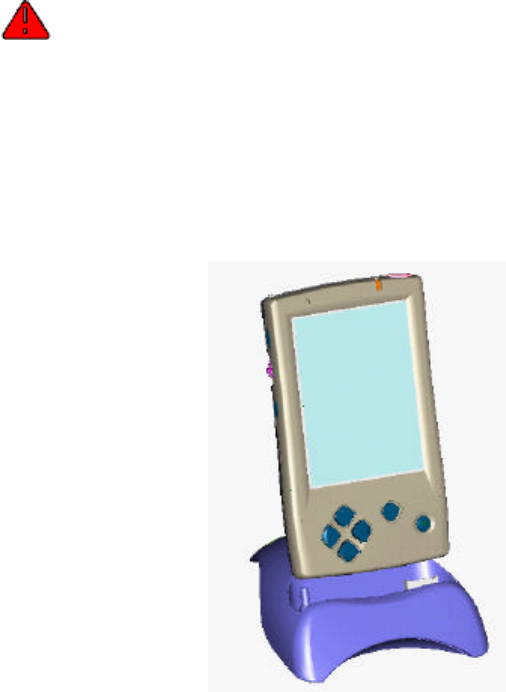
Bluebird User’s Guide 11
WARNING: Your computer contains a coin-cell lithium battery.
There is a danger of explosion and risk of personal injury if the
battery is incorrectly replaced or mistreated. Do not attempt to
recharge the battery, disassemble it, or immerse it in water or
dispose of in fire. Replace only with the battery designated for this
product. Discard used batteries according to the manufacturer's
instructions.
If the battery gets very low, your Bluebird displays a warning message. If this occurs, save any
unsaved data you are working on, perform a synchronization with your computer, then turn off
your Bluebird If your Bluebird does shut down, you still have about 40 hours to recharge the
battery before you lose the data on your Bluebird.
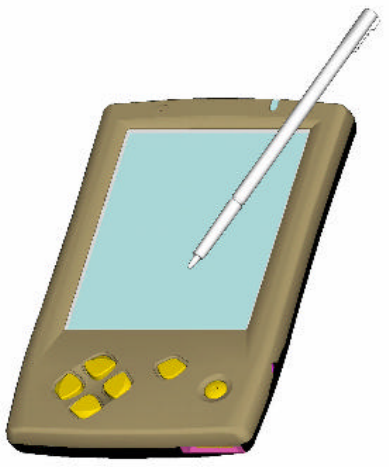
Bluebird User’s Guide 12
Bluebird Buttons and the Stylus
Your Bluebird has hardware buttons that control actions and scroll functions, and a stylus
for selecting items and entering information.
The Stylus
Your Bluebird has a stylus for selecting items and entering information. To use the stylus, push
the stylus up with your thumb, then pull the stylus upwards out of its compartment. To replace the
stylus, just insert it back into the compartment, then push it until it is in place.
The following actions are available with the stylus:
Tap. Touch the screen once with the stylus to open items and select options.
Drag. Hold the stylus on the screen and drag across the screen to select text and images. Drag
within a list to select multiple items.
Tap-and-hold. Tap and hold the stylus on an item to see a list of actions available for that item.
Tap the action you want to perform on the pop-up menu that appears.
The stylus tip can also be used to press the reset button or set the On/Off switch.
Scroll/Action Button
The Scroll/Action button is situated next to DeskTop, allowing you to scroll through and select
essential programs from DeskTop – all with one hand.
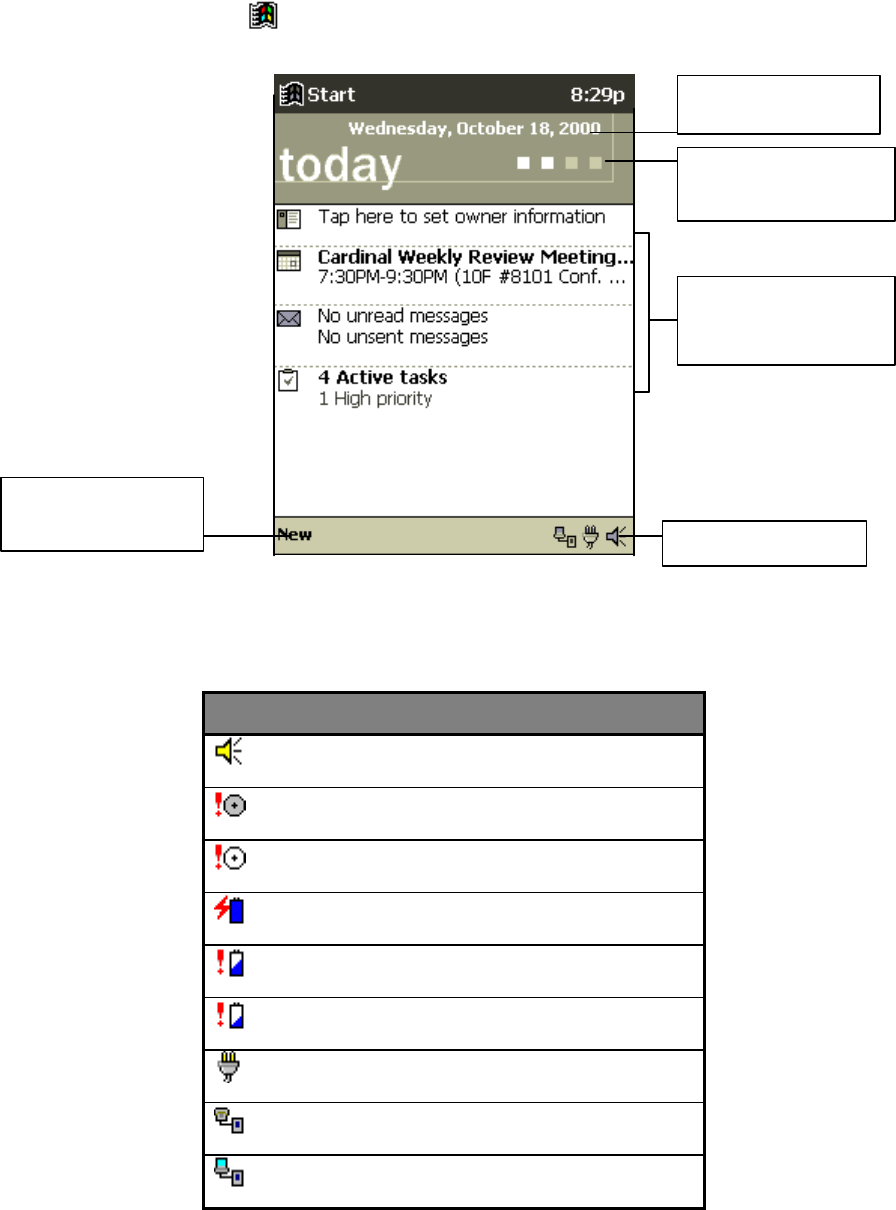
Bluebird User’s Guide 13
Today Screen
When you turn on your Bluebird for the first time each day, you’ll see the Today screen. You can
also display it by tapping and then Today. On the Today screen, you can see at a glance
important information for the day.
You may see the following status icons on the command bar.
Status Icon Meaning
Turns all sounds on and off
Backup battery is low
Backup battery is very low
Main batteries are charging
Main batteries are low
Main batteries are very low
External (AC) power source is connected
Dial-up connection is active
Direct connection is active
Tap here to adjust
date and time.
Tap here to set or
change the display.
Tap here to select and
open a program.
Status Icons
Tap here to start a
new item.
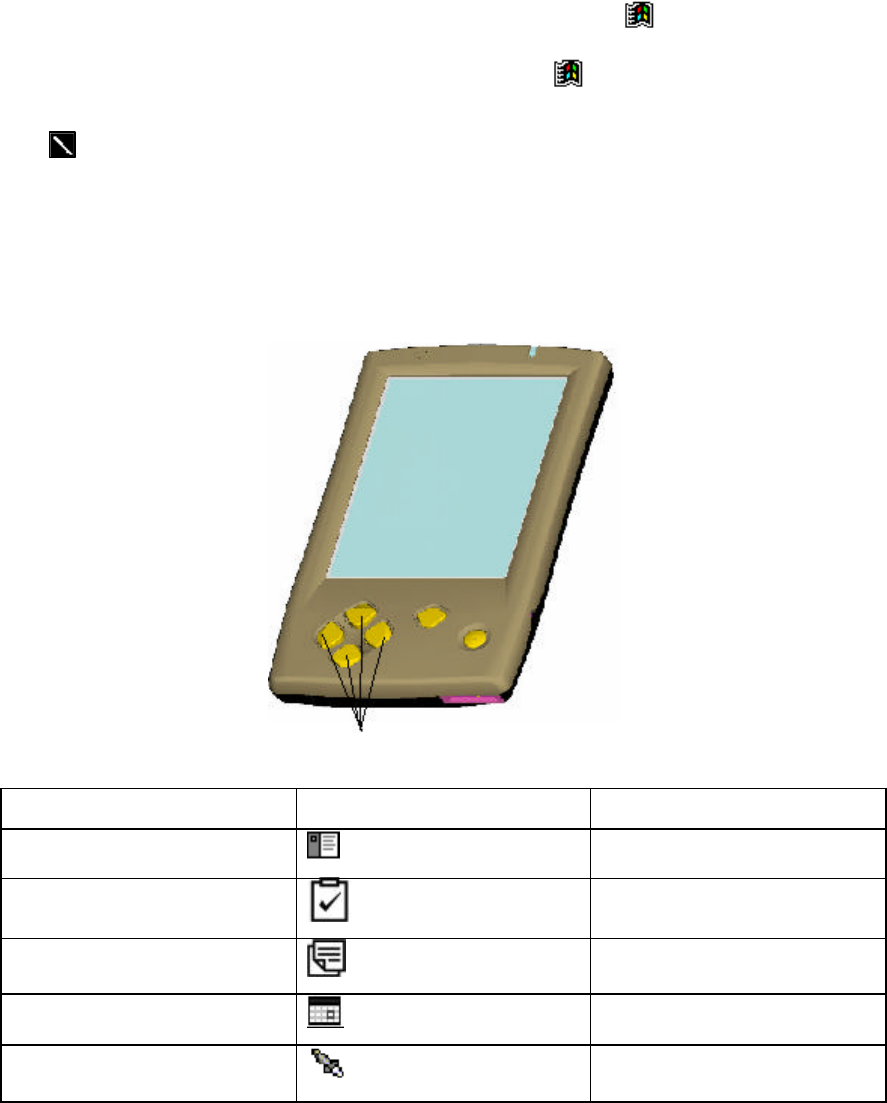
Bluebird User’s Guide 14
Programs
You can switch from one program to another by selecting it from the menu. (You can
customize which programs you see on this menu. For information, see “Adjusting Settings,” later
in this chapter.) To access some programs, you’ll need to tap , Programs, and then the
program name.
Some programs have abbreviated labels for check boxes and drop-
down menus. To see the full spelling of an abbreviated label, tap
and hold the stylus on the label. Drag the stylus off the label so
that the command is not carried out.
You can also switch to some programs by pressing a program button. Your device has one or
more program buttons located on the front or side of the device. The icons on the buttons identify
the programs they switch to.
Item Icon Program
1. Microsoft Contact
2.
Microsoft Task
3. Microsoft Note taker
4. Microsoft Calendar
5. HTC Desktop
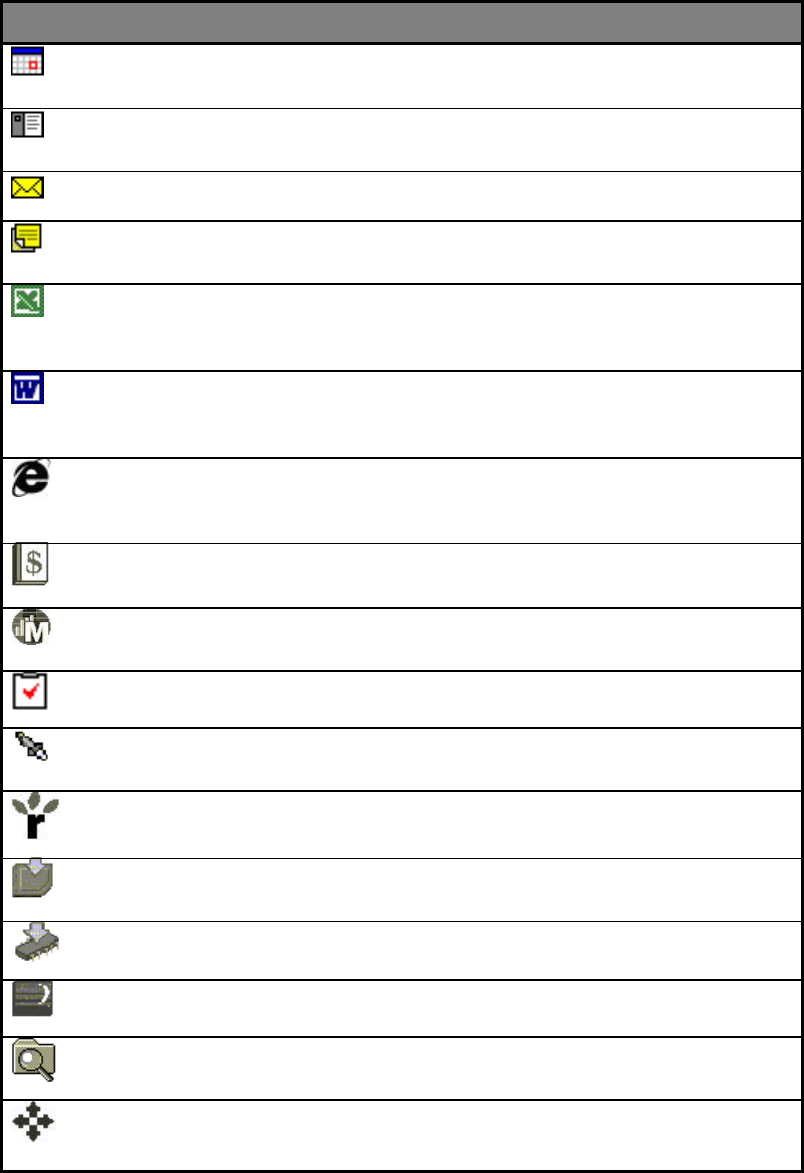
Bluebird User’s Guide 15
The following table contains a partial list of programs that are on your Bluebird. Look in the
Extras folder on the ActiveSync CD for additional programs that you can install onto your device.
Icon Program Description
Calendar Keep track of your appointments and
create meeting requests.
Contacts Keep track of your friends and
colleagues.
Inbox Send and receive e-mail messages.
Notes Create handwritten or typed notes,
drawings, and recordings.
Pocket Excel Create new workbooks or view and edit
Excel workbooks created on your
desktop computer.
Pocket Word Create new documents or view and edit
Word documents created on your
desktop computer.
Internet Explorer View Web pages downloaded from
your computer or connect to an ISP and
browse the Web.
Daily Account Enter and view transactions and check
on your expenditure.
Microsoft Money Microsoft’s sophisticated money
management program.
Tasks Keep track of your tasks.
HTC DeskTop Helps you to manage and move
between programs.
Microsoft Reader Download and read books.
CF Backup Backup the files on your Bluebird to a
CF card.
RT Backup Backs up contacts to flash ROM.
Power Saving Helps reduce power consumption.
File Explorer Use to find a file or program on your
Bluebird.
Game Keys Enable this function to use the
application buttons as left/right,
up/down buttons – and the start button
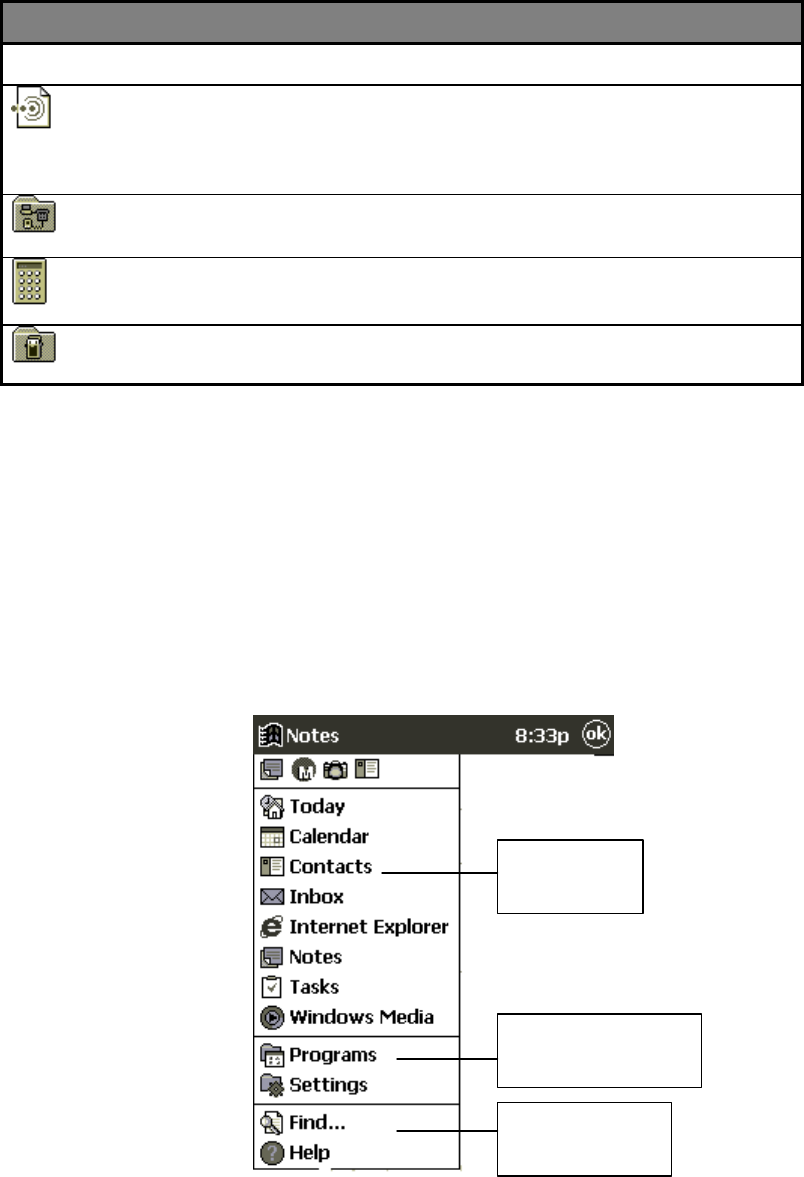
Bluebird User’s Guide 16
Icon Program Description
to fire.
Infrared Receive Use to exchange Contacts information
with another Bluebird, synchronize with
your desktop PC or get online via your
mobile phone.
Connections Go here to access all the connections set
up on your Bluebird.
Calculator Use to solve those numerical problems.
Games Contained inside is the game Soltaire.
Navigation Bar and Command Bar
The navigation bar is located at the top of the screen. It displays the active program and current
time, and allows you to switch to programs and close screens.
Use the command bar at the bottom of the screen to perform tasks in programs. The command bar
includes menu names, buttons, and the input panel button. To create a new item in the current
program, tap New. To see the name of a button, tap and hold the stylus on the button. Drag the
stylus off the button so that the command is not carried out.
Tap to select
a program
Tap to see additional
programs
Tap to customize
your device
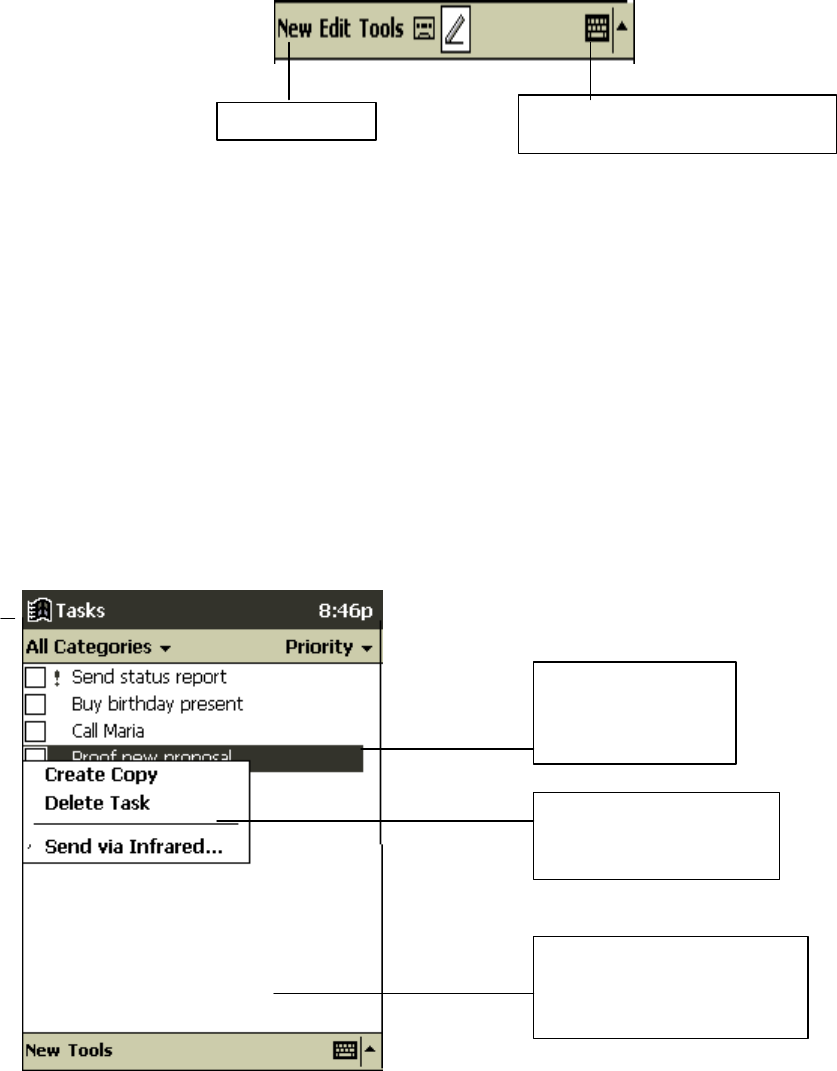
Bluebird User’s Guide 17
Pop-up Menus
With pop-up menus, you can quickly choose an action for an item. For example, you can use the
pop-up menu in the contact list to quickly delete a contact, make a copy of a contact, or send an e-
mail message to a contact. The actions in the pop-up menus vary from program to program. To
access a pop-up menu, tap and hold the stylus on the item name that you want to perform the
action on. When the menu appears, lift the stylus, and tap the action you want to perform. Or tap
anywhere outside the menu to close the menu without performing an action.
New Button
Tap and hold to
display the pop-up
menu
Lift the stylus and tap the
action you want
Tap in the space to close the
menu without performing an
action
Tap to choose your input method

Bluebird User’s Guide 18
Notifications
Your Bluebird reminds you in a variety of ways when you have something to do. For example, if
you’ve set up an appointment in Calendar, a task with a due date in Tasks, or an alarm in Clock,
• A message box appears on the screen.
• A sound, which you can specify, is played.
• A light flashes on your device.
To choose reminder types and sounds for your Bluebird, tap and then Settings. In the
Personal tab, tap Sounds & Reminders . The options you choose here apply throughout the
device.
Enter Information on Your Bluebird
You have several options for entering new information:
• Use the input panel to enter typed text, either by using the English or Chinese soft keyboard,
Chiang Jieh or Character Recognizer.
• Write directly on the screen.
• Draw pictures on the screen.
• Speak into your device microphone to record a message.
• Use ActiveSync to synchronize or copy information from your desktop computer to your
Bluebird. For more information on ActiveSync, see the booklet accompanying the
ActiveSync CD or ActiveSync Help on your desktop computer.
Typing Using the Input Panel
Use the input panel to enter information in any program on your Bluebird. You can type using the
soft keyboard, or write using Character Recognizer. In either case, the characters appear as typed
text on the screen.
To show or hide the input panel, tap the Input Panel button. Tap the arrow next to the Input
Panel button to see your choices.
Select an
input
method
Input Panel symbol
for Keyboard
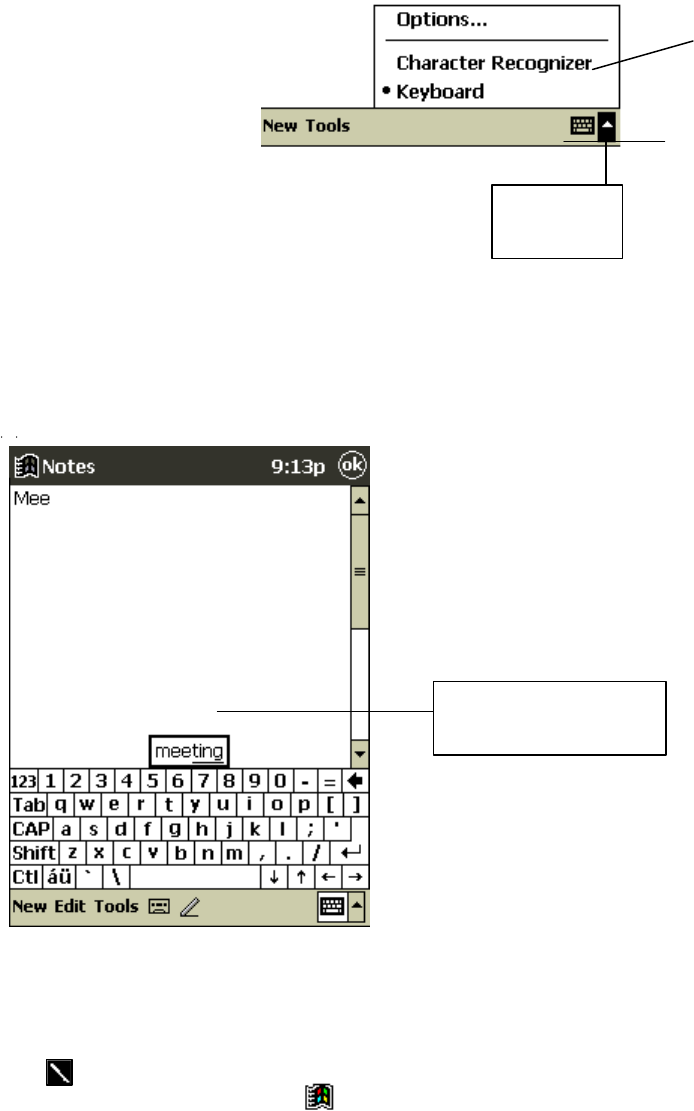
Bluebird User’s Guide 19
When you use the input panel, your Bluebird anticipates the word you are typing or writing and displays it
above the input panel. When you tap the displayed word, it is inserted into your text at the insertion point.
The more you use your Bluebird, the more words it learns to anticipate.
To change word suggestion options, such as the number of words
suggested at one time, tap , Settings, Personal tab, Input, and then
the Word Completion tab.
To type with the soft keyboard:
1. Tap the arrow next to the Input Panel button and then Keyboard.
2. On the soft keyboard that is displayed, tap the keys with your stylus.
Tap to see
choices
Tap here if the word is
right.
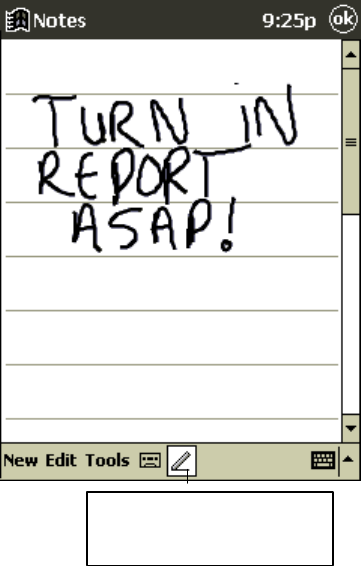
Bluebird User’s Guide 20
To use Character Recognizer:
1. Tap the arrow next to the Input Panel button and then Character Recognizer.
2. Write a letter in the box in Chinese or English. There are two boxes so you can write another
character or letter while you wait for the first to be interpreted.
When you write a letter, it is converted to typed text that appears on the screen. For specific
instructions on using Character Recognizer, see Appendix A.
To select typed text:
If you want to edit or format typed text, you must select it first.
• Drag the stylus across the text you want to select.
You can cut, copy, and paste text by tapping and holding the selected words and then tapping an
editing command on the pop-up menu, or by tapping the command on the Edit menu.
Writing on the Screen
In any program that accepts writing, such as the Notes program and the Notes tab in Calendar,
Contacts, and Tasks, you can use your stylus to write directly on the screen. Write the way you do
on paper. When writing English, you can edit and format what you’ve written and convert the
information to text at a later time.
To write on the screen:
• Tap the Pen button to switch to writing mode. This action displays lines on the screen to help
you write.
Tap the pen button and
use your stylus to write

Bluebird User’s Guide 21
Some programs that accept writing may not have the Pen button.
See the documentation for that program to find out how to switch
to writing mode.
To select writing:
If you want to edit or format writing, you must select it first.
1. Tap and hold the stylus next to the text you want to select until the insertion point appears.
2. Without lifting, drag the stylus across the text you want to select.
If you accidentally write on the screen, tap Tools and then Undo and try again. You can also
select text by tapping the Pen button to deselect it and then dragging the stylus across the screen.
You can cut, copy, and paste written text in the same way you work with typed text: tap and hold
the selected words and then tap an editing command on the pop-up menu, or tap the command on
the Edit menu.
Tips for getting good recognition(English):
• Write neatly.
• Write on the lines and draw descenders below the line. Write the cross of the “t” and
apostrophes below the top line so that they are not confused with the word above. Write
periods and commas above the line.
• For better recognition, try increasing the zoom level to 300% using the Tools menu.
• Write the letters of a word closely and leave big gaps between words so that the device can
easily tell where words begin and end.
• Hyphenated words, foreign words that use special characters such as accents, and some
punctuation cannot be converted.
• If you add writing to a word to change it (such as changing a “3” to an “8”) after you attempt
to recognize the word, the writing you add will not be included if you attempt to recognize
the writing again.
Drawing on the Screen
You can draw on the screen in the same way that you write on the screen. The difference between
writing and drawing on the screen is how you select items and how they can be edited. For
example, selected drawings can be resized, while writing cannot.
To create a drawing:
• Cross three ruled lines on your first stroke. A drawing box appears. Subsequent strokes in or
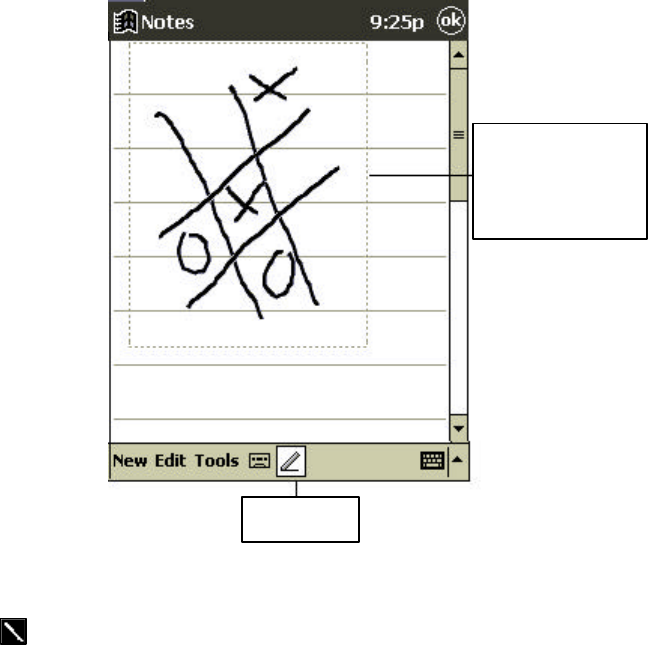
Bluebird User’s Guide 22
touching the drawing box become part of the drawing. Drawings that do not cross three ruled
lines will be treated as writing.
You may want to change the zoom level so that you can more
easily work on or view your drawing. Tap Tools and then a zoom
level.
To select a drawing:
If you want to edit or format a drawing, you must select it first.
• Tap and hold the stylus on the drawing until the selection handle appears. To select multiple
drawings, deselect the Pen button and then drag to select the drawings you want.
You can cut, copy, and paste selected drawings by tapping and holding the selected drawing and
then tapping an editing command on the pop-up menu, or by tapping the command on the Edit
menu. To resize a drawing, make sure the Pen button is not selected and drag a selection handle.
Recording a Message
In any program where you can write or draw on the screen, you can also quickly capture
thoughts, reminders, and phone numbers by recording a message. In the Notes program, you can
either create a stand-alone recording or include a recording in a written note. If you want to
include the recording in a note, open the note first.
The drawing box
indicates the
boundaries of the
drawing
The pen
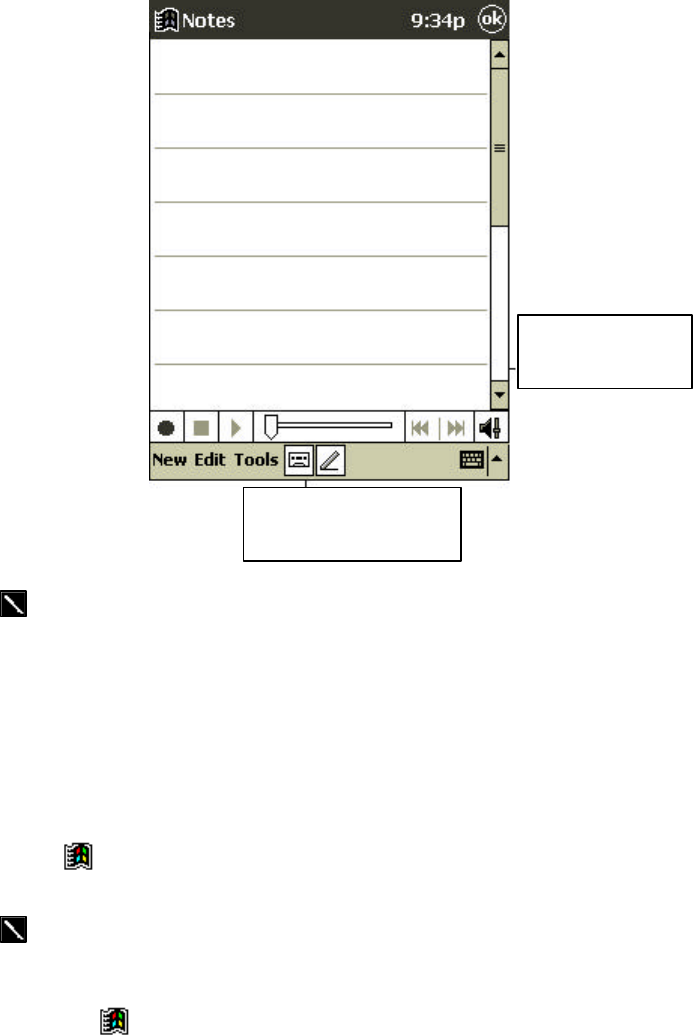
Bluebird User’s Guide 23
To create a recording:
1. Hold your Bluebird’s microphone near your mouth or other source of sound.
2. Press and hold the Record hardware button on your device until you hear a beep.
3. While holding down the Record button, make your recording.
1. To stop recording, release the Record button. Two beeps will sound. The new recording
appears in the note list or as an embedded icon.
You can also make a recording by tapping the Record button on
the Recording toolbar.
To play a recording, tap it in the list or tap its icon in the note.
Find and Organize Information
The Find feature on your Bluebird helps you quickly locate information.
• On the menu, tap Find. Enter the text you want to find, select a data type, and then tap
Go to start the search.
To quickly find information that is taking up storage space on your
device, select Larger than 64 KB in Type.
You can also use the File Explorer to find files on your device and to organize these files into
folders. On the menu, tap Programs, and then File Explorer.
Tap to begin a
recording
Tap to show or hide
the recording toolbar
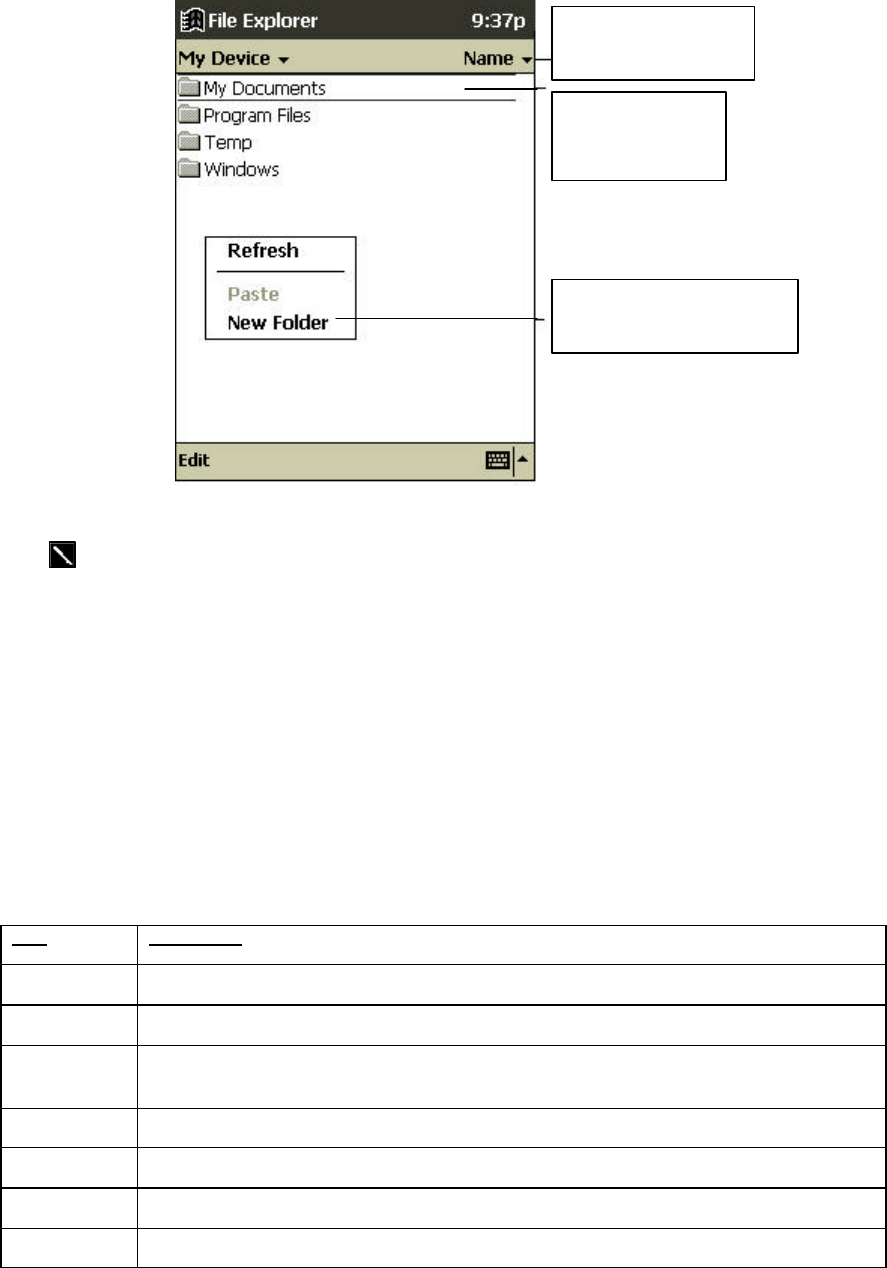
Bluebird User’s Guide 24
You can move files in File Explorer by tapping and holding the
item you want to move and then tapping Cut or Copy and Paste
on the pop-up menu.
Customize Your Bluebird
You can customize your device by adjusting device settings and installing additional software.
Adjusting Settings
You can adjust Bluebird settings to suit the way you work. To see available options, tap, Settings, then the
Personal, System or Connections tab located at the bottom of the screen.
You might wish to do the following:
Item Description
Align Screen Adjust the touch screen if it is not responding accurately.
Backlight Set the length of time before the backlight turns off when the device is idle.
Buttons Associate program buttons with specific programs and adjust the up/down control of the
jog wheel.
Clock Change the time or set alarms.
Input Customize the input method and set word completion settings.
Memory Adjust the allocation of storage and program memory.
Menus Customize what appears on the – menu and enable a pop-up menu from the New button.
Select the sort order
for the list
Tap the folder
name to open it
Tap and hold to create a
new folder
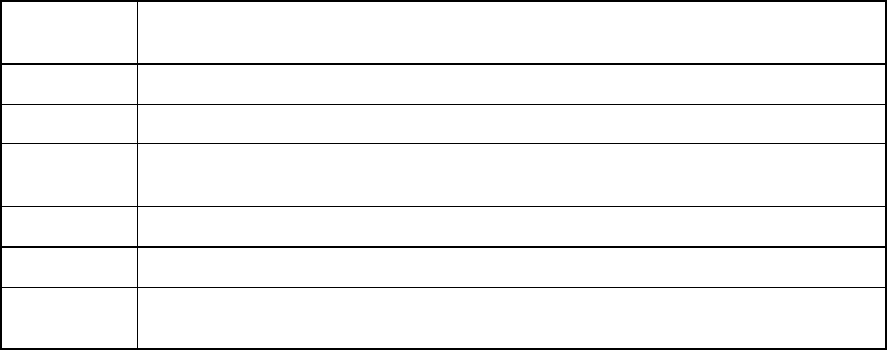
Bluebird User’s Guide 25
Owner
Information Enter your contact information.
Password Limits access to your Bluebird.
Power Saving Maximize battery life.
Sounds and
Reminders Increase the volume; choose to enable sounds for screen taps and notifications; select type
and when to be reminded.
Today Customize the information displayed on the Today screen.
Contrast Adjust the contrast of the screen.
Regional
Settings Adjust for region, numbers, currency, time and date.
Setting a Password
Password security is provided to help protect against unauthorized use of your Bluebird. For
immediate protection, we recommend setting up password security through the Password utility
in the Settings of your Bluebird as soon as possible. If set, your login password must be entered
each time you turn on your Bluebird.
Choose a password that's easy to remember. If you forget it, you must perform a full reset to use
your Bluebird again. A full reset restarts your Bluebird and removes all information that was
stored in memory, such as your data files and your system settings.
To set your login password, follow these steps:
• Tap , Settings, then Password.
• Enter a new 4-digit PIN. This number is now your password.
• Enable the login password by checking the Require password when device is turne d on
box.
• Save your new settings by tapping OK.
Your login password is now set. The login password screen appears each time you turn on
your Bluebird.
Adding or Removing Programs
Programs added to your Bluebird at the factory are stored in ROM (read-only memory). You
cannot remove or modify this software, and you’ll never accidentally lose ROM contents.
Programs and data files added to your Bluebird after factory installation are stored in RAM
(random access memory). You can install any program created for Bluebird, as long as your
Bluebird has enough memory. The most popular place to find software for your Bluebird is on the
World Wide Web.

Bluebird User’s Guide 26
To add programs
You’ll need to install the appropriate software for your Bluebird on your desktop computer before
installing it on your Bluebird.
1. Determine your Bluebird and processor type so that you know which version of the software
to install. Tap and then Settings. On the System tab, tap About. In the Version tab,
make a note of the information in Processor.
2. Download the program to your desktop computer (or insert the CD or disk that contains the
program into your desktop computer). You may see a single *.exe file, a *.zip file, a
Setup.exe file, or several versions of files for different device types and processors. Be sure to
select the program designed for Bluebird and your device processor type.
3. Read any installation instructions, Read Me files, or documentation that comes with the
program. Many programs provide special installation instructions.
4. Connect your Bluebird and desktop computer.
5. Double-click the *.exe file.
• If the file is an installer, the installation wizard will begin. Follow the directions on the
screen. Once the software has been installed on your desktop computer, the installer will
automatically transfer the software to your Bluebird.
• If the file is not an installer, you will see an error message stating that the program is
valid but it is designed for a different type of computer. You will need to move this file
to your Bluebird. If you cannot find any installation instructions for the program in the
Read Me file or documentation, use ActiveSync Explore to copy the program file to the
Program Files folder on your Bluebird. For more information on copying files using
ActiveSync, see ActiveSync Help.
Once installation is complete, tap , Programs, and then the program icon to switch to it.
To add a program to the Start menu:
Tap , Settings, Menus , the Start Menu tab, and then the check box for the program. If you do
not see the program listed, you can either use File Explorer on your Bluebird to move the
program to the Start Menu folder or use ActiveSync on the desktop computer to create a shortcut
to the program and place the shortcut in the Start Menu folder.
• Using File Explorer on the device: Tap , Programs, File Explorer, and locate the
program (tap the folder list, labeled My Documents by default, and then My Device to see a
list of all folders on Bluebird). Tap and hold the program and tap Cut on the pop-up menu.
Open the Start Menu folder located in the Windows folder, tap and hold a blank area of the
window, and tap Paste on the pop-up menu. The program will now appear on the menu.
For more information on using File Explorer, see “Find and Organize Information,” earlier in
this chapter.
• Using ActiveSync on the desktop computer: Use the Explorer in ActiveSync to explore
your Bluebird files and locate the program. Right-click the program, and then click Create
Shortcut. Move the shortcut to the Start Menu folder in the Windows folder. The shortcut
now appears on the menu. For more information, see ActiveSync Help.
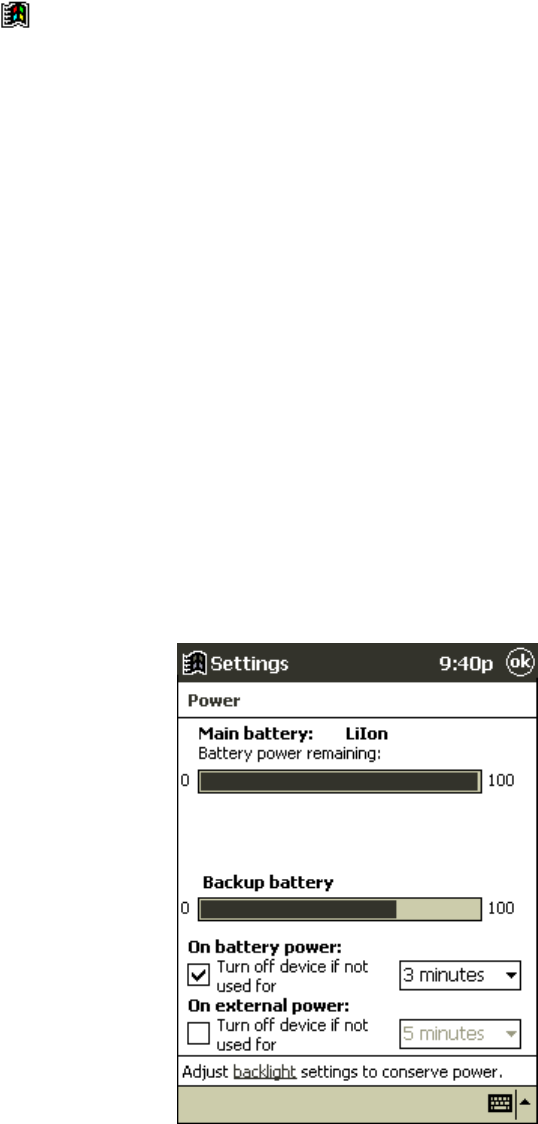
Bluebird User’s Guide 27
To remove programs
• Tap and then Settings. On the System tab, tap Remove Programs.
If the program does not appear in the list of installed programs, use File Explorer on your device
to locate the program, tap and hold the program, and then tap Delete on the pop-up menu.
Power
When you are working with your Bluebird and using battery power, you can monitor the charge
held in the battery by using the Power window. To conserve battery power, your Bluebird
automatically powers off whenever it is idle for a continuous period of time. If you are running on
battery power, you can conserve charge if you shorten the idle time before your Bluebird
automatically powers off.
To display the Power control panel:
• Tap , Settings, System, then Power.
• If the battery is low on charge, the battery icon appears on the command bar on the Today
screen. Tap the battery icon to display the Power control panel.
• If the battery gets very low, your Bluebird displays a warning message. If this occurs, save
any unsaved data you are working on, perform a synchronization with your computer, then
turn off your Bluebird.
The Power control panel only shows the battery charge level if you are using the battery. If you
have connected the AC adapter, the window shows the recharging status.
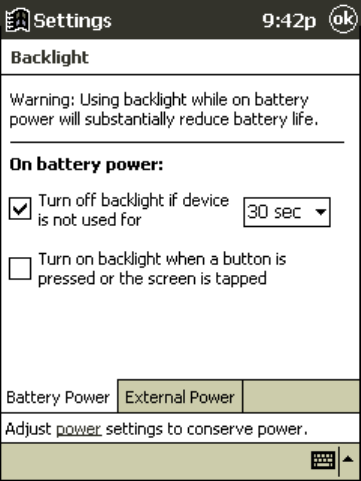
Bluebird User’s Guide 28
To set the power off timer:
• Tap , Settings, System, then Power.
• Use the drop down menus to set the idle intervals before your Bluebird automatically powers
off.
• If you are playing an audio file on your Bluebird under battery power, the display will
automatically turn off after one minute if there has been no input to your Bluebird. The
display will turn back on once the audio file has finished playing. This power saving feature
is not adjustable.
Adjusting the Backlight
Bluebird features a built-in backlight that allows you to view text and graphics clearly whether
you're indoors or outdoors, in a dim study or at a brightly lit worksite.
• To turn on or off the backlight press and hold the Power button for about three seconds.
To adjust the backlight time-out:
• Use the drop-down menus to set the amount of idle time before the backlight turns off when
your Bluebird is using battery power and external power.
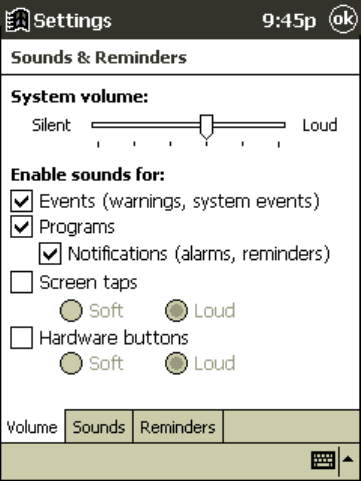
Bluebird User’s Guide 29
Controlling Volume
The Volume utility provides an easy way to adjust the volume of your Bluebird. Press Settings,
Personal, then tap Sounds & Reminders .
CF Card Expansion Slot
The CF Card Expansion Slot supports Type I CompactFlash cards. The CompactFlash slot allows
you to install storage cards for backup and storage of data and applications. It also allows you to
install communication devices such as a LAN adapter or a fax/modem. (For a complete list of the
options available see Appendix: CF cards)
To insert a CompactFlash card:
Push the card, connector-side first into the slot until it stops.
To remove a CompactFlash card:
Close all applications on your Bluebird that have open files on the CompactFlash card.
Lever the CompactFlash card out of the slot using a fingernail.
Guidelines for Using CompactFlash Cards
Your Bluebird automatically recognizes a wide range of CompactFlash cards approved for use
with Windows CE. If you are ever instructed to install card-specific Bluebird drivers provided by
Bluebird User’s Guide 30
a CompactFlash card manufacturer, be sure to install only device drivers specifically designed for
the Windows CE operating system on your Bluebird. If you are unclear about installation
instructions, call your CompactFlash card manufacturer for more information
• Some CompactFlash cards consume large amounts of power. To avoid battery drainage when
using a CompactFlash card, connect your Bluebird to AC power wherever possible.
• If the battery is very low, you should not attempt to save data to a CompactFlash card. This
may result in the loss of data. First replace the batteries or connect to AC power.
• Do not turn off your Bluebird or remove the CompactFlash card when you are in the middle
of performing an operation, such as saving data to your CompactFlash card.
• Keep your CompactFlash card in a protective casing when not in use to protect from dirt,
moisture and static electricity.
Backup and Restore Data
To avoid losing your data in the event that your Bluebird Pocket PC is lost, stolen, or becomes
defective, periodic backups to the computer or a CompactFlash card are recommended.
Depending on your usage, you may want to perform a backup as often as once a day. You can
back up and restore your Bluebird's data using the following utilities:
ActiveSync Backup/Restore . Use this ActiveSync utility to periodically back up your Bluebird's
data onto your computer’s hard drive. You can manually back up data or set this utility to back up
automatically each time you connect to your Pocket PC. For more information, see ActiveSync
Help on your computer.
CF Backup. This utility lets you back up and restore your entire Pocket PC memory contents to a
CompactFlash storage card (purchased separately). You can then carry a CompactFlash card–
based copy of your data with you at all times for quick retrieval.
Backing up Data to a CF Card
Each time you use the CF Backup utility, your data files, databases, preferences, Windows CE
system data, and applications are copied to the CompactFlash storage card.
You should use a card at least as big as your Bluebird's RAM (Random Access Memory)
size, e.g., 16 or 32 MB.
To perform a backup:
Connect to external power or tap, Settings, System, then Power to verify that the battery has a
charge rating of 20% or greater.
1) Install a CompactFlash storage card into your Bluebird, as described earlier in this chapter.
2) Press the DeskTop button, then tap, CF Backup, then Backup - or Programs, then CF
Backup.
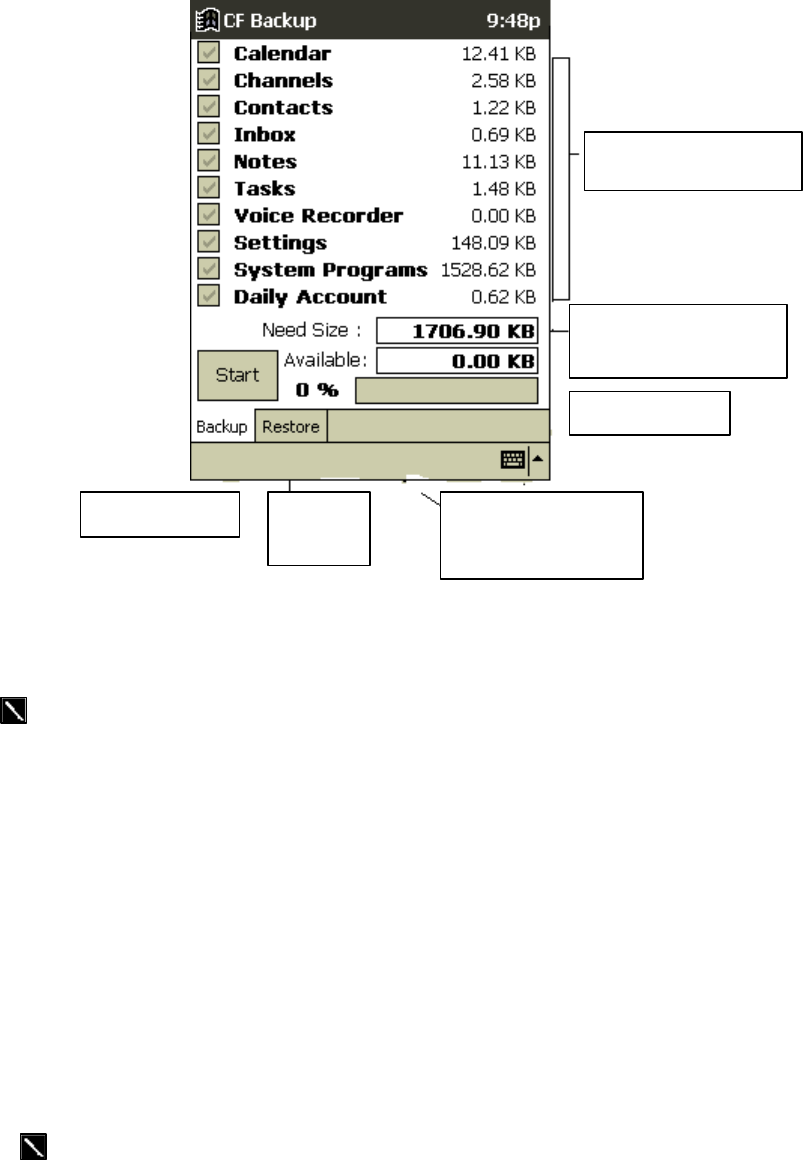
Bluebird User’s Guide 31
The screen displays a list of all the items that will be backed up, so it is easy to identify the
data and size that is saved to the CompactFlash storage card.
3) Tap the Start button to begin the backup process. A status bar reports the data activity until
the function is complete.
Do not remove the CF card, or turn off the unit during backup. Data loss can result .
4) When backup is complete, remove the CompactFlash storage card and keep it close for easy
retrieval.
To restore a backup onto your Bluebird
1. Install the CompactFlash storage card on your Bluebird.
2. Close all active programs.
3. Press the DeskTop button, then tap CF Backup tab.
4. Tap Restore.
5. Tap the Start button to begin the restore process. A status bar reports the data activity until
the function is complete.
Do not remove the CF card, or turn off the unit during restore. Data loss can result.
7. The reset screen will appear when the restore process is complete.
Items to be backed up
Amount of data to be
backed up
Status report
Tap to start to
backup or restore
Tap for Backup
Tap for
Restore
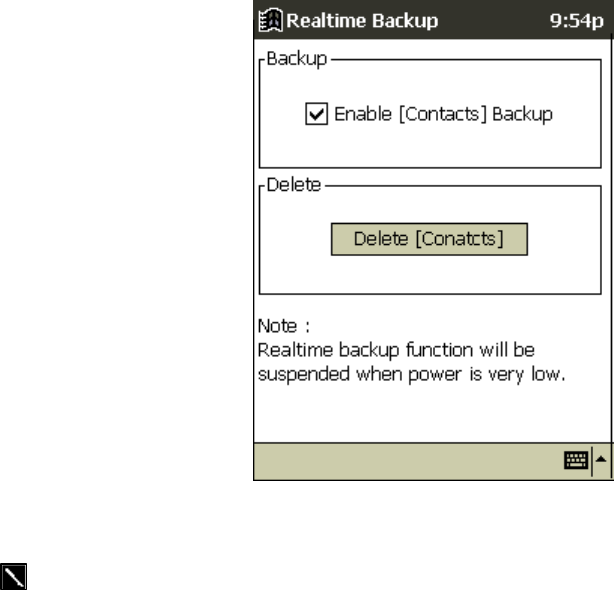
Bluebird User’s Guide 32
Real Time Backup
This program allows you to back up Contacts to your Bluebird’s flash ROM, protecting them in
the event you fail to recharge your Bluebird within 40 hours and all the data stored in RAM is
lost. Data and programs stored in the flash ROM of your Bluebird – which includes all the
software already installed on your device when you purchase it – will not be lost if you fail to
recharge your Bluebird within the specified period. However, all the new software and files you
have created since purchasing your Bluebird will. As it is not possible to back up all the data on
your Bluebird to flash ROM Contacts were chosen because of their extreme importance.
Contacts Backup is a last line of defense to protect some of your data – to safeguard all of the
data on your Bluebird make periodic backups to a CF Card or synchronize with your desktop (see
above).
• To switch on Real Time Backup, press DeskTop, tap Real Time Backup, and then tick
Backup (Contacts are automatically backed up every time you create or modify one).
• To delete Contacts from flash ROM, press DeskTop, tap Real Time Backup, and then
Delete Contacts.
HTC DeskTop
HTC DeskTop greatly speeds up access to and management of programs on your device. You
can immediately view and open essential programs by placing them on a special desktop screen,
which can be activated anytime by one press of a button. You can use the System Manager to
quickly close individual or all open programs. And, you can change the perspective of the screen
from landscape to portrait through Tools.
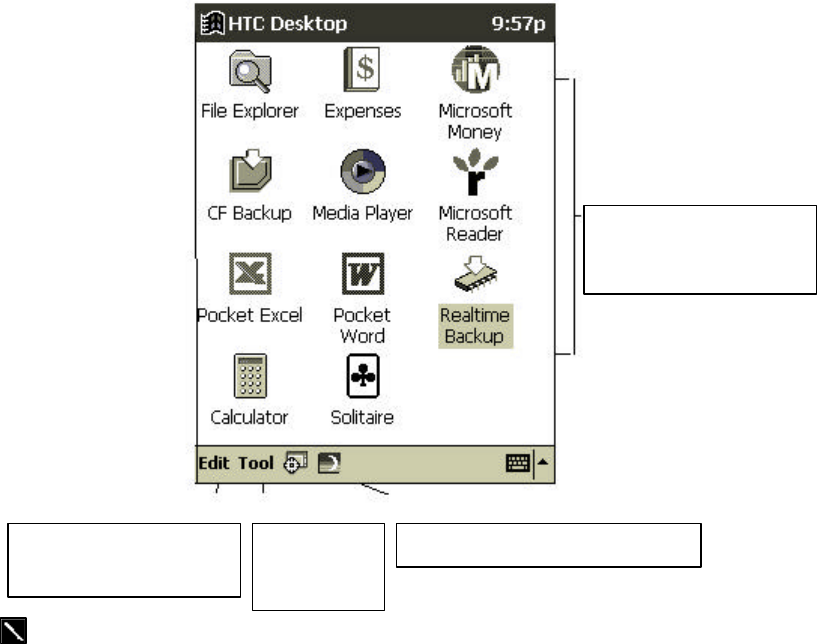
Bluebird User’s Guide 33
The programs shown above on your desktop are listed by default on every Bluebird. If you
want to add programs, delete or change the name of programs, see below.
To open and customize your Bluebird desktop:
1. Press the top button on the left-hand side of your Bluebird Pocket PC to open DeskTop.
2. Open your Bluebird desktop; tap Edit and then New.
3. Tap on the folder containing the file you want to add to the desktop, then select the
appropriate file, and on Yes. If you cannot find the file you want, or are not sure what folder
it is in, you can navigate through the folders by double clicking and then pressing Back to
return to the previous screen. (The maximum number of icons allowed on your desktop is 21)
The list of default
programs
Tap to open System Manager
Tap to edit the programs
on Desktop Tap to
rotate the
screen
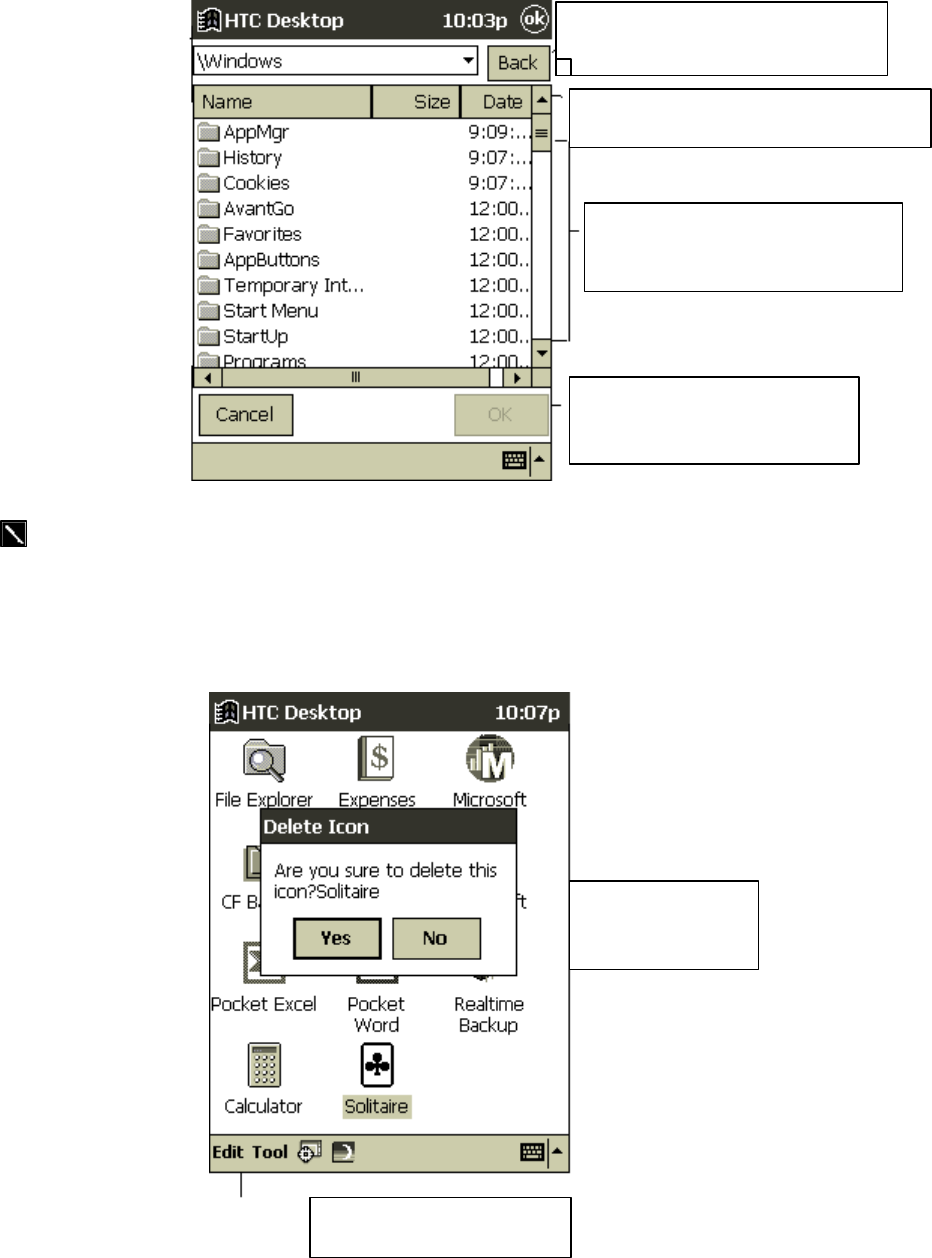
Bluebird User’s Guide 34
If the device is reset then it will return to the default icon setting, as of when the device was
purchased.
4. To delete programs from your desktop use the jog wheel to select a program icon; then tap
Edit, Delete and Yes to confirm.
5. To rename programs select a program with the jog wheel, then tap Edit and Rename . Enter a
Click to go back to the previous
folder or file
The folder appears here after you double
tap it
Tap a file from the list
Tap here to add the program
icon to your desktop
Tap to delete the
selected program
icon
Tap here to select delete
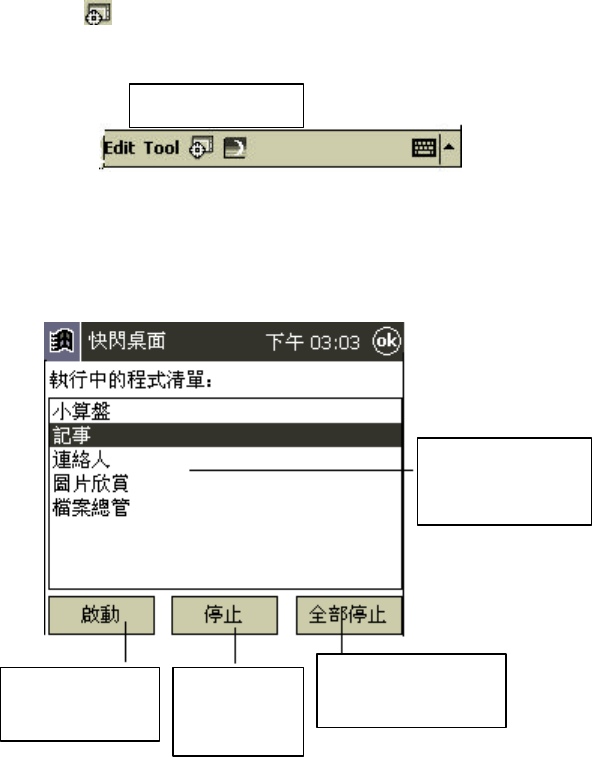
Bluebird User’s Guide 35
new name for the program and tap Yes.
6. To change the program order tap Edit, Sort, then By Frequency, By Default Setting, or
Alphabetically.
7. To rotate the screen tap Tools, Landscape - Left, Landscape -Right or Normal. If you
decide to click Yes, then the system will restart.
WARNING: The landscape option mentioned directly above in No.7 is not a Microsoft
program, and therefore, does not work well with all Microsoft software.
To close programs:
Tap the Sys tem Manager icon next to Tools.
You then have 3 choices: to close all programs tap Close All; to close a program tap it, and then
click on Close; to go to an open program highlight it, then tap Open.
System Manager
Select a program
to close or open
Tap to close all
programs
Tap to close
a program
Tap to open a
program
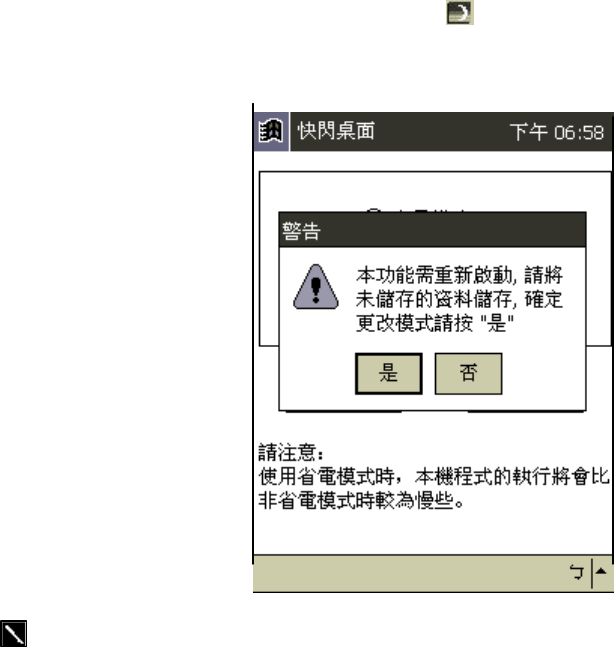
Bluebird User’s Guide 36
Power Saving
This function is provided to help you maximize the battery life of your Bluebird. By selecting
Power Saving you will reduce the speed of the Bluebird’s CPU and save on power consumption.
This setting will reduce the speed and performance of your Bluebird; if you need to use
multimedia applications choose Disable.
To enable power saving:
1. To select Power Saving, press DeskTop, tap and then Enable.
2. Tap Yes, and then Yes again to restart the system.
Always save all the information on your Bluebird before pressing Yes to reset. If you
have not saved all the information on your Bluebird, tap No, then save all your important
information.

Bluebird User’s Guide 37
Chapter 3: Microsoft ActiveSync
Using Microsoft ActiveSync, you can synchronize the information on your desktop computer
with the information on your Bluebird. Synchronization compares the data on your Bluebird with
your desktop computer and updates both computers with the most recent information. For
example:
• Keep Pocket Outlook data up-to-date by synchronizing your Bluebird with your choice of
Microsoft Outlook, Microsoft Schedule+, or Microsoft Exchange on your desktop computer.
• Synchronize Microsoft Word and Microsoft Excel documents between your Bluebird and
desktop computer. Your files are automatically converted to the correct format
By default, ActiveSync does not automatically synchronize all
types of information, for example, e-mail messages. Use
ActiveSync options to turn synchronization on and off for specific
information types.
With ActiveSync, you can also:
• Back up and restore your Bluebird data.
• Copy (rather than synchronize) files between your Bluebird and desktop computer.
• Control when synchronization occurs by selecting a synchronization mode. For example, you
can synchronize continually while the device is in the cradle or only when you choose the
synchronize command.
• Select which information types are synchronized and control how much data is synchronized.
For example, you can choose how many weeks of past appointments you want synchronized.
For information on installing ActiveSync, see the booklet accompanying the ActiveSync CD. For
information on using ActiveSync, see ActiveSync Help on the desktop computer.
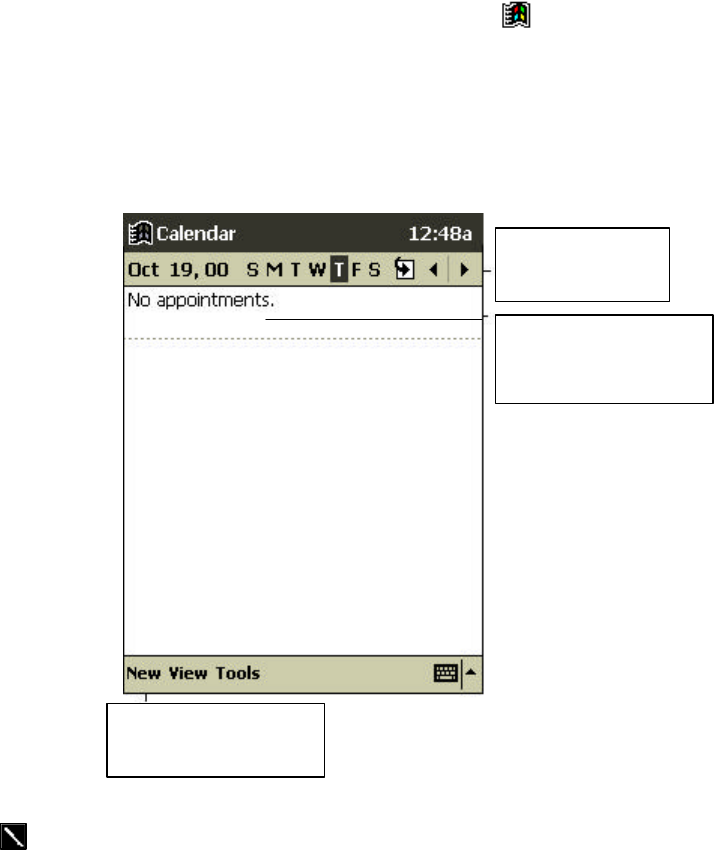
Bluebird User’s Guide 38
Chapter 4: Microsoft Pocket Outlook
Microsoft Pocket Outlook includes Calendar, Contacts, Tasks, Inbox, and Notes. You can use
these programs individually or together. For example, e-mail addresses stored in Contacts can be
used to address e-mail messages in Inbox.
Using ActiveSync, you can synchronize information in Microsoft Outlook, Microsoft Schedule+,
or Microsoft Exchange on your desktop computer with your device. Each time you synchronize,
ActiveSync compares the changes you made on your device and desktop computer and updates
both computers with the latest information. For information on using ActiveSync, see ActiveSync
Help on the desktop computer.
You can switch to any of these programs by tapping them on the menu.
Calendar: Scheduling Appointments and Meetings
Use Calendar to schedule appointments, including meetings and other events. You can check
your appointments in one of several views (Agenda, Day, Week, Month, Chinese Monthly
calendar and Year) and easily switch views by using the View menu.
You can customize the Calendar display, such as changing the
first day of the week, by tapping Options on the Tools menu.
To create an appointment:
1. If you are in Day or Week view, tap the desired date and time for the appointment.
Tap to move to
today
Tap to display or edit
an appointment
Tap to create a new
appointment
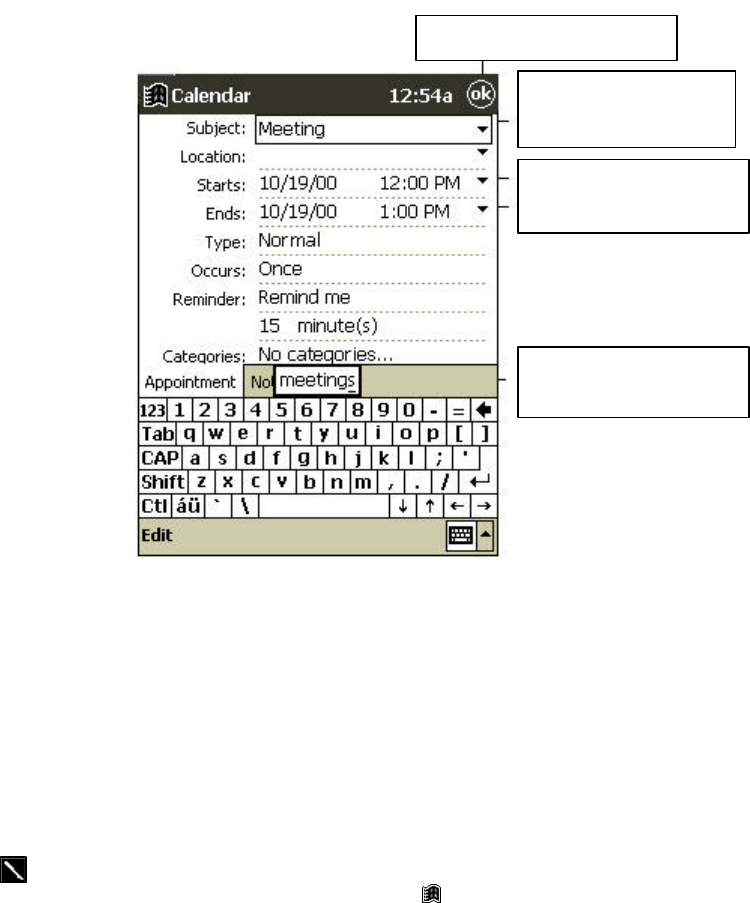
Bluebird User’s Guide 39
2. Tap New.
3. Using the input panel, enter a description and a location. Tap first to select the field.
4. If needed, tap the date and time to change them.
5. Enter other desired information. You will need to hide the input panel to see all available
fields.
6. To add notes, tap the Notes tab. You can enter text, draw, or create a recording. For more
information on creating notes, see “Notes: Capturing Thoughts and Ideas,” later in this
chapter.
7. When finished, tap OK to return to the calendar.
If you select Remind me in an appointment, your device will
remind you according to the options set in , Settings, Personal
tab, Sounds & Reminders .
Using the Summary Screen
When you tap an appointment in Calendar, a summary screen is displayed. Tap the top portion of
the summary screen to change the appointment.
Tap to return to the calendar
Tap to choose from
predefined text
Tap to select a time and
date
Notes is a goo
d place for
maps and directions
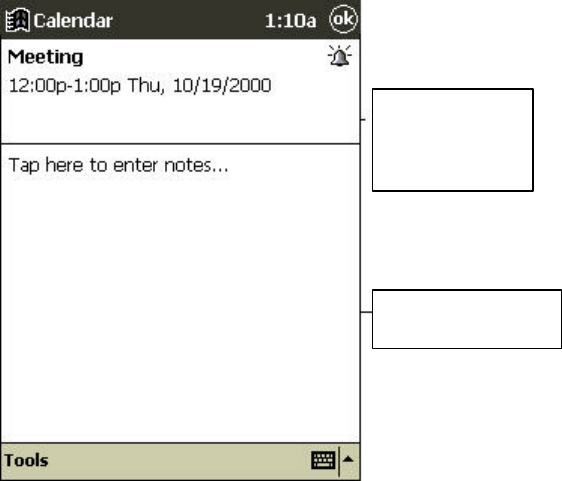
Bluebird User’s Guide 40
Creating Meeting Requests
You can use Calendar to set up meetings with users of Outlook, Pocket Outlook, or Schedule+.
The meeting notice will be created automatically and sent either when you synchronize Inbox or
when you connect to your e-mail server. Indicate how you want meeting requests sent by tapping
Tools and then Options. If you send and receive e-mail messages through ActiveSync, select
ActiveSync.
To schedule a meeting:
1. Create an appointment.
2. In the appointment details, hide the input panel, and then tap Attendees.
3. From the list of e-mail addresses you’ve entered in Contacts, select the meeting attendees.
The meeting notice is created automatically and placed in the Outbox folder.
For more information on sending and receiving meeting requests, see Calendar Help and Inbox
Help on the device.
Contacts: Tracking Friends and Colleagues
Contacts maintains a list of your friends and colleagues so that you can easily find the
information you’re looking for, whether you’re at home or on the road. Using the device infrared
(IR) port, you can quickly share Contacts information with other Windows-powered device users.
Tap to edit
appointment
details
Tap to enter notes
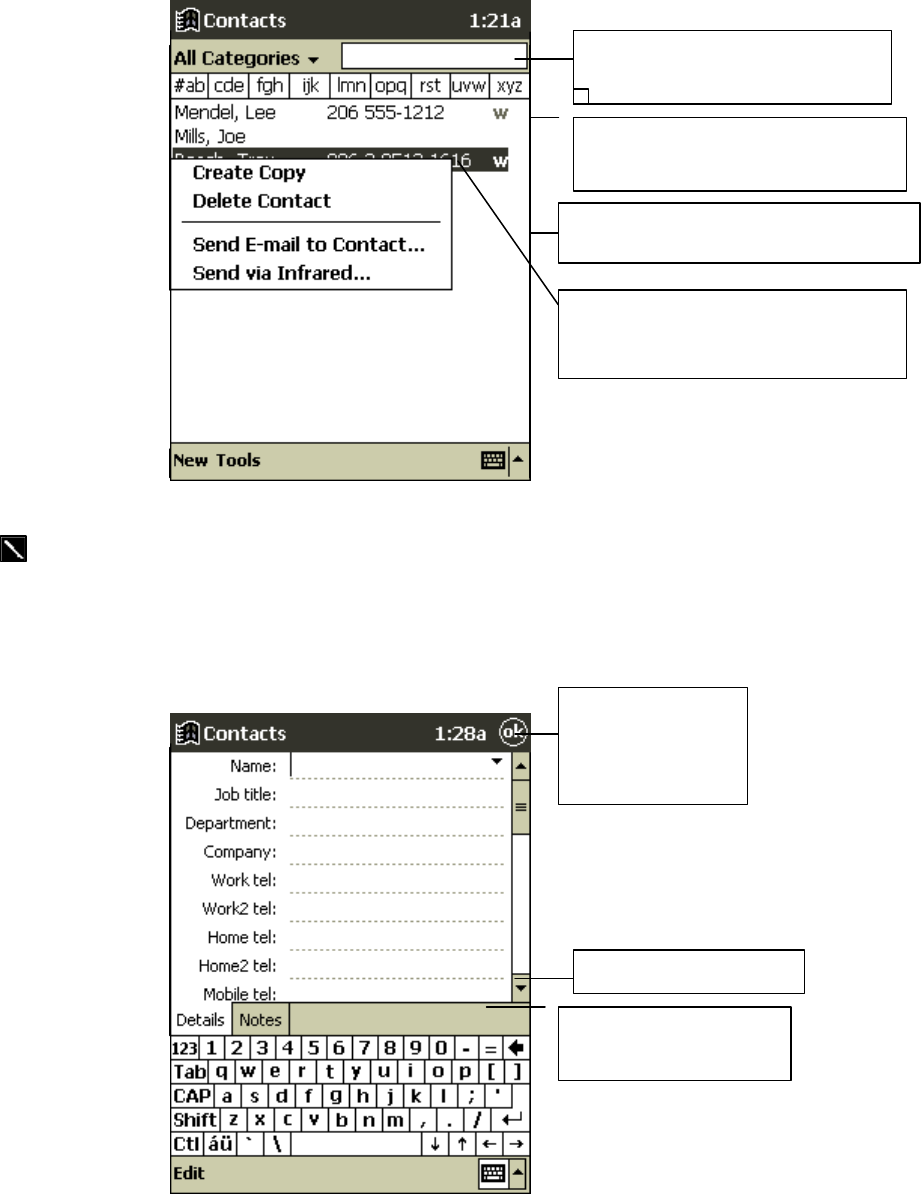
Bluebird User’s Guide 41
To change the way information is displayed in the list, tap
Tools and then Options .
To create a contact:
1. Tap New.
2. Using the input panel, enter a name and other contact information. You will need to scroll
down to see all available fields.
Tap to return to the
contact list (the list
is saved
automatically)
Scroll to see more fields
Notes is a good place for
maps and directions
Tap and enter part of a name to
quickly find it in the list
Tap to see additional phone numbers
and e-mail addresses
Tap to display or edit the contact details
Tap and hold to display a pop-up
menus of actions
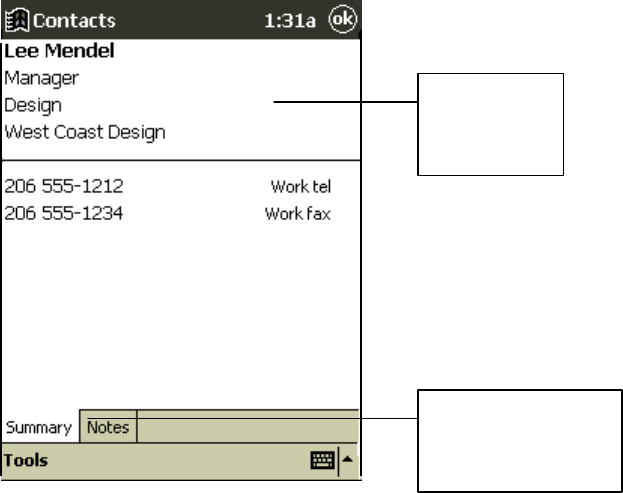
Bluebird User’s Guide 42
3. To assign the contact to a category, scroll to and tap Categories and select a category from
the list. In the contact list, you can display contacts by category.
4. To add notes, tap the Notes tab. You can enter text, draw, or create a recording. For more
information on creating notes, see “Notes: Capturing Thoughts and Ideas,” later in this
chapter.
5. When finished, tap OK to return to the contact list.
Using the Summary Screen
When you tap a contact in the contact list, a summary screen is displayed.
Tasks: Keeping a To Do List
Use Tasks to keep track of what you have to do. In the task list, overdue tasks are displayed in
bold (and in red on color devices).
Tap to edit
the contact
details
Tap to enter or edit
notes
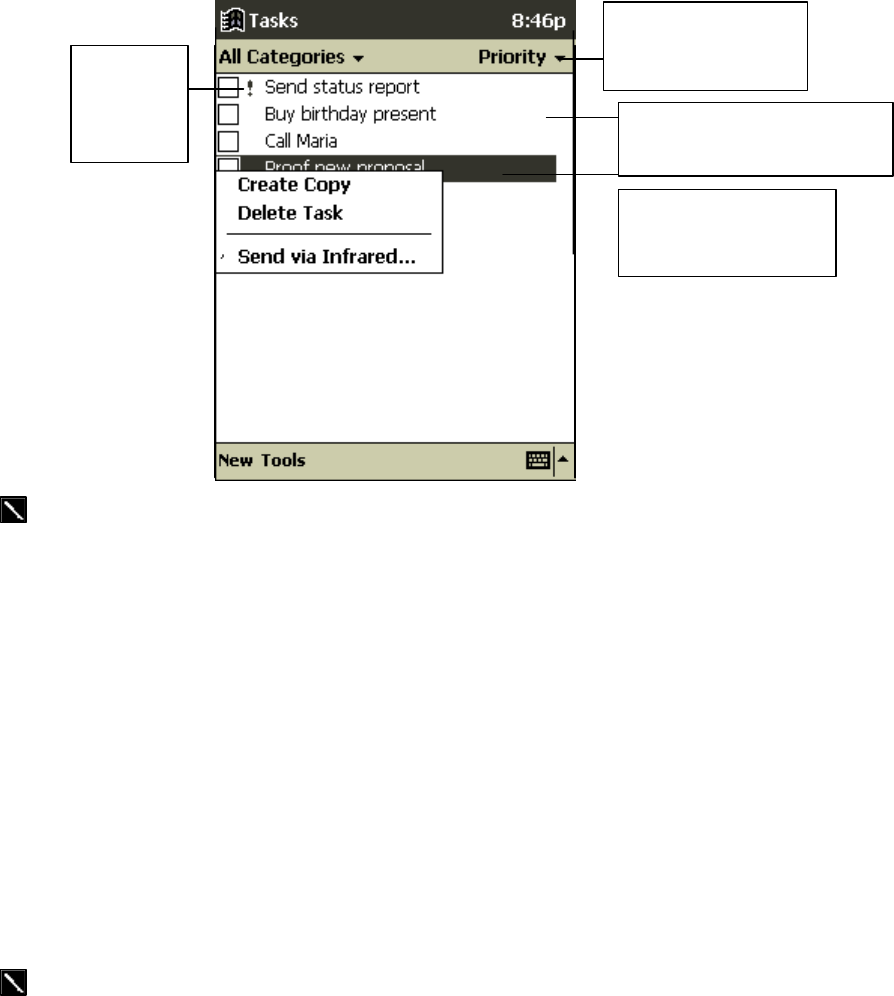
Bluebird User’s Guide 43
To change the way information is displayed in the list, tap Tools
and then Options.
To create a task:
1. Tap New.
2. Using the input panel, enter a description.
3. You can enter a start date and due date or enter other information by first tapping the field. If
the input panel is open, you will need to hide it to see all available fields.
4. To assign the task to a category, tap Categories and select a category from the list. In the task
list, you can display tasks by category.
5. To add notes, tap the Notes tab. You can enter text, draw, or create a recording. For more
information on creating notes, see “Notes: Capturing Thoughts and Ideas,” later in this
chapter.
6. When finished, tap OK to return to the task list.
To quickly create a task with only a subject, tap Entry Bar on the
Tools menu. Then, tap Tap here to add a new task and enter
your task information.
Select the sort order
of the list.
Tap to display or edit the task
details.
Tap and hold to
display a pop-
up menu
of actions.
Indicates
high
priority
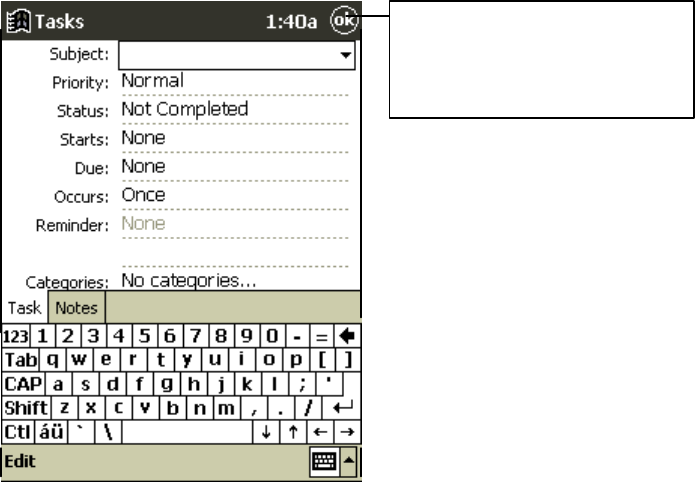
Bluebird User’s Guide 44
Tap to return to the contact list
(the contact is saved
automatically).
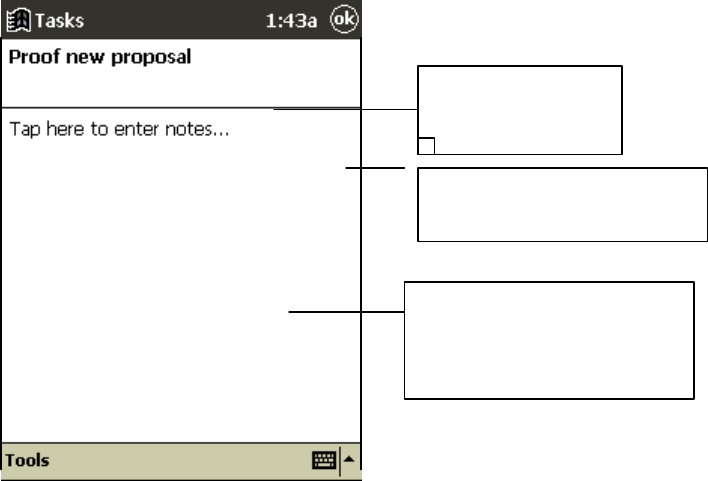
Bluebird User’s Guide 45
Using the Summary Screen
When you tap a task in the task list, a summary screen is displayed.
Notes: Capturing Thoughts and Ideas
Quickly capture thoughts, reminders, ideas, drawings, and phone numbers with Notes. You can
create a written note or a recording. You can also include a recording in a note. If a note is open
when you create the recording, it will be included in the note as an icon. If the note list is
displayed, it will be created as a stand-alone recording.
To create a note:
1. Tap New.
2. Create your note by writing, drawing, typing, and recording. For more information about
using the input panel, writing and drawing on the screen, and creating recordings, see Chapter
two.
Tap to edit the task
details
Tap to show and hide additional
summary information
Tap to enter or edit notes
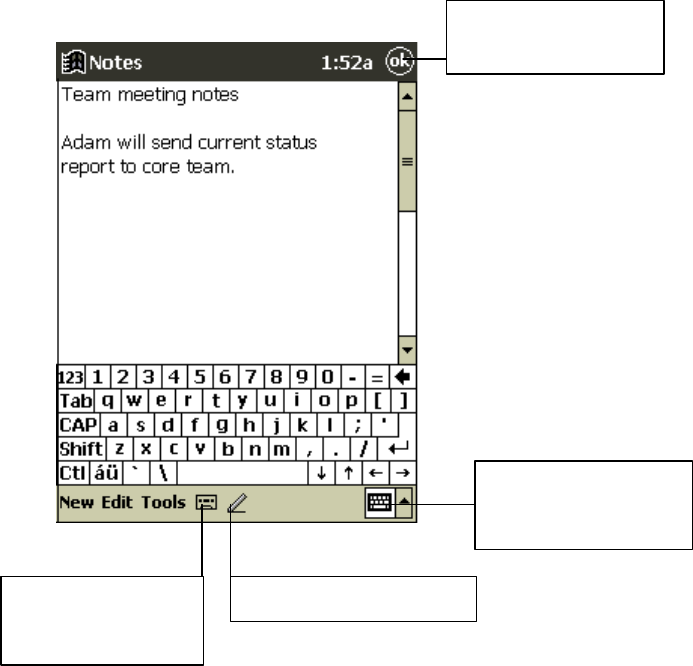
Bluebird User’s Guide 46
Inbox: Sending and Receiving E-mail Messages
Use Inbox to send and receive e-mail messages in either of these ways:
• Synchronize e-mail messages with Microsoft Exchange or Microsoft Outlook on your
desktop computer.
• Send and receive e-mail messages by connecting directly to an e-mail server through an
Internet service provider (ISP) or a network.
Synchronizing E-mail Messages
E-mail messages can be synchronized as part of the general synchronization process. First, you’ll
need to enable Inbox synchronization in ActiveSync options. For information on enabling Inbox
synchronization, see ActiveSync Help on the desktop computer.
During synchronization:
• E-mail messages are copied from the Inbox folder of Exchange or Outlook on your desktop
computer to the Inbox folder on your device. The e-mail messages on the two computers are
linked, so when you delete an e-mail message on your device, it’s also deleted from your
desktop computer the next time you synchronize.
• E-mail messages in the Outbox folder on your device are transferred to Exchange or Outlook,
and then sent from those programs.
Tap to return to the
note list.
Tap to show or hide
the input panel.
Tap to write on the screen.
Tap to add a
recording to the note.

Bluebird User’s Guide 47
You can also synchronize e-mail messages with your desktop
computer from a remote location. For more information, see
Chapter 7.
Connecting Directly to an E-mail Server
In addition to synchronizing e-mail messages with your desktop computer, you can send and
receive e-mail messages by connecting to an e-mail server using a modem or network card
connected to your device. You’ll need to set up a remote connection to a network or an ISP, and a
connection to your e-mail server. For more information, see Chapter 7.
When you connect to the e-mail server, new messages are downloaded to the device Inbox folder,
messages in the device Outbox folder are sent, and messages that have been deleted on the e-mail
server are removed from the device Inbox.
Messages that you receive directly from an e-mail server are linked to your e-mail server rather
than your desktop computer. When you delete a message on your device, it’s also deleted from
the e-mail server the next time you connect.
You can work online or offline. When working online, you read and respond to messages while
connected to the e-mail server. Messages are sent as soon as you tap Send, which saves space on
your device.
When working offline, once you’ve downloaded new message headers or partial messages, you
can disconnect from the e-mail server and then decide which messages to download completely.
The next time you connect, Inbox downloads the complete messages you’ve marked for retrieval
and sends the messages you’ve composed.
Using the Message List
Messages you receive are displayed in the message list. By default, the most recently received
messages are displayed first in the list.
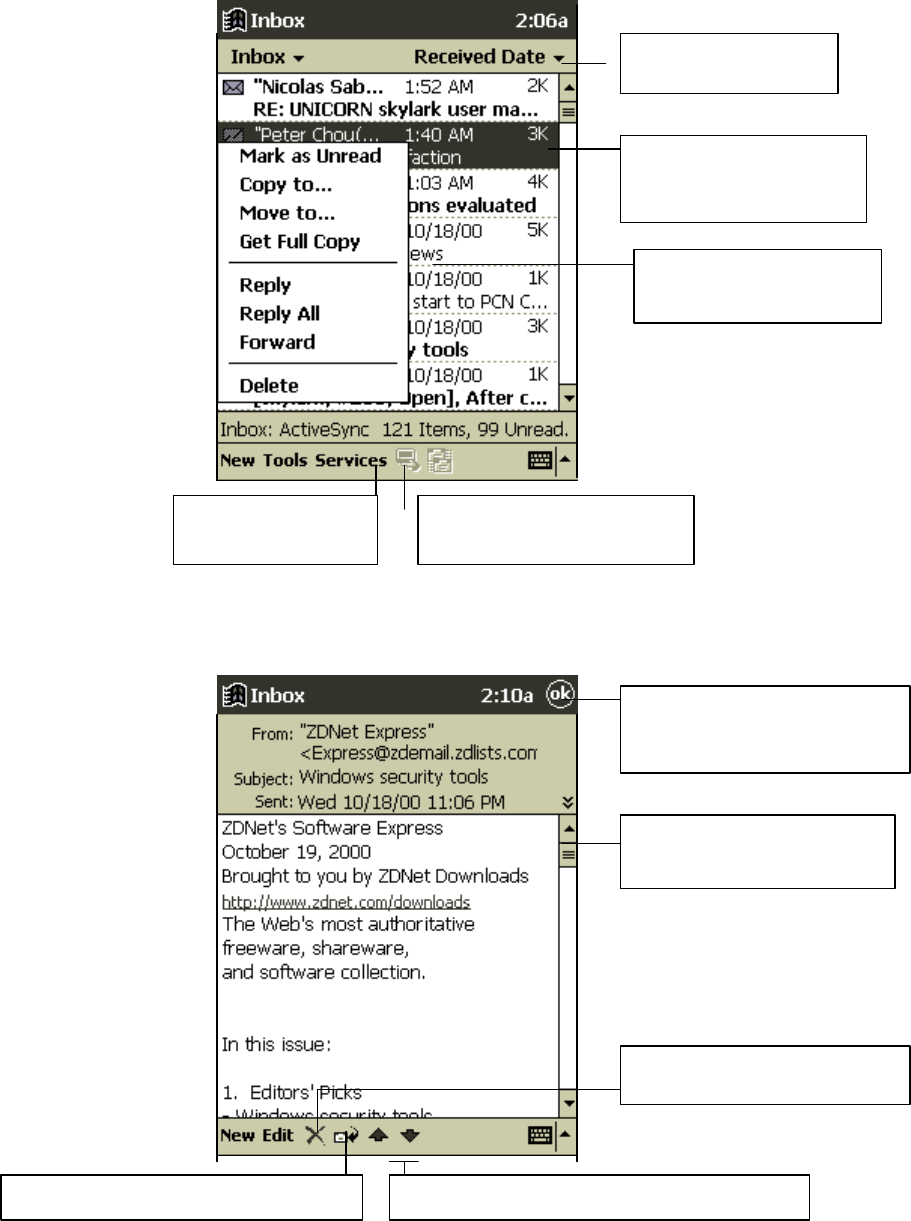
Bluebird User’s Guide 48
When you receive a message, tap it in the list to open it. Unread messages are displayed in bold.
When you connect to your e-mail server or synchronize with your desktop computer, Inbox
downloads only the first 100 lines of each new message by default. No e-mail attachments are
Select the sort order
for messages.
Tap to open a message.
Tap and hold to display a
pop-up menu of actions.
Tap to connect and to send
and receive e-mail.
Tap to connect to
the
selected service.
Tap to return to the message
list.
Tap to show or hide the
complete header.
Tap to delete a message.
Tap to view the previous or next message.
Tap to reply to or forward this message.
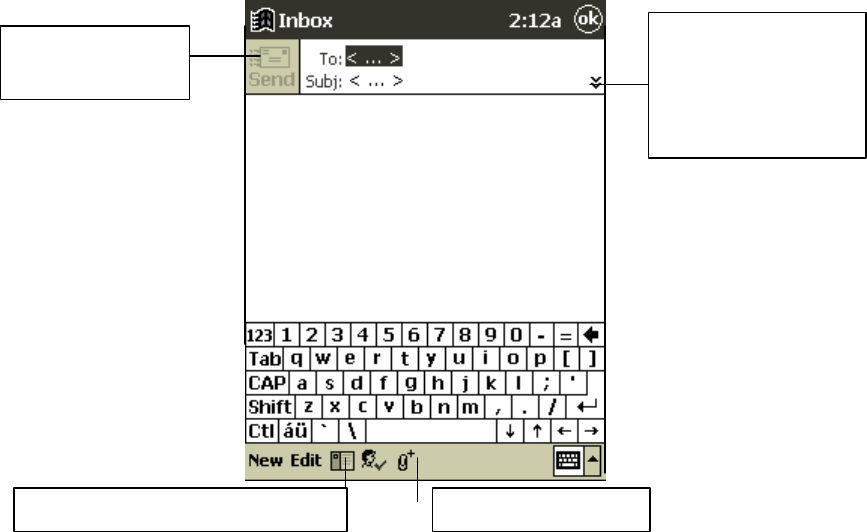
Bluebird User’s Guide 49
downloaded. The original messages remain on the e-mail server or your desktop computer.
You can mark the messages that you want to retrieve in their entirety the next time you
synchronize or connect to your e-mail server. In the message list, tap and hold the message you
want to retrieve. On the pop-up menu, tap Get Full Copy. The icons in the Inbox message list
give you visual indications of message status.
You’ll need to download a full message before you can view its attachments. Attachments appear
as icons in a window pane at the bottom of the message. Tapping an attachment icon opens the
attachment if it has been fully downloaded or marks it for download the next time you
synchronize or connect to your e-mail server.
You specify your downloading preferences when you set up the service or select your
synchronization options. You can change them at any time:
• Change options for Inbox synchronization using ActiveSync options. For more information,
see ActiveSync Help.
• Change options for direct e-mail server connections in Inbox on your device. Tap Tools and
then tap Options . On the Se rvice tab, tap the service you want to change.
Composing E-mail Messages
To compose an e-mail message:
1. Tap New.
2. Enter an e-mail address in To, or select a name from the contact list by tapping the Address
Book button.
All e-mail addresses entered in the e-mail fields in Contacts appear in the Address Book.
Tap to send the
message.
Tap to show or hide
the complete header.
Tap to attach a file.
Tap to display the Address Book.
Bluebird User’s Guide 50
3. Compose your message.
4. Tap Send when you’ve finished the message.
The message is placed in the Outbox folder on your device and will be delivered in one of two
ways:
• They are transferred to the Outbox folder in Exchange or Outlook on your desktop computer
and sent the next time you synchronize.
• They are transferred to your e-mail server the next time you connect. In Inbox, make sure the
appropriate service is selected on the Services menu. Then tap the Connect button (or
Connect on the Services menu).
Managing E-mail Messages and Folders
By default, messages are displayed in one of four folders for each service you’ve created: Inbox,
Deleted (local), Outbox, and Sent. The Deleted folder contains messages that have been deleted
on the device. If you are using IMAP4, you may see a Deleted Items folder. This folder is for
messages deleted on the e-mail server. The behavior of the Deleted and Sent folders depends on
the options you have chosen. In the message list, tap Tools and then Options. On the Message
tab, select your options.
If you want to organize messages into additional folders, tap Tools, and then New Folder to
create new folders. To move or copy a message to another folder, in the message list, tap and hold
the message and then tap Move to or Copy to on the pop-up menu.
Folder behavior with ActiveSync
If you move e-mail messages into a folder you create, the link is broken between these e-mail
messages and their copies on the desktop computer. When you synchronize next, the e-mail
messages in the folder you created will not be synchronized. In addition, e-mail messages that are
missing from the device Inbox folder will be deleted from the Inbox folder on the desktop
computer so that both Inbox folders match. This prevents you from getting duplicate copies of an
e-mail message, but it also means that you will no longer have access to the e-mail messages you
move out of Inbox except from the device.
Folder behavior with a direct connection to an e-mail server
The behavior of the folders you create depends on whether you are using POP3 or IMAP4:
• If you are using POP3, folders will behave like they do when using ActiveSync.
• If you are using IMAP4, the folders you create and the messages you move are mirrored on
the e-mail server. For example, if you move two messages from the Inbox folder to a folder
called Family, the e-mail server will create a copy of the Family folder and move the
messages into that folder. Therefore, messages are available to you anytime you connect to
your e-mail server, whether it is from your device, laptop computer, or desktop computer.
This synchronization of folders occurs when you create a new folder, move e-mail messages
into a folder, or tap Synchronize Folders on the Services menu. If you want to view the
messages in a folder while disconnected from your e-mail server, select the folder and then
tap Folder Available Offline on the Services menu. This downloads the e-mail message in
the folder to your device.
Bluebird User’s Guide 51
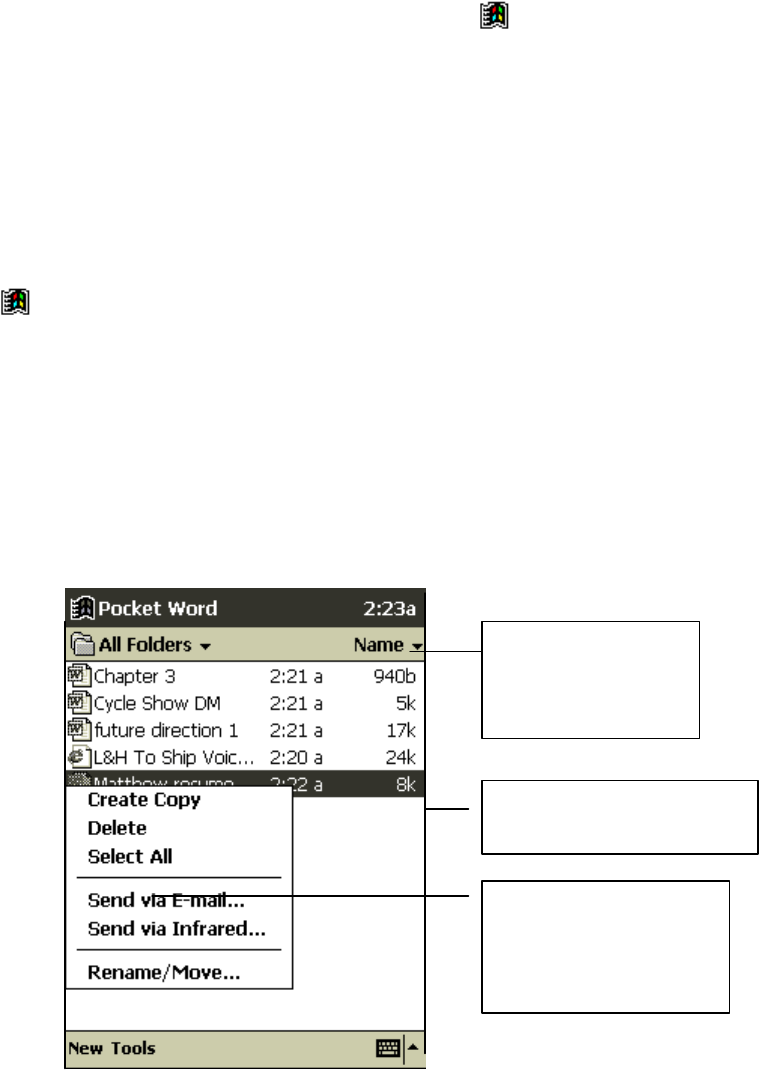
Bluebird User’s Guide 52
Chapter 5: Companion Programs
The companion programs consist of Microsoft Pocket Word, Microsoft Pocket Excel, Windows
Media Player for Pocket PC, Microsoft Dictionary, Easy Online and Image Viewer.
To switch to a companion program on your Bluebird, tap Programs on the menu, and then
tap the program name.
Pocket Word
Pocket Word works with Microsoft Word on your desktop computer to give you easy access to
copies of your documents. You can create new documents on your Bluebird, or you can copy
documents from your desktop computer to your Bluebird. Synchronize documents between your
desktop computer and your device so that you have the most up-to-date content in both locations.
Use Pocket Word to create documents, such as letters, meeting minutes, and trip reports. To
create a new file, tap , Programs, Pocket Word, and then New. A blank document appears.
Or, if you’ve selected a template for new documents in the Options dialog box, that template
appears with appropriate text and formatting already provided. You can open only one document
at a time; when you open a second document, you’ll be asked to save the first. You can save a
document you create or edit in a variety of formats, including Pocket Word (.psw), Rich Text
Format (.rtf), and Plain Text (.txt).
Pocket Word contains a list of the files stored on your Bluebird. Tap a file in the list to open it. To
delete, make copies of, and send files, tap and hold a file in the list. Then, select the appropriate
action on the pop-up menu.
You can enter information in Pocket Word in one of four modes (writing, drawing, typing, and
recording), which are displayed on the View menu. Each mode has its own toolbar, which you
can show and hide by tapping the Show/Hide Toolbar button on the command bar.
Tap to change the sort
order of the list.
Tap to open a document
Tap and hold an item to
see a pop-up menu of
actions.
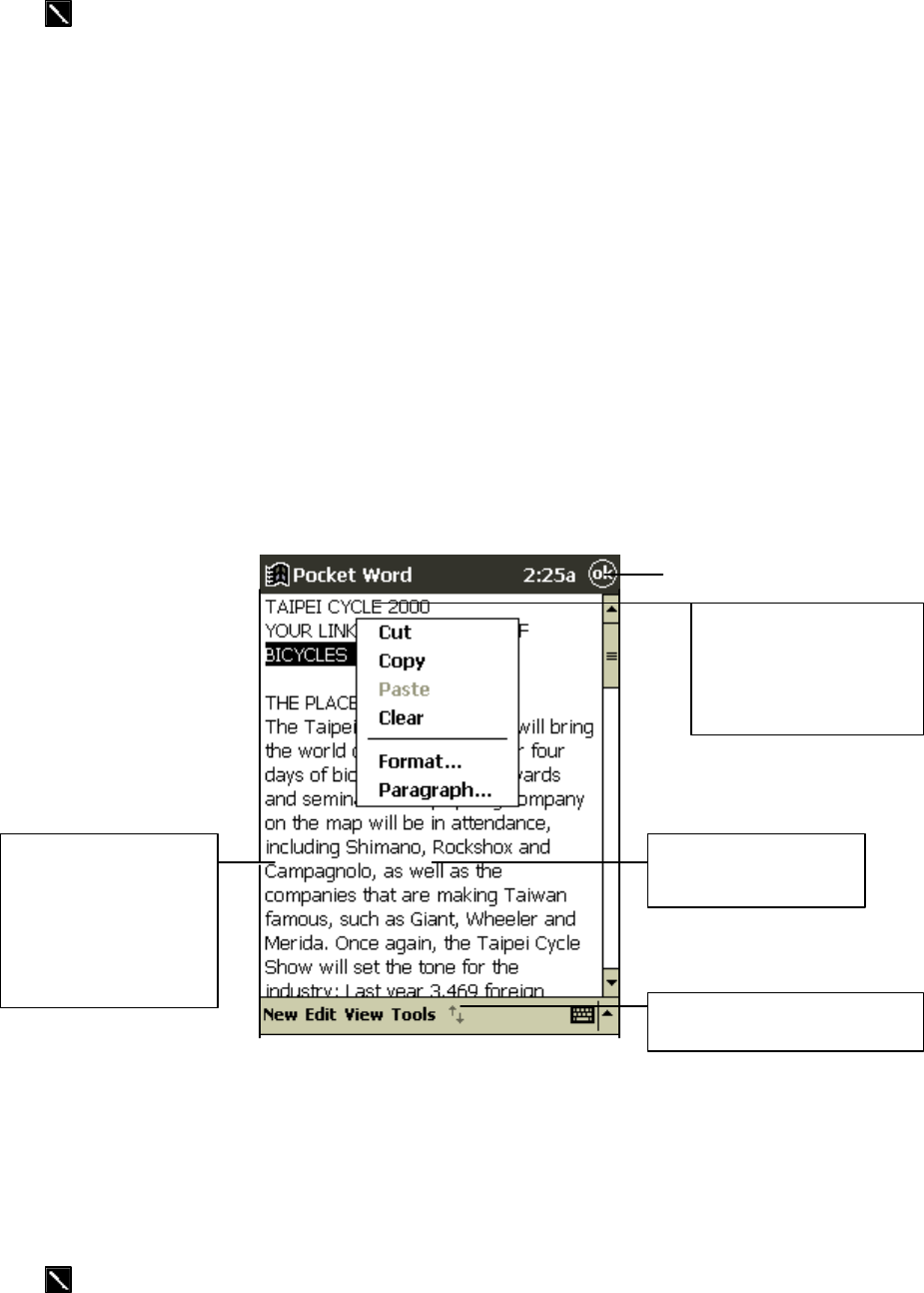
Bluebird User’s Guide 53
You can change the zoom magnification by tapping View and then
Zoom. Then select the percentage you want. Select a higher
percentage to enter text and a lower one to see more of your
document.
If you’re opening a Word document created on a desktop
computer, select Wrap to Window on the View menu so that you
can see the entire document.
Typing Mode
Using the input panel, enter typed text into the document. For more information on entering typed
text, see Chapter 2.
To format existing text and to edit text, first select the text. You can select text as you do in a
Word document, using your stylus instead of the mouse to drag through the text you want to
select. You can search a document to find the text you want by tapping Edit and then
Find/Replace.
Writing Mode
In writing mode, use your stylus to write directly on the screen. Ruled lines are displayed as a
guide, and the zoom magnification is greater than in typing mode to allow you to write more
easily. For more information on writing and selecting writing, see Chapter 2.
If you cross three ruled lines in a single stylus stroke, the writing
becomes a drawing, and can be edited and manipulated as
Tap and hold to see a
pop-up menu of actions.
Tap to change
formatting options.
Tap to format text.
Tap to show or hide the
toolbar.
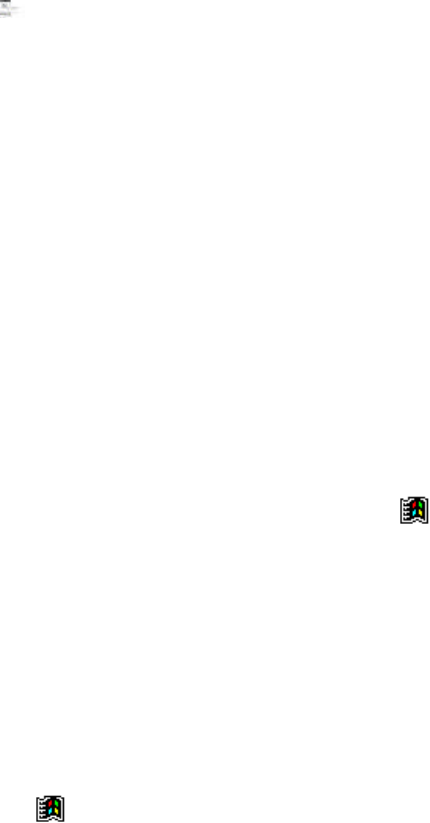
Bluebird User’s Guide 54
becomes a drawing, and can be edited and manipulated as
described in the following section.
Written words are converted to graphics (metafiles) when a Pocket
Word document is converted to a Word document on your desktop
computer.
Drawing Mode
In drawing mode, use your stylus to draw on the screen. Gridlines appear as a guide. When you
lift your stylus off the screen after the first stroke, you’ll see a drawing box indicating the
boundaries of the drawing. Every subsequent stroke within or touching the drawing box becomes
part of the drawing. For more information on drawing and selecting drawings, see Chapter 2.
Recording Mode
In recording mode, embed a recording into your document. Recordings are saved as .wav files.
For more information on recording, see Chapter 2.
For more information on using Pocket Word, tap and then Help.
Pocket Excel
Pocket Excel works with Microsoft Excel on your desktop computer to give you easy access to
copies of your workbooks. You can create new workbooks on your Bluebird, or you can copy
workbooks from your desktop computer to your Bluebird. Synchronize workbooks between your
desktop computer and your Bluebird so that you have the most up-to-date content in both
locations.
Use Pocket Excel to create workbooks, such as expense reports and mileage logs. To create a new
file, tap , Programs, Pocket Excel, and then New. A blank workbook appears. Or, if you’ve
selected a template for new workbooks in the Options dialog box, that template appears with
appropriate text and formatting already provided. You can open only one workbook at a time;
when you open a second workbook, you’ll be asked to save the first. You can save a workbook
you create or edit in a variety of formats, including Pocket Excel (.pxl) and Excel (.xls).
Pocket Excel contains a list of the files stored on your device. Tap a file in the list to open it. To
delete, make copies of, and send files, tap and hold a file in the list. Then select the appropriate
action from the pop-up menu.
Pocket Excel provides fundamental spreadsheet tools, such as formulas, functions, sorting, and
filtering. To display the toolbar, tap View and then Toolbar.
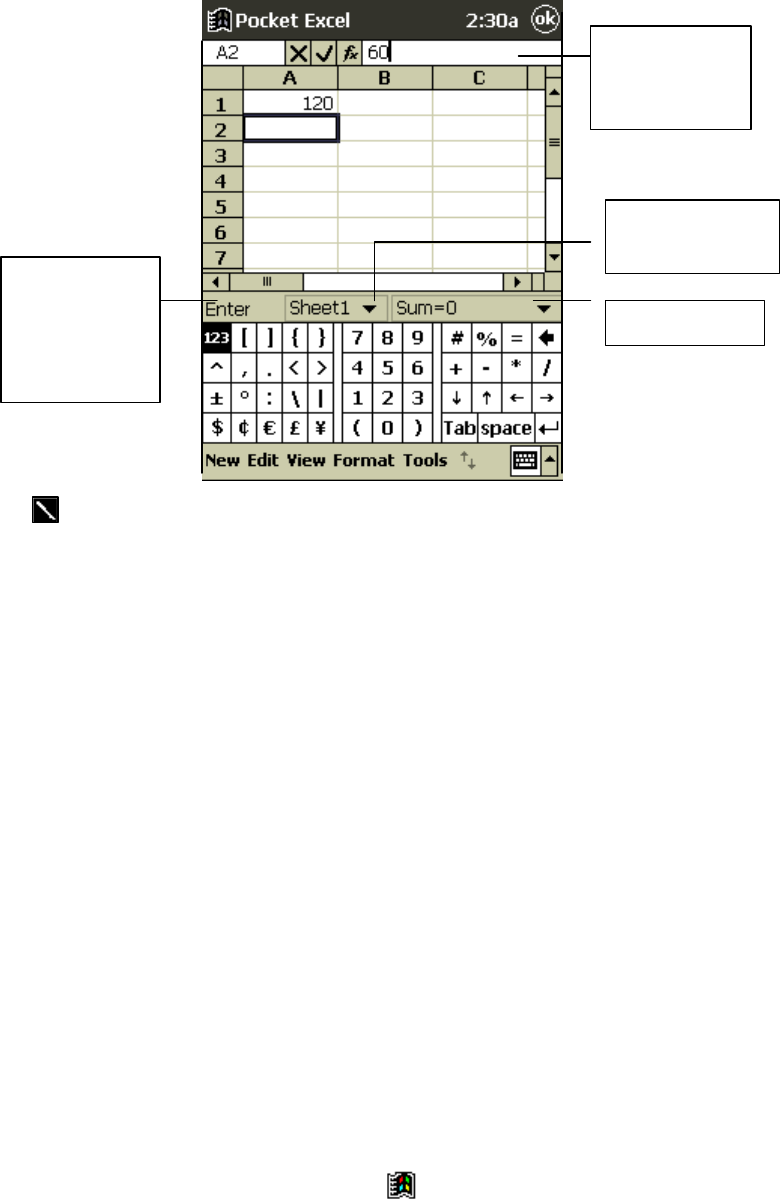
Bluebird User’s Guide 55
If your workbook contains sensitive information, you can
protect it with a password. To do so, open the workbook, tap Edit,
and then Password. Every time you open the workbook, you will
need to enter the password, so choose one that is easy for you to
remember but hard for others to guess.
Tips for Working in Pocket Excel
Note the following when working in large worksheets in Pocket Excel:
• View in full-screen mode to see as much of your worksheet as possible. Tap View and then
Full Screen. To exit full-screen mode, tap Restore .
• Show and hide window elements. Tap Vie w and then tap the elements you want to show or
hide.
• Freeze panes on a worksheet. First select the cell where you want to freeze panes. Tap View
and then Freeze Panes. You might want to freeze the top and leftmost panes in a worksheet
to keep row and column labels visible as you scroll through a sheet.
• Split panes to view different areas of a large worksheet. Tap View and then Split. Then drag
the split bar to where you want it. To remove the split, tap View and then Remove Split.
• Show and hide rows and columns. To hide a hidden row or column, select a cell in the row or
column you want to hide. Then tap Format, then Row or Column, then Hide . To show a
hidden row or column, tap Tools, then Go To, and then type a reference that is in the hidden
row or column. Then tap Format, then Row or Column, and then Unhide .
For more information on using Pocket Excel, tap and then Help.
account details with a Required and an Optional tab appears. Enter the name and type of the
account on the Required tab and the other information you want to record on the Optional tab
Format button.
Cell contents
appear here as
you enter them.
AutoSum button
Zoom button
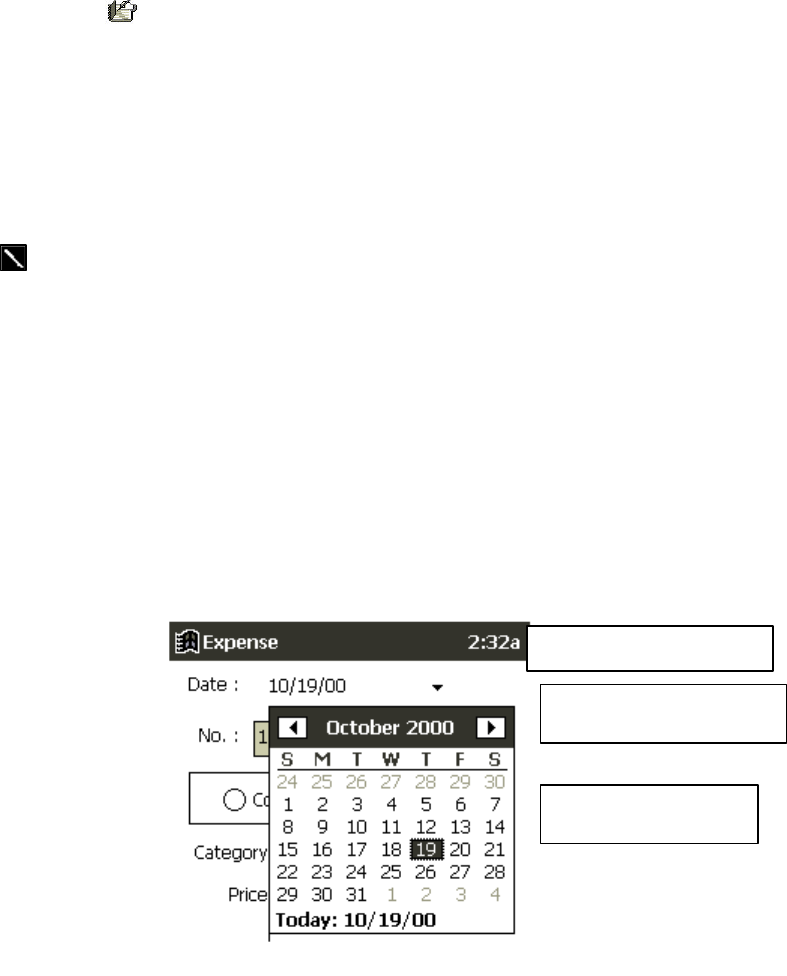
Bluebird User’s Guide 56
and then tap OK. The name of the account appears in the Account Manager with its opening
balance. The total of all balances for your accounts appears at the bottom of the screen.
Daily Account
Daily Account is a simple-to-use expenditure management program, allowing you to keep
track of your expenses on the move. It is designed so that you can quickly record details of
expenses as they occur, look up and amend old records, and, for any given month, view overall
total expenditure with category-by-category breakdowns. It even allows you to input a period of
time, and print out chronologically details of all records within that period.
Creating, Editing, and Deleting Expenditure Records
To open Daily Account tap Start, and then Daily Account on the drop-down menu.
You can create as many records as you want, up to the amount of storage capacity.
Remember, however, that the speed of HTC Expenses for Pocket PC will be affected if you
store too much information on your Pocket PC.
Creating Records
When you open Daily Account a blank record automatically appears with the day’s date and
record number. To complete the record, follow the instructions below:
1. If the record is not for today, press the downward pointed arrow next to the date. In the
pop-up calendar that appears select a month by pressing the left and right arrows and then a
day by tapping a number from the body of the calendar. To confirm the date tap outside the
calendar.
2. The number of this new record is automatically displayed so continue to the next item.
3. Tap company or personal, as appropriate.
4. Next to Category, tap the arrow and select a description from the drop-down menu.
Tap to reveal the calendar.
Tap to select the month.
Tap to select the day.
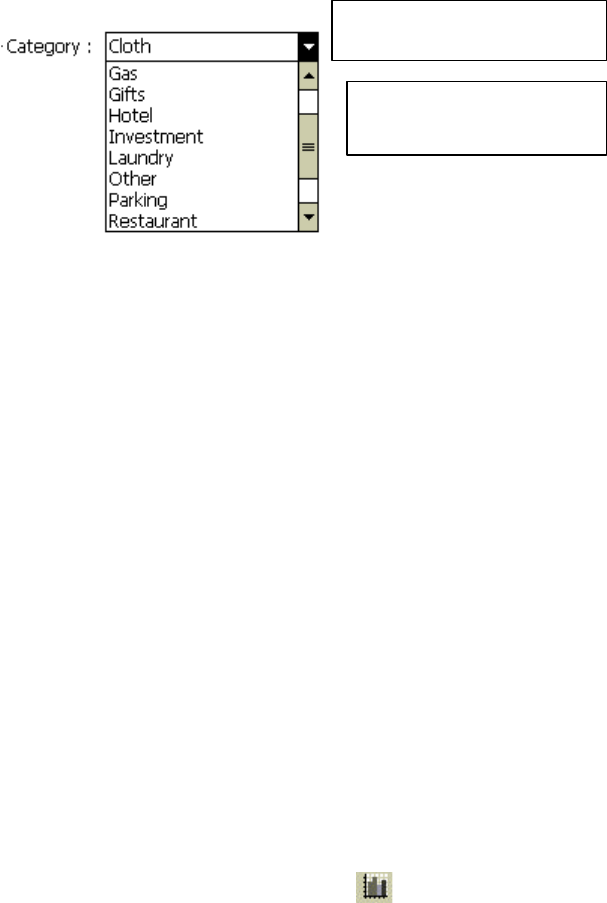
Bluebird User’s Guide 57
5. Below enter the cost of the expense – if you tap in the box the keyboard will pop-up.
6. In Details enter any additional information about the record that you think is necessary.
7. Finally, to add the record to memory, press New. Editing Records
1. Find the record by entering the date it was created, then by going to the No. and tapping the
left/right arrows to scroll through records for that date. When the record you want to edit
appears proceed to No.2.
2. To edit the record, follow the techniques explained in Creating Records , and then tap the
Update button at the bottom of the screen.
Deleting Records
1. Find the record by entering the date it was created, then by going to the No. and tapping the
left/right arrows to scroll through records for that date. (see above) When the record you
want to delete appears proceed to No.2.
2. Tap Delete at the bottom left of the screen.
Calculating and Viewing Expenditure Totals
To view the overall total expenditure for a given period, tap the icon in the toolbar at the
bottom of the screen and enter a period of time. The statistics displayed are broken down by
Category - with an overall total also given.
Tap to display the drop-
down
menu.
Select a type of expense
from the list.
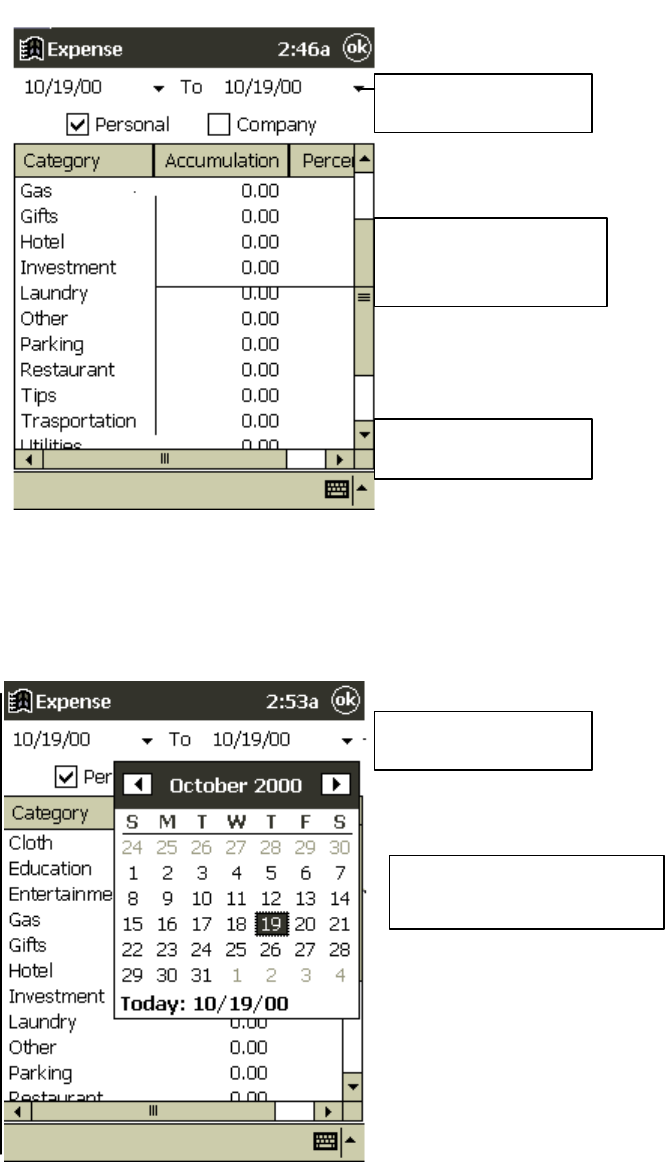
Bluebird User’s Guide 58
For statistics covering another period tap the arrow next to the date at the top of the screen, and
then in the pop-up calendar that appears select a month by pressing the left and right arrows and a
day by tapping a number from the body of the calendar. To confirm the date, tap outside the
calendar.
Tap to select a date.
Expenses broken down
by category.
Total expenses.
Tap to display the
calendar.
Select a day in the month by
tapping a number.
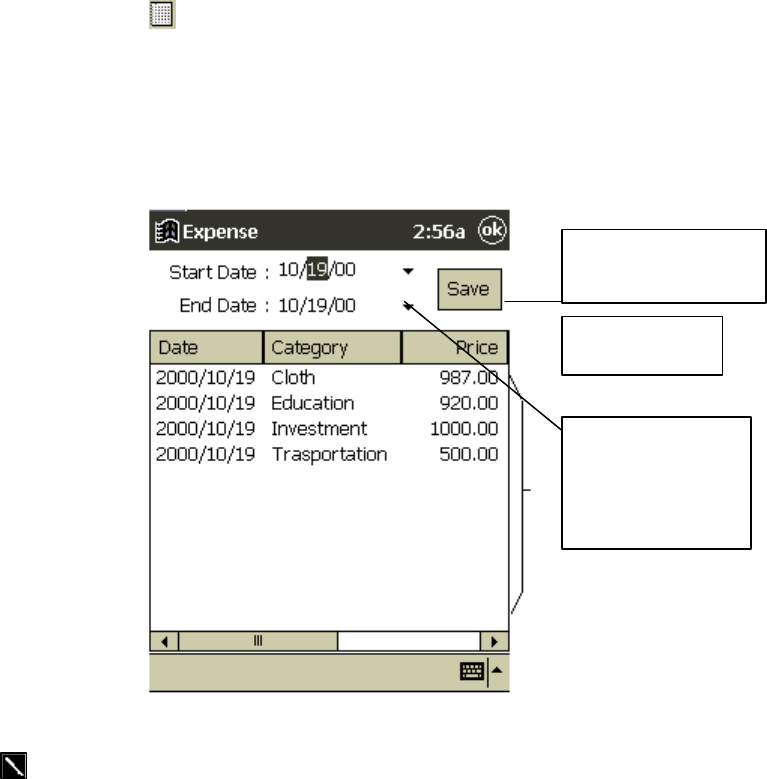
Bluebird User’s Guide 59
Printing a List of Records
1. Press the printer icon in the toolbar at the bottom of the screen.
2. At the top of the screen tap Starting Date and Ending Date to select the period within which
you want a printout of records. For this, you can select a period up to 12 months within any
year.
3. The records will be listed, starting with the earliest first.
The records are stored in a database on your Pocket PC. To print, view or manipulate
these records, they must be first converted to a text file and copied to a folder on your PC.
4. Tap Save to change the file to a text file. You will be asked if you want the file to be called
Daily Account, tap OK.
5. To copy to your PC open Windows Explorer on your PC, double click on Mobile Devices,
and then My Pocket PC.
6. Select the DailyAccount.txt file, copy and paste into My Documents on your PC.
7. In Notepad click File, and then Open from the drop-down menu. In the screen that appears
select text files from the Types of File box, double click on DailyAccount.txt and follow the
instructions that appear.
Tap to save as a text
file.
Tap to select
the date.
A list of records
for the above
specified period.
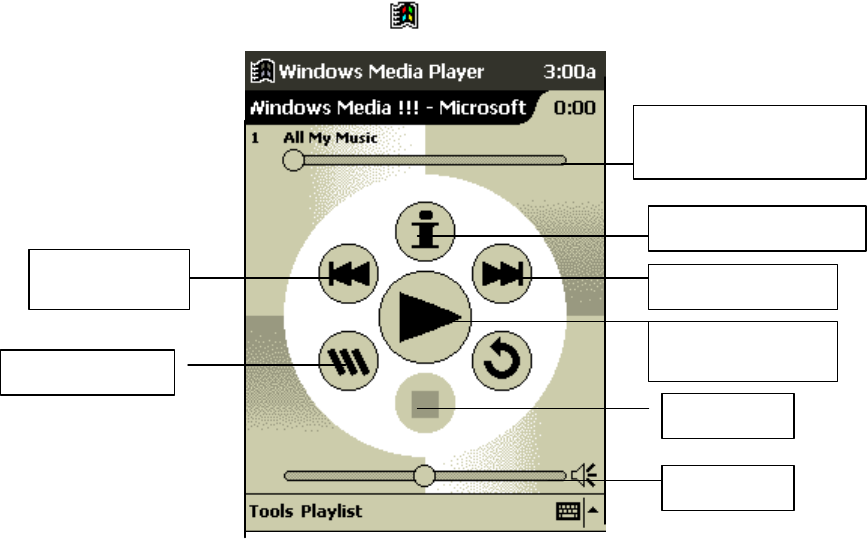
Bluebird User’s Guide 60
Windows Media Player for Pocket PC
Use Windows Media Player for Pocket PC to listen to digital audio files.
To switch to Windows Media Player, tap , Programs, and then Windows Media Player.
Using Windows Media Manager for Pocket PC
Use Windows Media Manager for Pocket PC on the desktop computer to create digital audio files
in Windows Media format and to transfer audio content to your Bluebird or storage card. With
Windows Media format, you can create high-quality audio for your Bluebird without using large
amounts of Bluebird memory.
You can transfer the following media formats to your Bluebird for use with the Windows Media
Player: ASF (Advanced Streaming Format), WMA (Windows Media Audio), MP3 (MPEG
Audio Layer 3), and WAV (waveform).
Windows Media Manager is included in the Extras folder on the ActiveSync CD. You must
install Windows Media Manager on your desktop computer to copy and convert digital audio
files.
Indicates p
rogress of the
current track.
Track information
Skip forward
Play/Pause
Stop
Volume
Skip back
Shuffle playlist
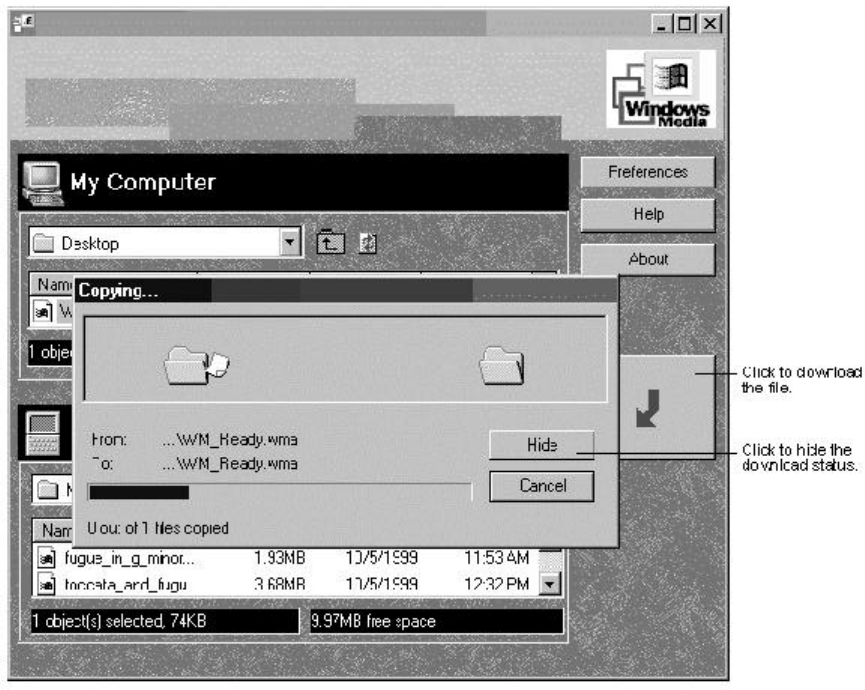
Bluebird User’s Guide 61
What is Packaged Content?
Packaged content is digital music that has been encrypted for distribution to prevent unauthorized
access to copyrighted content. Windows Media Player for Pocket PC cannot play packaged
content without a valid license. First use Windows Media Player on the desktop computer to
obtain packaged content that has a license that allows transferring the content to your Bluebird.
Then use Windows Media Manager for Pocket PC to transfer the packaged content and its license
to your Bluebird or storage card. To successfully transfer packaged content, your Bluebird or
storage card may require a hardware serial number.
You can play packaged content until the license expires. During license download, you will be
informed of the terms of the license. License terms can be for an unlimited time, a set amount of
time, or a set number of playbacks. A license can support content being copied to a Bluebird or
storage card an unlimited number of times or one time only. Terms are entirely dependent on the
content provider.
Using the Playlist Manager
Use the playlist manager to set the track playback order. All My Music is the default playlist. It
contains all digital audio files available for playback on your Bluebird and storage card. To see a
list of recently selected playlists, tap Select Playlist. To create or edit playlists, tap All Playlists.
Tap and hold a track or playlist to perform actions such as copying, moving, and deleting.

Bluebird User’s Guide 62
For more information on using Windows Media Player, tap and then Help.
Microsoft Money
Use Microsoft Money to easily enter and view your financial transactions, check your account
balances, and track your investments. If you are using Microsoft Money on your desktop
computer, you should synchronize first so that you won’t have to enter your accounts and other
required information on your Bluebird by hand. Before you can synchronize, you will need to run
the Setup program found in the MSMoney folder under Extras on the ActiveSync CD. The first
time you synchronize, all Microsoft Money information on the Bluebird will be replaced with
information from your desktop computer. If you do not use Microsoft Money on your desktop
computer, Microsoft Money on the Bluebird can still be used to help organize your finances, but
you will not be able to synchronize the financial information with your desktop computer.
Installing Microsoft Money
Microsoft Money is included in the Extras folder on the ActiveSync CD. To install Microsoft
Money on your Bluebird, go to the MSMoney folder under Extras on the ActiveSync CD, and
follow the instructions in the Read Me file.
Creating Accounts
To create a new account, tap , Programs, Microsoft Money, and then New. A screen for
entering account details with a Required and an Optional tab appears. Enter the name and type
of the account on the Required tab and the other information you want to record on the Optional
tab and then tap OK. The name of the account appears in the Account Manager with its opening
balance. The total of all balances for your accounts appears at the bottom of the screen.
Microsoft Money shows that you are in the Account Manager in the upper-left corner of the
screen. To navigate within Microsoft Money, tap the name Account Manager. A list of the five
screens within Microsoft Money appears. Tap the screen you want to see.
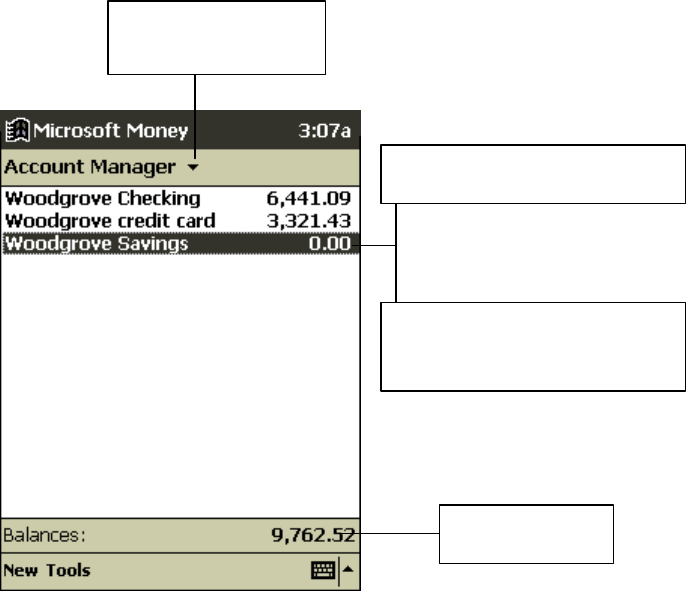
Bluebird User’s Guide 63
Using the Account Register
To view the Account Register for an account, tap it in the Account Manager. The Account
Register displays all transactions for that account that are stored on your Bluebird. For each
transaction, you will see the date, the payee, the amount, and the running balance of your account
as a result of the transaction. The ending account balance is displayed at the bottom of the screen.
Select the screen you
want displayed.
Tap to see the Account Register.
Tap to see a pop-up menu of
actions.
Balance for all
accounts.
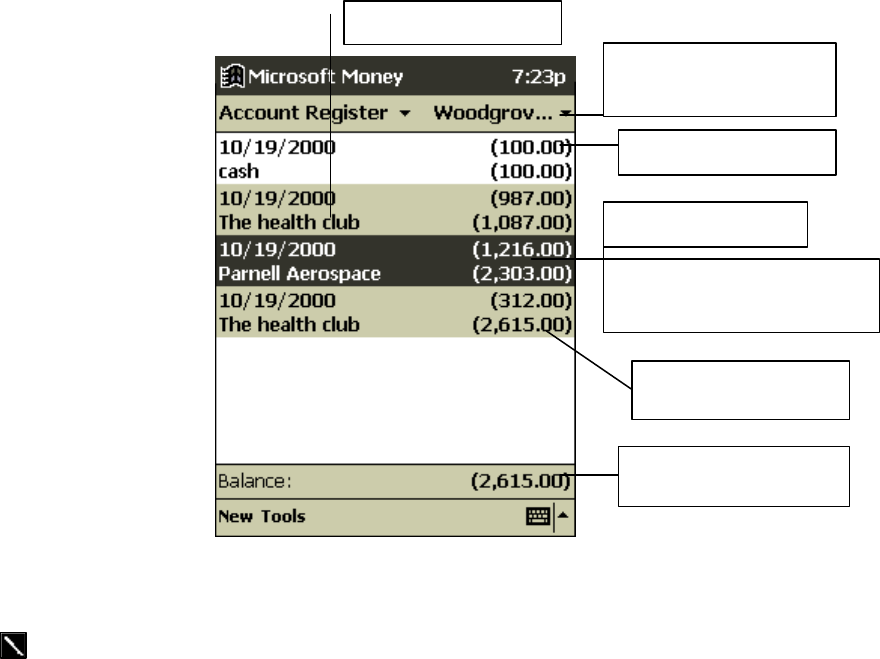
Bluebird User’s Guide 64
To switch between accounts, tap the name of the current account in the
upper-right corner and select another account from the list.
Entering Transactions
Once you have the Account Register open, tap New to create a new transaction.
On the Required tab, Microsoft Money automatically creates a withdrawal and enters today’s
date. If you are not entering a withdrawal, tap the Type box and select Deposit or Transfer. You
can also change the account in which the transaction is being created. Then, tap the Payee box.
Using the input panel, enter the payee for your transaction. As you type, Microsoft Money tries to
guess the payee that you are entering from your list of existing payees. If Microsoft Money
guesses correctly, tap another field or tap Tab to accept the payee.
When you accept a payee, Microsoft Money enters the same amount, category, and subcategory
that you used for the last transaction with that same payee. This information gets entered on the
Required tab and the Optional tab. This AutoComplete+ feature helps you quickly enter similar
transactions, such as ATM withdrawals. If AutoComplete+ has entered the wrong information,
use the input panel to correct it.
Transaction Payee
Select the account you
want displayed
Transaction amount
Tap to view details.
Tap and hold to see a pop-up
menu of actions.
Running balance for
account.
Ending balance for
account.
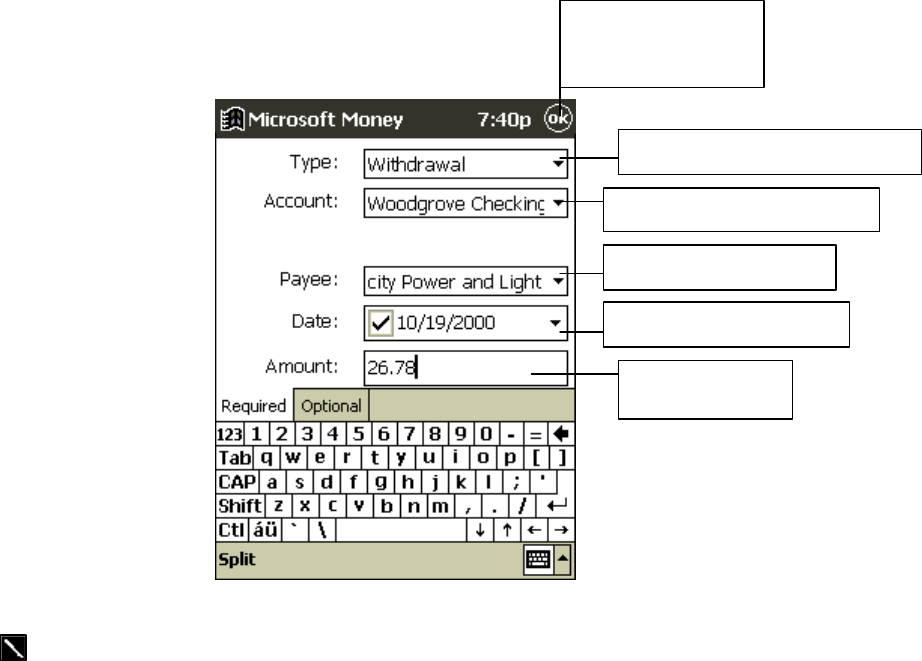
Bluebird User’s Guide 65
If you do not want Microsoft Money to automatically enter information,
tap Tools and then Options and turn off AutoComplete+.
Entering and Tracking Investments
In the Investments screen, you can track the value of the investments in your portfolio. The
Investments screen displays each investment with the current number of shares, their price, and
market value. The total market value for all of your investments is displayed at the bottom of the
screen.
To create a new investment, tap New. On the new investment screen, enter the name, symbol,
current price, and number of shares. Tap OK to save the new investment.
Microsoft Money can update investment prices from the MoneyCentral Web site. To do this,
open a connection to the Internet and tap Update Investments on the Tools menu. When the
update is complete, Microsoft Money will record the date and time and display it after Last
Quote Update at the bottom of the screen. If you do not have an Internet connection from your
Bluebird, you can manually update the investment prices by tapping the investment and entering
a new price with the input panel.
Tap to return to the
Account Register.
Tap to select the transaction type.
Tap to select another account.
Tap to enter the payee.
Tap to enter the date.
Tap to enter the
amount.
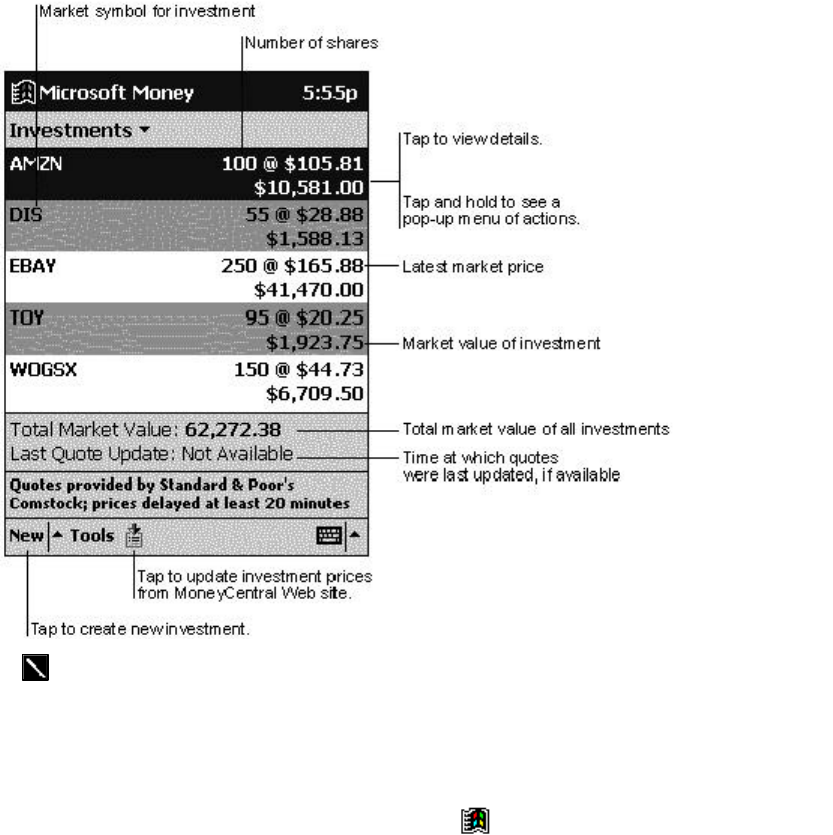
Bluebird User’s Guide 66
Microsoft Money can get a quote update over any direct (IP) Internet
connection, including a wireless connection or network connection. If
you cannot get a quote update, check with your Internet service provider
(ISP) or network administrator to see if you require a proxy server to
connect to the Internet. If so, tap Tools and then Options and set up the
proxy server.
For more information on using Microsoft Money, tap and then Help.
Microsoft Reader
Use Microsoft Reader to read electronic books on your Bluebird.
Download books to your desktop computer from your favorite eBook Web site. Then, use
ActiveSync to copy the book files to your Bluebird. The books appear in the Reader Library,
where you can tap them in the list to open them.
Each book consists of a cover page, an optional table of contents, and the pages of the book. Page
through the book by using the Up/Down control on your Bluebird or by tapping the page number
on each page. You can annotate the book with highlighting, bookmarks, notes, and drawings. You
can also search for text and look up definitions for words.
The Reader Guidebook contains all the information you'll need to use the software. To open the
Guidebook, tap Guidebook on the Reader command bar. Or, on a book page, tap the book title
and then tap Guidebook on the pop-up menu.
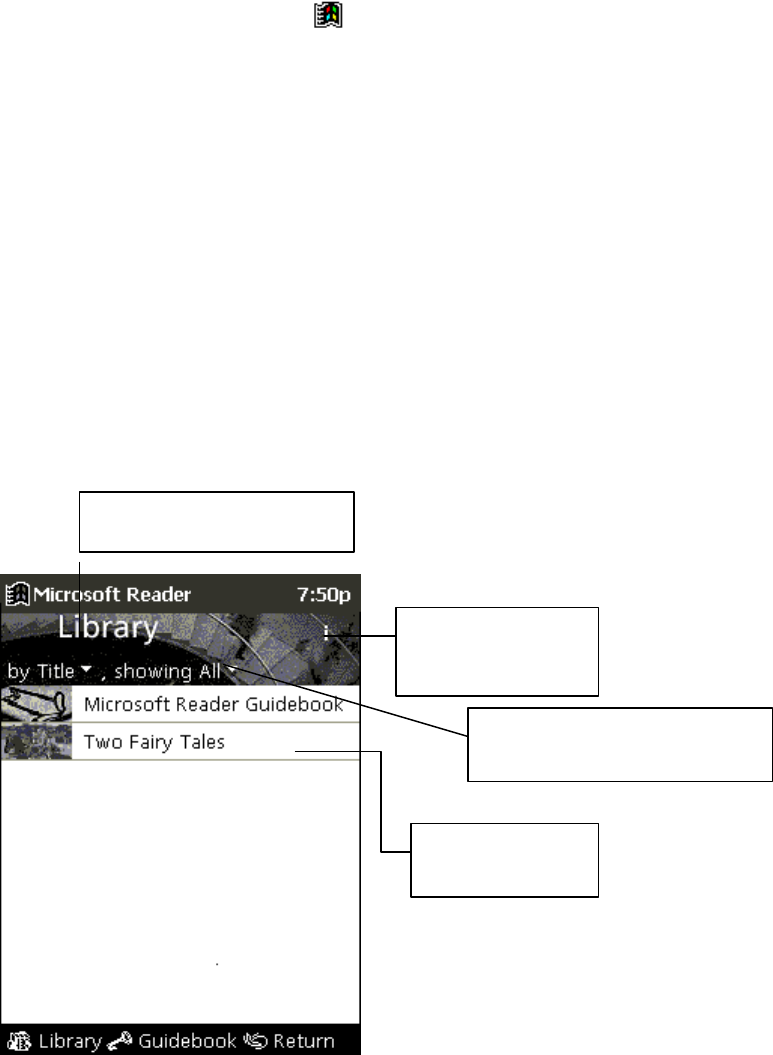
Bluebird User’s Guide 67
To switch to Microsoft Reader, tap , Programs, and then Microsoft Reader.
Getting Books on Your Device
You can download book files from the Web. Just visit your favorite eBook retailer and follow the
instructions to download the book files. Sample books and a dictionary are also included in the
MSReader folder in the Extras folder on the ActiveSync CD. Use ActiveSync to download the
files from your desktop computer to your Bluebird as described in the Read Me file in the
MSReader folder.
Using the Library
The Library is your home page; it displays a list of all books stored on your Bluebird or storage
card.
You can go to the Library by tapping Library on the Reader command bar. Or on a book page,
tap the book title and then tap Library on the pop-up menu.
To open a book, tap its title in the Library list.
Reading a Book
Each book consists of a cover page, an optional table of contents, and the pages of the book.
Navigation options are listed in the bottom portion of the cover page. The first time you open a
book, you’ll probably want to go to the first page or to the table of contents, if there is one.
Subsequently, whenever you open the book, you’ll be automatically taken to the last page read.
In addition to the text, each book page includes a page number and book title.
Tap to select a sort order.
Tap to scroll th
rough
the library list.
Tap to specify the books you
want to show.
Tap to open a
book.
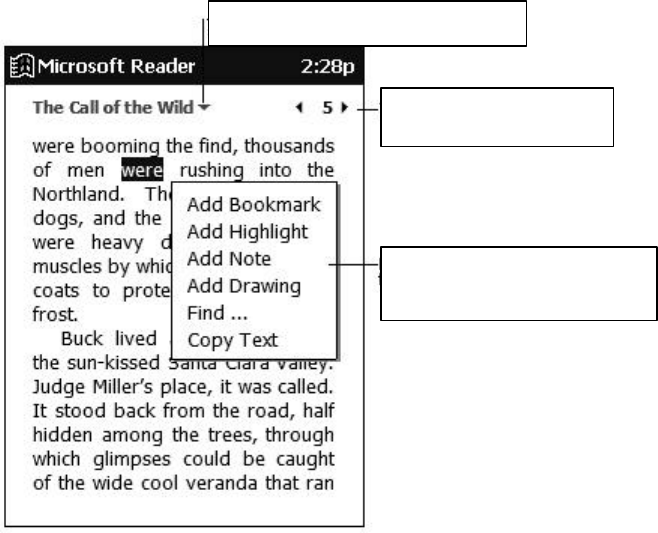
Bluebird User’s Guide 68
You can also page through a book by using the Up/Down control on your Bluebird.
Using Reader Features
Reading a book electronically gives you several options not available with paper books. These
options are available from any book page.
Select text by dragging across the text on the page. Then, tap an option on the pop-up menu, as
described here:
• Search for Text. Find text in a book by tapping Find on the pop-up menu. Change the
text that appears in the Find box, if necessary, and tap the desired Find option. The
Reader finds the text and highlights it on the page. Tap outside the Find box to close it.
To return to your original page, tap the title and then tap Return on the pop-up menu.
• Copy Text. You can copy text from a book into any program that accepts text. On a book
page, select the text you want to copy. Then, tap Copy Text on the pop-up menu. The
text you’ve copied can be pasted into the program of your choice.
• Bookmarks. When you add a bookmark to a book, a color-coded bookmark icon appears
in the right margin. You can add multiple bookmarks to a book. Then, from anywhere in
the book, you can tap the bookmark icon to go to the bookmarked page.
• Highlights. When you highlight text, it appears with a colored background, just as if you
used a marker pen.
• Notes. When you attach a note to text, you enter the text in a note pad that appears on top
of the book page. A note icon appears in the left margin. You can show or hide the note
by tapping the icon.
• Drawings. When you add a drawing, a drawing icon appears in the bottom-left corner of
the page, and drawing tools appear across the bottom of the page. Draw by dragging your
Drag to select text and then
tap an option.
Tap to turn the page.
Tap to select a navigation option.

Bluebird User’s Guide 69
stylus.
To see a list of a book’s annotations, including bookmarks,
highlights, text notes, and drawings, tap Annotations Index on the
book’s cover page. You can tap an entry in the list to go to the
annotated page.
Removing a Book
When you’ve finished reading a book, you may want to delete it to conserve space on your
Bluebird. If a copy of the book is stored on your desktop computer, you can download it again at
any time. To remove a book from your Bluebird, tap and hold the title in the Library list and then
tap Delete on the pop-up menu.

Bluebird User’s Guide 70
Chapter 6: Pocket Internet Explorer
Use Pocket Internet Explorer to view Web pages in either of these ways:
• During synchronization with your desktop computer, download your favorite links, mobile
favorites, and mobile channels that are stored in the Mobile Favorites subfolder in Internet
Explorer on the desktop computer.
• Connect to an Internet service provider (ISP) or network and browse the Web. To do this,
you’ll need to create the connection first, as described in Chapter 7.
To switch to Pocket Internet Explorer, tap and then Internet Explorer.
The Mobile Favorites Folder
Only items stored in the Mobile Favorites subfolder in the Favorites folder in Internet Explorer on
your desktop computer will be synchronized with your Bluebird. This folder was created
automatically when you installed ActiveSync.
Favorite Links
During synchronization, the list of favorite links in the Mobile Favorites folder on your desktop
computer is synchronized with Pocket Internet Explorer on your Bluebird. Both computers are
updated with changes made to either list each time you synchronize. Unless you mark the favorite
link as a mobile favorite, only the link will be downloaded to your Bluebird, and you will need to
connect to your ISP or network to view the content. For more information on synchronization, see
ActiveSync Help on the desktop computer.
Mobile Favorites
If you are using Microsoft Internet Explorer 5 on your desktop computer, you can download
mobile favorites. (You can install Microsoft Internet Explorer 5 from the Extras folder on the
ActiveSync CD.) Synchronizing mobile favorites downloads Web content to your Bluebird so
that you can view Web pages while you are disconnected from your ISP and desktop computer.
Use the Internet Explorer 5 plug-in installed with ActiveSync to create mobile favorites quickly.
To create a mobile favorite:
1. In Internet Explorer 5 on your desktop computer, click Tools and then Create Mobile
Favorite.
2. To change the link name, enter a new name in the Name box.
3. Optionally, in Update, select a desired update schedule.
4. Click OK. Internet Explorer downloads the latest version of the Web page to your desktop
computer.
5. If you want to download the pages that are linked to the mobile favorite you just created, in
Internet Explorer on the desktop computer, right-click the mobile favorite and then click

Bluebird User’s Guide 71
Properties. On the Download tab, specify the number of links deep you want to download.
To conserve device memory, only go 1 level deep.
6. Synchronize your Bluebird and desktop computer. Mobile favorites that are stored in the
Mobile Favorites folder in Internet Explorer 5 are downloaded to your Bluebird.
If you did not specify an update schedule in step 3, you will need
to manually download content to keep the information updated on
your desktop computer and device. Before synchronizing with
your Bluebird, in Internet Explorer on your desktop computer,
click Tools and then Synchronize . You will see the last time
content was downloaded to the desktop computer, and you can
manually download content if needed.
You can add a button to the Internet Explorer toolbar for creating
mobile favorites. In Internet Explorer 5 on your desktop computer,
click View, Toolbars, and then Customize.
To save Bluebird memory
Mobile favorites take up storage memory on your Bluebird. To minimize the amount of memory
used:
• In the settings for the Favorites information type in ActiveSync options, turn off pictures and
sounds or stop some mobile favorites from being downloaded to the Bluebird. For more
information, see ActiveSync Help.
• Limit the number of downloaded linked pages. In Internet Explorer on the desktop computer,
right-click the mobile favorite you want to change and then Properties. On the Download
tab, specify 0 or 1 for the number of linked pages you want to download.
Channels
Channels are Web sites designed specifically for offline viewing on your Bluebird. You can
subscribe to two types of channels at no fee: AvantGo Channels and mobile channels.
Using AvantGo Channels
AvantGo is a free interactive service that gives you access to personalized content and thousands
of popular Web sites. Unlike mobile channels, you can subscribe to AvantGo channels directly
from your Bluebird. Then, you synchronize your device and desktop computer or connect to the
Internet to download the content. For more information, visit http://avantgo.com/help.
To sign up for AvantGo:
1. In ActiveSync options on the desktop computer, turn on synchronization for the AvantGo
information type.
2. In Pocket Internet Explorer on your device, tap the Favorites button to display your list of
favorites.
3. Tap the AvantGo Channels link.
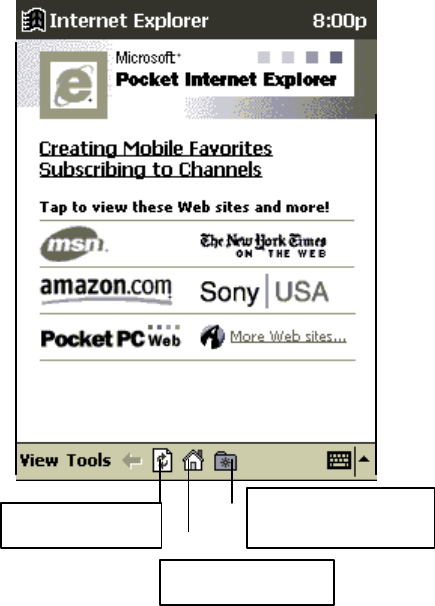
Bluebird User’s Guide 72
4. Tap the Activate button.
5. Follow the directions on the screen. You will need to synchronize your Bluebird with your
desktop computer and then tap the My Channels button to complete the AvantGo setup.
When synchronization is complete, tap the AvantGo Channels link in your list of favorites to see
a few of the most popular channels. To add or remove channels, tap the Add or Remove link.
Using Mobile Channels
Mobile channels are sites you subscribe to on your desktop computer. They are stored in the
Channels subfolder in the Mobile Favorites folder in Internet Explorer 4.0 or later and are
downloaded to your Bluebird during synchronization.
To see a list of mobile channels you can subscribe to at no fee, visit the Windows CE Mobile
Channel List Web page (http://www.microsoft.com/windowsce/channels). Click the Add Mobile
Channel button and select Make available offline to download the channel to your desktop
computer. The mobile channel will be transferred to your Bluebird the next time you synchronize.
For more information on synchronization, see ActiveSync Help on the desktop computer.
Use Pocket Internet Explorer
You can use Pocket Internet Explorer to browse mobile favorites and channels that have been
downloaded to your Bluebird without connecting to the Internet. You can also connect to the
Internet through an ISP or a network connection and browse the Web.
Favorites button
Refresh button
Home button
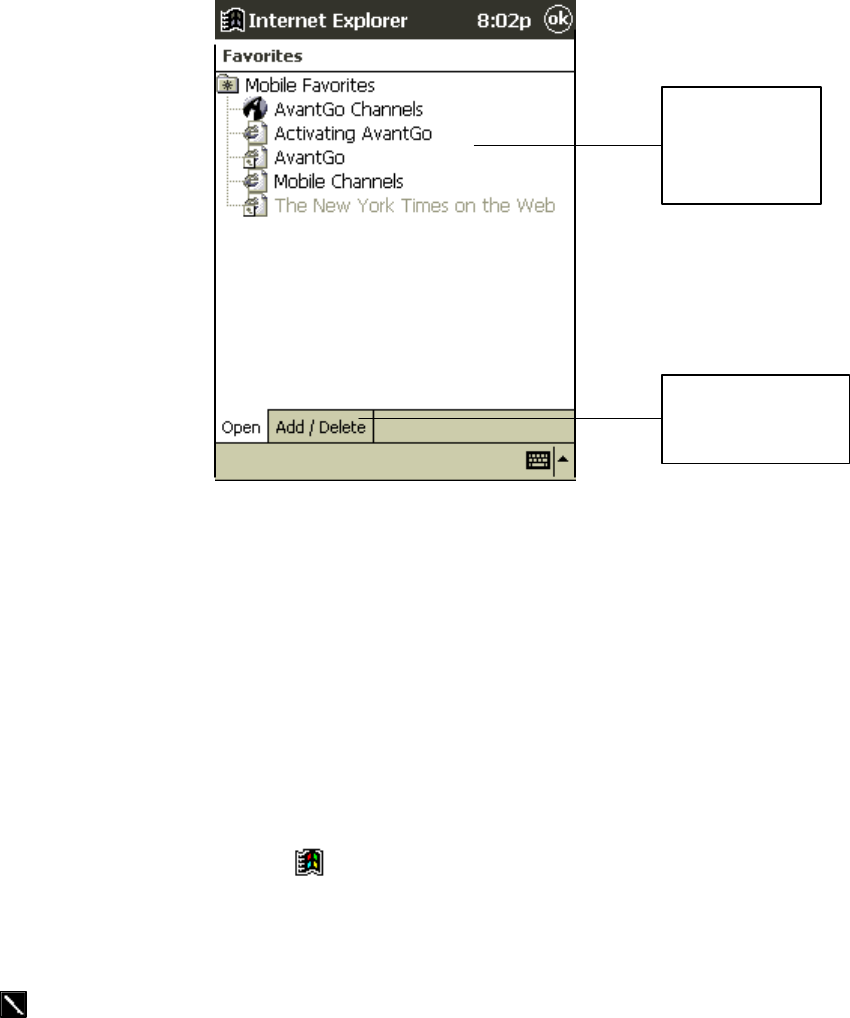
Bluebird User’s Guide 73
To view mobile favorites and channels:
1. Tap the Favorites button to display your list of favorites.
2. Tap the mobile favorite or channel you want to view.
You’ll see the page that was downloaded the last time you synchronized with your desktop
computer. If the page is not on your Bluebird, the favorite will be dimmed. You will need to
synchronize with your desktop computer again to download the page to your Bluebird or connect
to the Internet to view the page.
To browse the Web:
1. Connect to the Internet or your network in either of the following ways:
• Connect using Connections , as described in Chapter 7. Then switch to Pocket Internet
Explorer by tapping it on the menu.
• Connect in Pocket Internet Explorer. To select a service or type of connection, tap Tools
and then Options. Tap the Connections tab and select the connection type. Then,
whenever you want to connect to the selected service, tap Tools and then Connect.
You can have Pocket Internet Explorer automatically connect to
the Internet when you attempt to access a page that is not stored on
your Bluebird by specifying a connection in the Connection tab in
Options and selecting Access remote content automatically.
2. Once connected, go to a specific Web page in either of these ways:
• Tap the Favorites button and then tap the favorite you want to view.
Tap the favorite
you want to
view.
Tap to add or
delete a favorite
link.

Bluebird User’s Guide 74
• Tap View and then Address Bar. In the address bar that appears at the top of the screen,
enter the Web address you want to visit and then tap Go. Tap the arrow to choose from
previously entered addresses.
3. To end the connection, tap Tools and then Disconnect.
To add a favorite link while using the device, go to the Web page
you want to add, tap the Favorites button, tap the Add/Delete tab,
tap the Add button, and enter a name for the favorite link.

Bluebird User’s Guide 75
Chapter 7: Getting Connected
You can use your Bluebird to exchange information with other Windows-powered devices as
well as your desktop computer, a network, or the Internet. Use the infrared (IR) port on your
Bluebird to send and receive files between two devices. In addition to using a cradle, cable, or IR
port to connect your Bluebird to your desktop computer (as described in Chapter 3), you can
connect to your desktop computer while away from the office by using a remote connection. You
can also connect your Bluebird to a network or the Internet by using a remote connection. You
have the following connection options:
• Connect to your Internet service provider (ISP). Once connected, you can send and receive e-
mail messages by using Inbox and view Web pages by using Pocket Internet Explorer. If this
is the method you want to use, see “Connect to an ISP.” The communication software for
creating an ISP connection is already installed on your Bluebird. Your service provider will
provide software needed to install other services, such as paging and fax services.
• Connect to the network at your company or organization. Once connected, you can send and
receive e-mail messages by using Inbox, view Web pages by using Pocket Internet Explorer,
and synchronize with your desktop computer. If this is the method you want to use, see
“Connect to Your Network.”
• Connect to your desktop computer to synchronize remotely. Once connected, you can
synchronize information such as your Pocket Outlook data. If this is the method you want to
use, see ActiveSync Help on your desktop computer or Connections Help on the Bluebird.
Transfer Items Using Infrared
Using infrared (IR), you can send and receive information, such as contacts and appointments,
between two Windows-powered devices, and connect to the Internet through an infrared modem.
To send information:
1. Switch to the program where you created the item you want to send and locate the item in the
list. If you want to send more than one item, drag the stylus across the items you want to
send.
2. Align the IR ports so that they are unobstructed and within a close range.
3. Tap and hold the item, and tap Send via Infrared on the pop-up menu.
You can also send items, but not folders, from File Explorer. Tap
and hold the item you want to send, and then tap Send via
Infrared on the pop-up menu.
To receive information:
1. Align the IR ports so that they are unobstructed and within a close range.
2. Tap , Programs, and then Infrared Receive.
You can also receive items from Tasks, Contacts, Calendar, and
Notes by tapping Tools and then Receive via Infrared in list
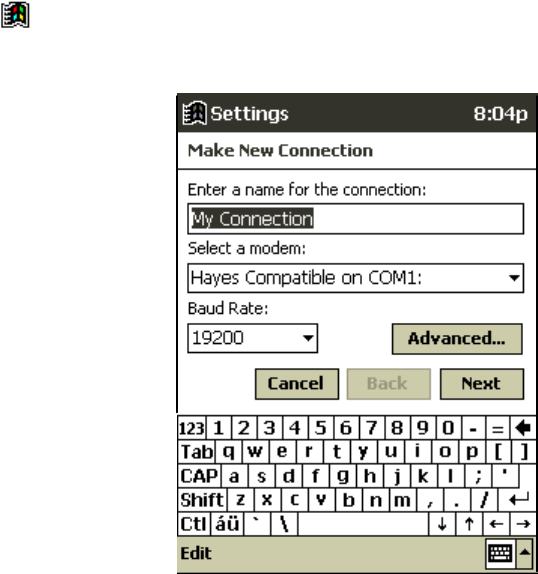
Bluebird User’s Guide 76
Notes by tapping Tools and then Receive via Infrared in list
view.
Connect to an ISP
You can connect to your ISP by creating a modem connection. Once connected, you can send and
receive e-mail messages and view Web pages.
To create a modem connection to an ISP:
Use the program Easy Online (for details see chapter 6).
Or,
1. Get the following information from your ISP: ISP dial-up access telephone number, user
name, password, and TCP/IP settings. Some ISPs require information in front of the user
name, such as MSN/username.
2. Insert a CompactFlash modem card or a PCMCIA modem card into the Bluebird Expansion
Slot and connect to a telephone line.
3. Tap and then Settings. On the Connections tab, tap Modem.
4. Tap New connection.
5. Enter a name for the connection, such as “ISP Connection.”
6. In the Select a modem list, select your modem type. If you are using an infrared modem,
select Generic IRDA modem. If you are using an external modem that is connected to your
Bluebird with a cable, select Hayes Compatible on COM1.
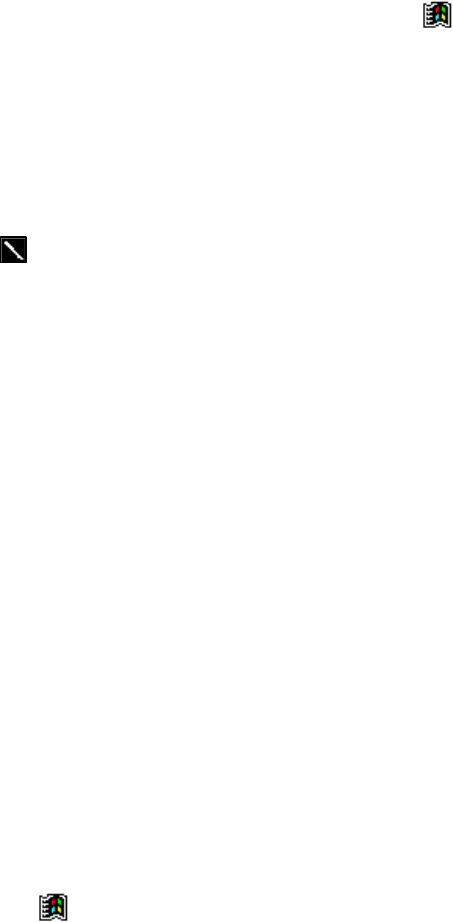
Bluebird User’s Guide 77
7. You should not need to change any settings in Advanced. Most ISPs now use a server-
assigned address. If the ISP you are connecting to does not use a server-assigned address, tap
Advanced and then the TCP/IP tab and enter the address. When finished, tap OK and then
Next.
8. Enter the access phone number, and tap Next.
9. Select other desired options, and tap Finish.
10. On the Dialing tab, specify your current location and phone type (most phone lines are tone).
These settings will apply to all connections you create.
Once you have created the connection, it appears in , Programs, Connections. To start the
connection, remove your Bluebird from the cradle, tap the connection icon, enter your user name
and password, and tap Connect. Once connected, you can:
• Send and receive e-mail messages by using Inbox. Before you can use Inbox, you need to
provide the information it needs to communicate with the e-mail server. For specific
instructions, see “Connect Directly to an E-mail Server,” later in this chapter.
• Visit Web pages by using Pocket Internet Explorer. For more information, see Chapter 6.
You can quickly return to Modem Settings to change connection
settings by tapping the Modem link at the bottom of the
Connections folder. To return to the Connections folder, tap the
Connections link.
Connect to Your Network
If you have access to a network, you can send e-mail messages, view Intranet pages, synchronize
your Bluebird, and possibly access the Internet. You can connect to your network in one of two
ways:
• Create a modem connection by using a RAS account. Before you can create this modem
connection, your network administrator will need to set up a RAS account for you. If this is
the method you want to use, see “To create a modem connection to a network.”
• Use an Ethernet card and a net tap to connect to the network. If this is the method you want to
use, see “To create an Ethernet connection to a network.”
To create a modem connection to a network:
1. Get the following information from your network administrator: dial-up access telephone
number, user name, password, domain name, and TCP/IP settings.
2. If your Bluebird does not have a built-in modem, install a modem card a NULL modem cable
and appropriate adapters to connect an external modem to your Bluebird through the serial
port.
3. Tap and then Settings. On the Connections tab, tap Modem.
4. Tap New connection.
5. Enter a name for the connection, such as “Company Connection.”
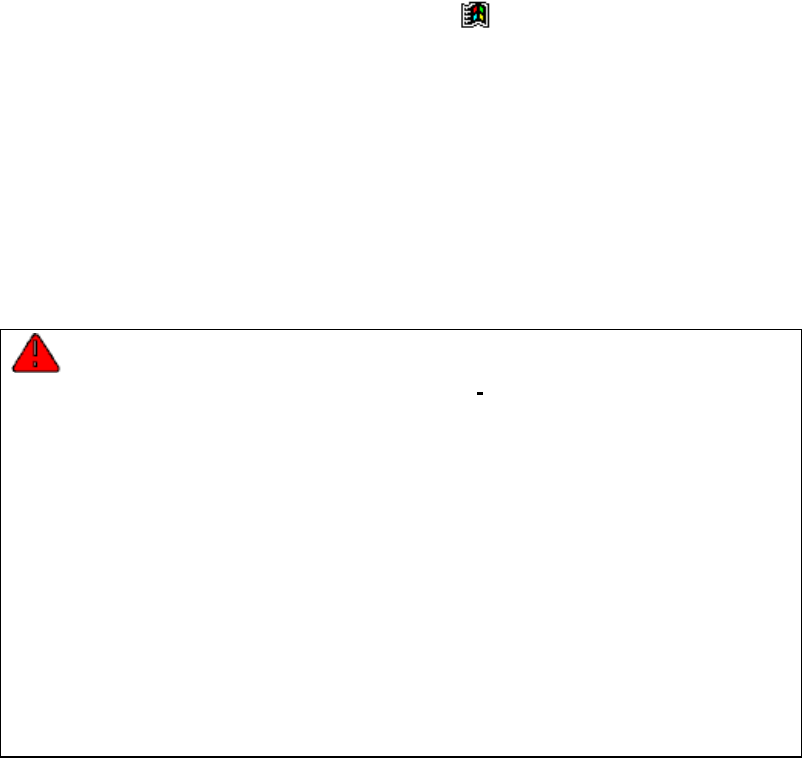
Bluebird User’s Guide 78
6. In the Select a modem list, select your modem type. If your modem type does not appear, try
reinserting the modem card. If you are using an external modem that is connected to your
Bluebird with a cable, select Hayes Compatible on COM1.
7. You should not need to change any settings in Advanced. Most servers now use a server-
assigned address. If the server you are connecting to does not use a server-assigned address,
tap Advanced and then the TCP/IP tab and enter the address. When finished, tap OK and
then Next.
8. Enter the access phone number, and tap Next.
9. Select other desired options, and tap Finish.
10. On the Dialing tab, specify your current location and phone type (most phone lines are tone).
These settings will apply to all connections you create.
Once you have created the connection, it appears in , Programs, Connections. To start the
connection, remove your Bluebird from the cradle, tap the connection icon, enter your user name,
domain, and password, and tap Connect. Once connected, you can:
• Send and receive e-mail messages by using Inbox. Before you can use Inbox, you need to
provide the information it needs to communicate with the e-mail server. For specific
instructions, see “Connect Directly to an E-mail Server,” later in this chapter.
• Visit Internet or intranet Web pages by using Pocket Internet Explorer. You may need to set
up a proxy server to visit Internet Web pages. For more information on setting up a proxy
server, see Pocket Internet Explorer Help on the Bluebird.
• Synchronize. For more information, see ActiveSync Help on the desktop computer.
Precautions for Products with Modems,
Telecommunications, or Local Area Network Options
Be sure to observe the following precautions when operating telecommunications
and network equipment. Failure to observe these precautions could result in fire,
bodily injury, and damage to the equipment.
§ Do not connect or use a modem or telephone (other than a cordless type)
during a lightning storm. There may be a remote risk of electric shock from
lightning.
§ Never connect or use a modem or telephone in a wet location.
§ Do not plug a modem or telephone cable into the Network Interface Card
(NIC) receptacle.
§ Disconnect the modem cable before opening a product enclosure, touching
or installing internal components, or touching an uninsulated modem cable
or jack.
§ Do not use a telephone line to report a gas leak while you are in the vicinity of the
leak.
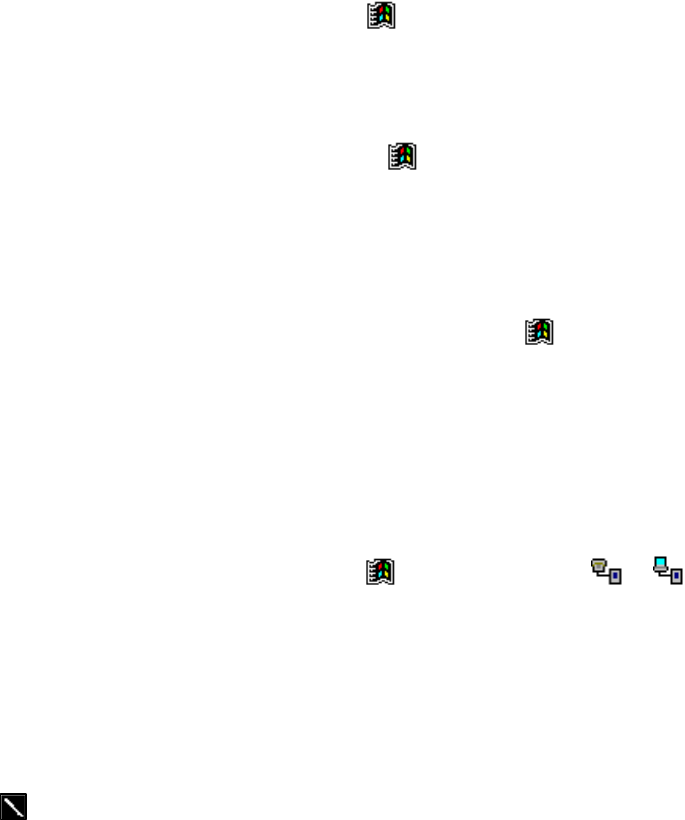
Bluebird User’s Guide 79
To create an Ethernet connection to a network:
You do not need to create a new connection on your device. Instead, you must purchase and
configure an Ethernet card that is compatible with your Bluebird.
1. Get the following information from your network administrator: user name, password, and
domain name.
2. Insert the Ethernet card into your Bluebird. For instructions on inserting and using the
Ethernet card, see the owner’s manual for the card.
3. The first time you insert the card, Network Settings will appear automatically so that you
can configure the Ethernet card. Most networks use DHCP, so you should not have to change
these settings unless your network administrator instructs you to do so. Tap OK. (If it does
not appear or to change settings later, tap and then Settings. On the Connections tab, tap
Network and then the adapter you want to change.)
4. Connect the Ethernet card to the network by using a network cable. For information, see your
owner's manual.
5. If you want to synchronize your device, tap , and then Programs. Tap the Connections
folder, and then ActiveSync. Select Network Connection as the connection method and then
tap Connect. Remote synchronization with a desktop computer will work only if you have set
up a partnership with that computer through ActiveSync and have set ActiveSync to allow
remote connections. Other restrictions apply. For more information on synchronizing
remotely, see ActiveSync Help on the desktop computer.
6. If you want to access your e-mail server or the intranet, tap and then Settings. On the
Connections tab, tap Network and then the Identification tab. Enter your user information.
If you need assistance, see your network administrator.
Once connected, you can do the same activities as listed in the preceding section.
End a Connection
If you started the connection from a program, such as Inbox or Pocket Internet Explorer,
disconnect from that program first. Then, tap and then Today. Tap or at the bottom
of the screen and then Disconnect. To end a network connection, remove the card from your
Bluebird.
Connect Directly to an E-mail Server
You can set up a connection to an e-mail server so that you can send and receive e-mail messages
by using a modem or network connection and Inbox on your Bluebird.
The ISP or network must use a POP3 or IMAP4 e-mail server and
an SMTP gateway.
Inbox does not currently support connecting with proprietary e-
mail protocols, such as AOL and MSN™. However, you can still
access the Internet through these services. There may be third-
party programs available that would enable you to send and
receive e-mail messages through proprietary protocols.

Bluebird User’s Guide 80
receive e-mail messages through proprietary protocols.
You can use multiple e-mail services to receive your messages. For each e-mail service you
intend to use, first set up and name the e-mail service. If you use the same service to connect to
different mailboxes, set up and name each mailbox connection.
To set up a e-mail service:
1. In Inbox on your Bluebird, tap Services, and then New Service.
2. Select POP3 or IMAP4 as the service type, name the service, and tap Next. For information
on which service type to select, ask your ISP or network administrator.
3. If you have created a connection you want to use, select it from the Connection list. If you
have not, select Create new connection and follow the steps in the wizard. When you return
to this screen at the end of the wizard, select the connection you created from the Connection
list.
A wizard will walk you through the remaining steps. For an explanation of a screen, tap Start and
then Help. When finished, tap Services and then Connect to connect to your e-mail server. For
more information on using the Inbox program, see “Inbox: Sending and Receiving E-mail
Messages” in Chapter 4.
Get Help on Connecting
More information on the procedures described here, as well as information on additional
procedures, can be found in the following locations:
• “Inbox: Sending and Receiving E-mail Messages” in Chapter 4.
• Online Help on the device. Tap and then Help. Tap View, All Installed Help, and then
Inbox or Connections.
• ActiveSync Help on the desktop computer. In ActiveSync, click Microsoft ActiveSync Help
on the Help menu.
• Appendix B: Troubleshooting.
Bluebird User’s Guide 81
Appendix A: Character Recognizer
Using Character Recognizer, you can write Chinese or English characters directly on your
Bluebird screen with your stylus, just as you would on a piece of paper. The characters you write
are translated into typed text. Use Character Recognizer anywhere you want to enter text, for
example, to write a note or to fill in fields in a dialog box.
The Character Recognizer input panel is divided into two writing areas. When you write in either
of these areas, both Chinese and English interpretations of the character you are writing will
appear in the top-left box. The two boxes allow you to write another character while you are
waiting for Character Recognizer to interpret the first.
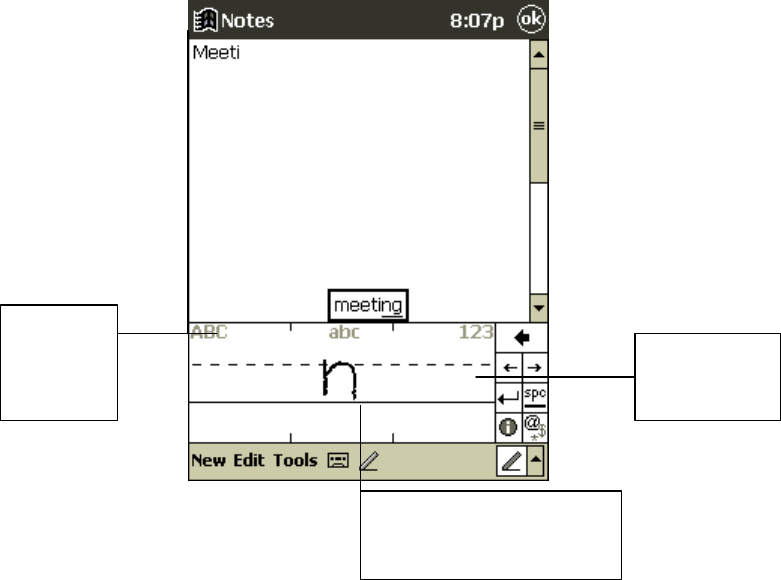
Bluebird User’s Guide 82
The letters you write are
converted to typed text on
the screen.
Write
capitals
here. Write
numbers here.

Bluebird User’s Guide 83
Appendix B: Troubleshooting
Reset the Bluebird and clear memory
To reset the Bluebird:
You can perform a soft reset or a full reset. If your Bluebird responds slowly, stops responding as
expected, or “freezes,” try soft resetting it. A soft reset causes the Bluebird to restart and re-adjust
memory allocation. Unsaved data in open windows may be lost.
• Use the stylus to press and hold the Reset button for about two seconds.
To clear memory:
If you forget your Bluebird password or want to clear all data from your Bluebird and return it to
the factory settings, clear memory.
Warning: Clearing memory deletes all data and restores the Bluebird to its default settings.
Programs installed at the factory remain, while data you have created and programs you have
installed are erased.
1. Turn the Bluebird on.
2. Press and hold the Power button, and use the stylus to press and hold the Reset button for
about two seconds.
3. If a message appears on the screen, confirm that you want to clear memory.
-or-
Remove the main and backup batteries, wait 5 minutes, and then reinsert them.
Use ActiveSync to keep a backup of your Bluebird data so that if
you need to clear memory, you can restore the data on your
Bluebird. For more information, see ActiveSync Help.
Batteries lose power
When batteries are low, you will see a battery icon in the status bar of the Today screen. Replace
or recharge low batteries as soon as possible. When main batteries are discharged, your data will
be preserved by the backup battery. If the backup battery is discharged, you run the risk of losing
the data on your Bluebird.
You want your Bluebird battery charge to last as long as possible, especially when you’re on the
road. Under normal conditions, you can get many hours of use from a single set of batteries or
from a full charge. Here are a few tips to help you get the most from them.
Use external power whenever possible
Use the AC adapter to plug your Bluebird into external power whenever possible, especially
when:
• Establishing a remote connection (some modems use a lot of power).

Bluebird User’s Guide 84
• Using the backlight feature of your Bluebird display.
• Connecting to a desktop computer.
• Letting the notification light flash for extended periods.
Shorten auto-suspend time
While on battery power, your Bluebird automatically suspends operation if you haven’t touched
the hardware buttons or used the stylus for a specified period. Maximize battery life by shortening
the time. Tap and then Settings. On the System tab, tap Power, and then adjust the On
battery power setting.
Turn off sounds you don’t need
The Bluebird produces sounds in response to a number of events, such as warnings,
appointments, and screen taps or hardware-button presses. To optimize battery life, turn off any
sounds you don’t need. Tap and then Settings. On the Personal tab, tap Sounds &
Reminders and clear check boxes on the Volume and Reminders tabs.
Turn off notification light
Tap and then Settings. On the Personal tab, tap Sounds & Reminders . On the Reminders
tab, clear the Flash light for check box.
If you forget your password
If you forget your password, you’ll need to clear memory on the Bluebird. See “Reset the device
and clear memory,” earlier in this appendix.
If you run out of Bluebird memory
Memory on your Bluebird is shared between storage memory and program memory. Storage
memory is used to store the information you create and programs you install. Program memory is
used to run programs on your Bluebird . Bluebird automatically manages the allocation between
storage and program memory. However, in some situations, such as when memory is low,
Bluebird may not be able to automatically adjust the allocation. If you receive a message stating
that storage or program memory is unavailable, try the following solutions.
Storage memory
• Move data to a storage card.
• Tap , Programs, and then File Explorer. Tap and hold the file you want to move,
and tap Cut. Browse to the My Documents folder in the storage card folder, tap Edit,
and then tap Paste. Files stored in folders other than My Documents or stored in
subfolders within subfolders in My Documents may not show up in the list view of some
programs. When using Notes, Pocket Word, or Pocket Excel, you can also move files by
opening the item and tapping Tools or Edit and then Rename/Move.
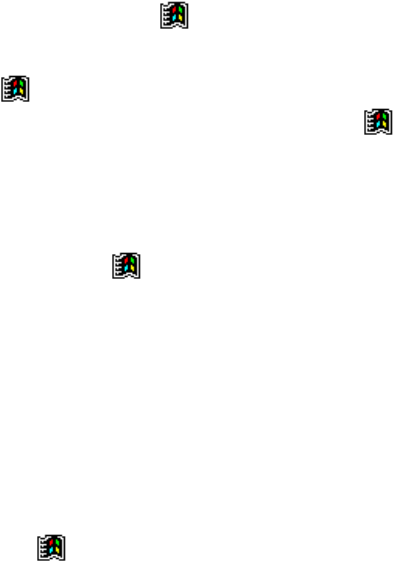
Bluebird User’s Guide 85
• Move e-mail attachments. In Inbox, tap Tools and then Options . On the Storage tab,
select Store attachments on storage card. All attachments are moved to the storage
card, and new attachments are automatically stored on the storage card.
• Set programs such as Notes, Pocket Word, and Pocket Excel to automatically save new
items on the storage card. In the program, tap Tools and then Options.
• If you are copying files from your desktop computer or another device to your Bluebird, try
adjusting the slider in the Memory setting. Tap and then Settings. On the System tab, tap
Memory and check whether the slider can be adjusted manually before copying files.
• Delete unnecessary files. Tap , Programs, and then File Explorer. Tap and hold the file,
and then tap Delete on the pop-up menu. To find your largest files, tap and then Find. In
the Type list, tap Larger than 64 KB, and then tap Go.
• In Internet Explorer options, delete all files and clear history. In Internet Explorer, tap Tools
and then Options. Tap Delete Files and Clear History.
• Remove programs you no longer use. Tap and then Settings. On the System tab, tap
Remove Programs. Tap the program you want to remove and then Remove.
• Clear program memory as described in the following section. This will free some program
memory so that it can be allocated to storage memory.
Program memory
• Stop programs you are not currently using. In most cases, programs automatically stop to free
needed memory. However, in some situations, such as when confirmation dialog boxes are
waiting for a user response, the program may not be able to automatically stop. To check the
state of your active programs, tap and then Settings. On the System tab, tap Memory and
then the Running Programs tab. Tap the program you want to view and then tap Activate.
Close any open windows or messages and return the program to list view. If this doesn’t
work, you can stop the program manually. First, make sure that your work is saved by closing
open items and returning the program to list view. Then, stop the program by tapping Stop or
Stop All on the Running Programs tab.
• Clear storage memory as described in the preceding section. This will free some storage
memory so that it can be allocated to program memory.
• Reset your Bluebird, as described in “Reset the Bluebird and clear memory,” earlier in this
appendix.
Screen freezes or responds slowly
Reset your Bluebird. See “Reset your Bluebird and clear memory,” earlier in this appendix.
Screen is blank
If your Bluebird doesn’t respond when you briefly press the Power button, press and hold the
button for a full second. If that doesn’t work:

Bluebird User’s Guide 86
• Make sure your battery cover is locked and all expansion slots are secured.
• Plug the device into AC power.
• Change or recharge the main batteries and backup battery.
• Adjust the display contrast. On some Bluebirds, the screen can darken or lighten to the point
that it appears to be powered off. .
• Reset the device. See “Reset the device and clear memory,” earlier in this appendix.
Screen is dark
Prolonged exposure to direct sunlight may cause your Bluebird screen to temporarily darken. This
is normal for LCD screens and is not permanent.
Screen is hard to read
Bluebird screens without backlighting can be hard to read under reduced light. Position a lamp so
that the light shines directly on the screen.
If you’re having a hard time viewing a document in Notes, try changing the size of the view. To
do this, tap a zoom percentage on the Tools menu. In Pocket Word and Pocket Excel, on the
View menu, tap Zoom and then select a zoom percentage. In Pocket Internet Explorer, on the
View menu, tap Text Size and then select a size.
If you’re having a hard time viewing Pocket Outlook data, try enlarging the display font. To do
this within Calendar, Tasks, or Contacts, tap Tools, then Options , and then select Use large font.
Inaccurate response to stylus taps
Adjust the touch screen to respond more accurately to screen taps. Tap and then Settings. On
the System tab, tap Align Screen. .
Slow or no response
Reset your Bluebird. See “Reset the Bluebird and clear memory,” earlier in this appendix.
Infrared (IR) connection problems
If you are unable to use IR to transfer information, try the following:
• Transfer only one file or no more than 25 contact cards at a time.
• Line up the IR ports so that they are unobstructed and within a close range
• Make sure nothing is between the two IR ports.
• Adjust the room lighting. Some types of light interfere with IR connections. Try moving to a
different location or turning off some lights.
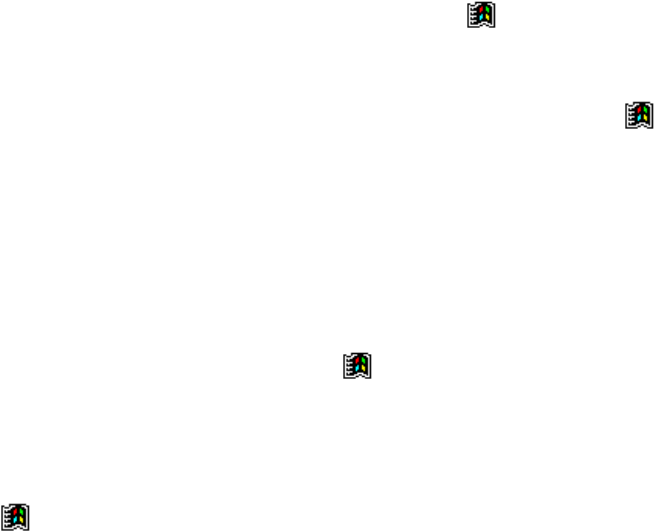
Bluebird User’s Guide 87
Modem connection problems
You may encounter the following problems when using a modem. Additional troubleshooting
information is available in Connections Help on the Bluebird and ActiveSync Help on the
desktop computer.
Can’t dial out
• Remove your Bluebird from the cradle. You cannot connect using a modem if your Bluebird
has an active connection with the desktop computer.
• Verify that the modem is firmly seated and connected to your Bluebird and the telephone
jack.
• Make sure the telephone line is analog. (Analog telephone lines transmit data in analog
instead of digital form. Your home telephone line is most likely analog, while office
telephone lines are often digital.)
• If you create a modem connection for an external modem, select Hayes Compatible on
COM1 as your modem. If you are using a modem card, select the modem card as your
modem.
• To use an external modem, you need to use a NULL modem cable and appropriate adapters
to connect the external modem to your Bluebird.
• Make sure the modem is waiting for a dial tone. Tap and then Settings. On the
Connections tab, tap Modem. Tap your connection and tap Next twice. Make sure Wait for
dial tone before dialing is selected.
• For international calls, allow more time for the call to go through. Tap and then Settings.
On the Connections tab, tap Modem. Tap your connection and tap Next twice. Clear Cancel
the call if not connected within or increase the number of seconds allowed. For information
on dialing patterns, see Connections Help on the Bluebird.
Can dial out but can’t make a proper connection
• Make sure the network to which you are trying to connect supports the Point-to-Point
Protocol (PPP). Your Internet service provider or network administrator can verify this.
• Verify that the location is correct. Tap and then Settings. On the Connections tab, tap
Modem. On the Dialing tab, make sure that Location reflects your current location. Tap
Dialing Patterns to make sure the correct sequence of numbers is being dialed. For
information on dialing patterns, see Connections Help on the Bluebird.
• Verify that you are using the right phone number for the modem you are trying to reach Tap
and then Settings. On the Connections tab, tap Modem. Tap the connection and then
Next and double-check the phone number you are trying to reach.
Connection is unreliable
• Make sure the modem is firmly seated and connected to your Bluebird and the telephone
jack.
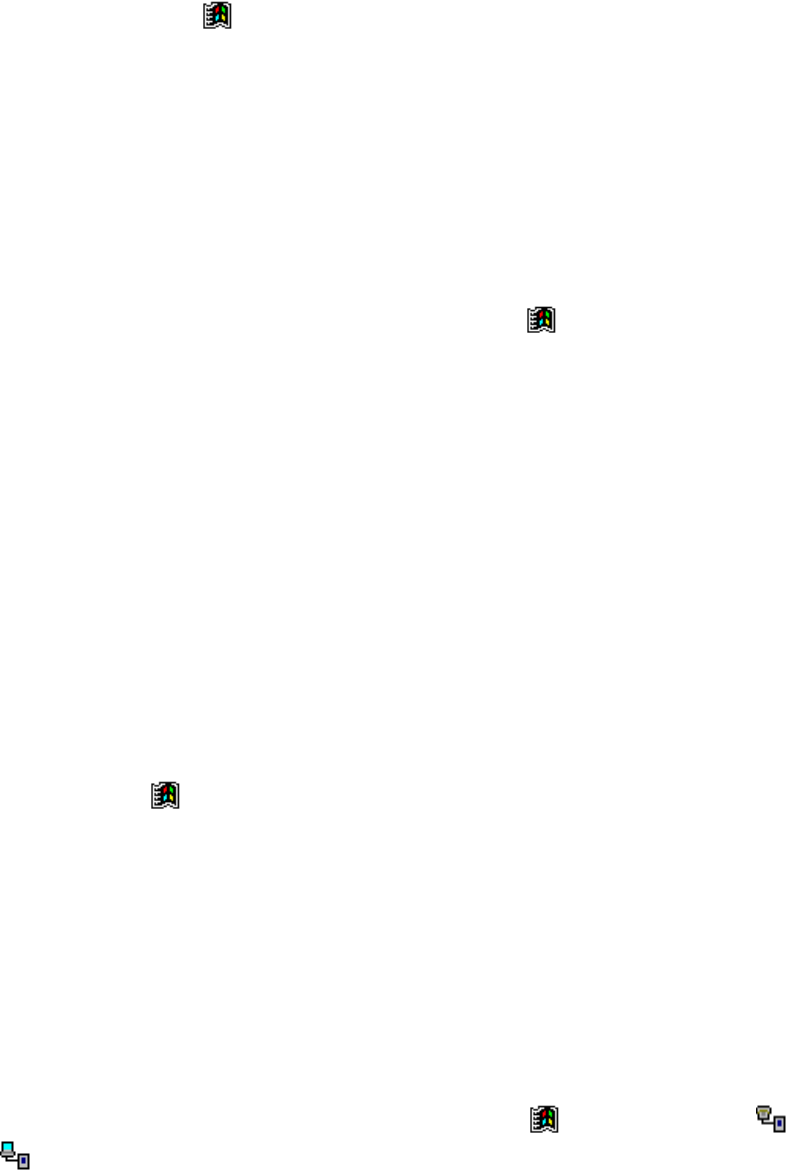
Bluebird User’s Guide 88
• Disable call waiting. Tap and then Settings. On the Connections tab, tap Mode m. On the
Dialing tab, select Disable call waiting. Then enter the disable code specified by your
telephone company.
Network connection problems
The following solutions may help if you encounter problems when using a network card for
network connections. Additional troubleshooting information is available in Connections Help on
the Bluebird and ActiveSync Help on the desktop computer.
• Verify that you have an Ethernet card that is compatible with your Bluebird.
• Verify that you have added necessary server information. Tap and then Settings. On the
Connections tab, tap Network. Tap your installed adapter (usually your Ethernet card's
name) and enter any necessary information. Most networks use DHCP, so you should not
have to change these settings unless your network administrator instructs you to do so.
• If Network Connection isn't listed as a connection method in the ActiveSync dialog box
when starting synchronization, wait a few minutes and try again. Also, if synchronization
does not start right away, the network is probably busy, and it may take a minute for your
Bluebird to connect to the network.
• Make sure that the proper drivers for your card are installed on the Bluebird. For more
information, see the owner’s manual for the network card.
• Verify with your network administrator that your user name and password are correct.
• Verify with your network administrator that the network you are trying to connect to is
available, or try to connect to it from another computer.
• You may need to change the device name if you are trying to connect to a network and
cannot because another Bluebird with the same name is already connected. To change the
Bluebird name, tap and then Settings. On the System tab, tap About, and then the Device
ID tab.
Cable and cradle connection problems
The following solutions may help if you encounter problems when connecting to your desktop
computer. Additional troubleshooting information is available in Connections Help on the
Bluebird and ActiveSync Help on the desktop computer.
• Ensure the Bluebird is turned on.
• If a modem or Ethernet card is inserted into your Bluebird, remove it.
• Ensure that you do not have any other active connections. Tap and then Today. Tap
or at the bottom of the screen and then Disconnect.
• Ensure the cable is securely plugged into the COM port on the back of your desktop
computer. Use the cable that came with the Bluebird without any extra cables or extenders
attached.
Bluebird User’s Guide 89
• Plug the other end of the cable securely into the correct port on your Bluebird. If you are
using a cradle, push your Bluebird securely into the cradle.

Bluebird User’s Guide 90
Appendix C: Regulatory Notices
Regulatory Agency Identification Numbers
For regulatory identification purposes your product is assigned a xxmodel number. The xxi
Model number for this product is xxx. This model number should not be confused with the
marketing name (xxx).
The following accessories have been evaluated for use with your device. These xx-approved
accessories can be identified by their assigned series numbers listed below. To ensure continued
reliable and safe operation of your Pocket PC, use only the accessories listed below with your
MT750.
Accessories Model Number
Pocket PC MT750*
Cradle Xxx
Rechargeable Li-Ion
battery xxx
* Intended for use with Listed Class 2, rated 5 Vdc, minimum 2A power supply unit.

Bluebird User’s Guide 91
European Union Notice
Products with CE marking comply with both the EMC Directive (89/336/EEC) and the Low
Voltage Directive (73/23/EEC) issued by the Commission of the European Community.
Compliance with these directives implies conformity to the following European Norms (in
brackets are the equivalent international standards):
EN55022 (CISPR 22) - Electromagnetic Interference
EN55024 - Electromagnetic Immunity
EN 60950 (IEC 60950) – Safety of Information Technology Equipment
Battery Warning
WARNING: Your computer contains a lithium-ion battery pack.
There is a risk of fire and burns if the battery pack is handled
improperly. Do not disassemble, crush, puncture, short external
contacts, or dispose of in fire or water. Do not attempt to open or
service the battery pack. Replace only with the battery pack
designated for this product. Dispose of batteries properly.
WARNING: Your computer contains a coin-cell lithium battery.
There is a danger of explosion and risk of personal injury if the
battery is incorrectly replaced or mistreated. Do not attempt to
recharge the battery, disassemble it, or immerse it in water or
dispose of in fire. Replace only with the battery designated for this
product. Dispose of batteries properly.

Bluebird User’s Guide 92
WARNING: To prevent fire or shock hazard, do not expose the
unit to rain or moisture.
Dangerously high voltages are present inside the unit. Do not
open the cabinet. Refer servicing to qualified personnel only.
FCC Notice
This equipment has been tested and found to comply with the limits
for a class B digital device, pursuant to Part 15 of the FCC Rules.
These limits are designed to provide reasonable protection against
harmful interference in a residential installation. This equipment
generates, uses, and can radiate radio frequency energy and, if not
installed and used in accordance with the instructions, may cause
harmful interference to radio communications. However, there is no
guarantee that interference won’t occur in a particular installation. If
this equipment does cause harmful interference to radio or television
reception, which can be determined by switching the equipment on
or off, the user is encouraged to try and correct the interference by
one or more of the following measures:
• Reorient or relocate the receiving antenna.
• Increase the separation between the equipment and the receiver.
• Connect the equipment into a circuit on an outlet different from
that to which the receiver is connected.
• Consult the dealer or an experienced radio/TV technician for
help.
You are cautioned that any changes or modifications not expressly
approved in this manual could void your authority to operate this
equipment.
Canadian RFI Statement
This class B digital apparatus meets all requirements of the Canadian
Interference-Causing Equipment regulations.
Cet appareil numerique de la classe B respecte toutes les exigences du Reglement
sur le materiel brouilleur du Canada.
Battery Disposal
Because of the type of batteries used in your Pocket PC, follow local regulations
regarding the safe disposal of batteries. Your vendor can advise you on local
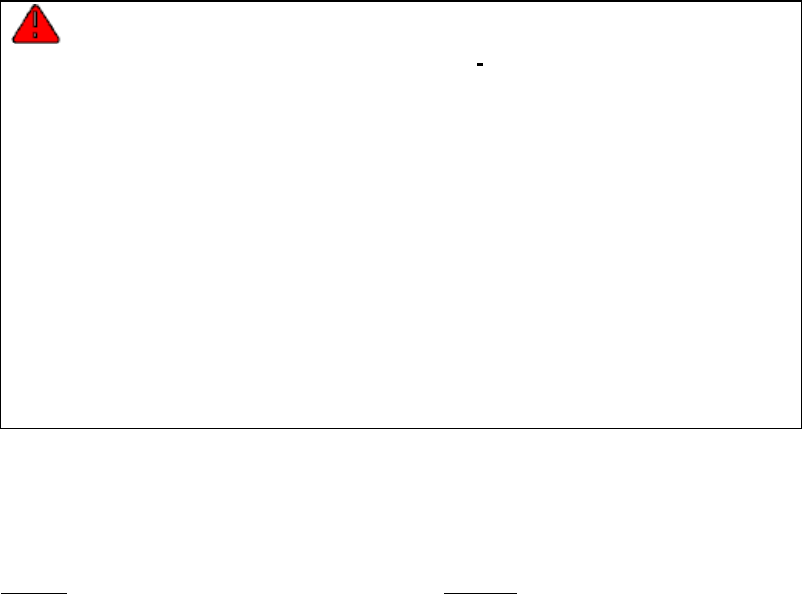
Bluebird User’s Guide 93
regulations, and/or the existence of any battery disposal programs in operation.
Batteries/battery packs and accumulators should not be disposed of together with the
general household waste. In order to forward them to recycling or proper disposal,
please use the public collection system or return them to your vendor or its agents.
Precautions for Products with Modems,
Telecommunications, or Local Area Network Options
Be sure to observe the following precautions when operating telecommunications
and network equipment. Failure to observe these precautions could result in fire,
bodily injury, and damage to the equipment.
§ Do not connect or use a modem or telephone (other than a cordless type)
during a lightning storm. There may be a remote risk of electric shock from
lightning.
§ Never connect or use a modem or telephone in a wet location.
§ Do not plug a modem or telephone cable into the Network Interface Card
(NIC) receptacle.
§ Disconnect the modem cable before opening a product enclosure, touching
or installing internal components, or touching an uninsulated modem cable
or jack.
§ Do not use a telephone line to report a gas leak while you are in the vicinity of the
leak.
Appendix D: Hardware Specifications
Feature Bluebird
Processor
Memory
Intel SA-1110 CPU
SDRAM 32MB, option 16 or 32 MB; Flash or Max
ROM: 16 MB, 24 or 32 MB; ROM 16MB
LCD module 3.8” 240x320 graphic in 0.24mm pitch QVGA;
B/W 16 gray STN Semi-Transmission
Buttons Four programmable buttons; power and East Online
button; jog wheel for scroll up, down, action; record
and Desktop button; reset button.
Stylus 95mm, maximum diameter 5mm
Notification One PDA LED for event alarm and recharge.
Audio Built-in Microphone, speaker and buzzer; one
earphone/mike jack with stereo sound; MP3 stereo
Interface Compactflash slot Type 1; feature connector (serial,
cradle, USB slave); infrared IrDA SIR x1; DC jack;
RF connector.
Power Up to 15 hours battery life; rechargeable 3.8
prismatic type battery; CR 2032 cell coin backup
battery: CR2032; AC adapter ( input 100-240Vac,
Bluebird User’s Guide 94
battery: CR2032; AC adapter ( input 100-240Vac,
0.3A, Output 5Vdc/2A); built-in charger.
Accessories AC adapter; RS232 synching cable; ear plug;
service kit; protective carry case; cradle: DC jack,
serial port, USB slave.
Docking cradle Dimension: 100(W) x 37.9(H) x 110(Thickness);
table sitting format; non foldable; DC jack; serial
cradle as default; one LED.
Appendix E: CF Cards
The following CF cards are compatible with your Bluebird:
CF Memory Card
Product name Manufacture Comment
CompactFlash 4MB(KCF004) KingMax
CompactFlash 8MB(KCF008) KingMax
CompactFlash 16MB(KCF016) KingMax
CompactFlash 32MB(KCF032) KingMax
32MB Compact Flash card SanDisk
64MB Compact Flash card SanDisk
CompactFlash 64MB Pretec
CF Modem Card
Product name Manufacture Comment
Compact Flash Modem (56k,3.3V,Pretec OEM) Pretec
Billionton 56K fax/Modem Billionton
CF LAN Card
Product name Manufacture Comment
Lower Power Ethernet (LP-E) Socket Communications
Bluebird User’s Guide 95
CF Serial I/O Card
Product name Manufacture Comment
Serial I/O Compact Flash Card Socket Communications
Bluebird User’s Guide 96